ACT Policing: Annual Report 2020-21

Contents
- 1 Chief Police Officer’s foreword
- 2 Ministerial Direction
- 3 ACT Policing at a glance
- 4 Performance analysis
- 5 Professional standards
- 6 Use of force
- 7 Staffing profile
- 8 Financials
- Appendices
- Appendix 1: Financial Statements
- Appendix 2: Statement of Performance
- Appendix 3: Number of offences reported and cleared in PROMIS case write-off module - 1 July 2014 to 30 June 2019
- Appendix 4: Offences cleared by ACT Policing in the Australian Capital Territory 2014-15 to 2018-19
- Appendix 5: Percentage of offences cleared by ACT Policing 2014-15 to 2018-19
- Appendix 6: Proceedings against offenders by ACT Policing (charges) 2014-15 to 2018-19

Artist: Anthony Bean
The connection of the circles represents collaboration and the coming together of ideas.
The Australian Federal Police acknowledges the traditional owners and custodians of country throughout Australia and acknowledges their continuing connection to land, sea and community. We pay our respects to the people, the cultures and the elders past, present and emerging.
1 Chief Police Officer’s foreword
It is my privilege to present ACT Policing’s Annual Report for 2020-21 as the Chief Police Officer for the ACT. When I commenced my policing career in ACT Policing more than 30 years ago, Canberra and ACT Policing were very different from what we see today. Despite the challenging and unprecedented times we face, my staff have remained dedicated and always committed to the safety of the ACT community. It is because of this and their hard work, that I am proud of the results we have achieved in the 2020-21 financial year.
It remains my priority to ensure that ACT Policing continues its transition to the new community-focused, Police Services Model (PSM). This model has been based on feedback received from the workforce, and indicates the importance we have placed on ensuring we continue to change to support the growing ACT community. The PSM comprises targeted investments in technology, equipment and resources to deliver a more visible, proactive and connected police service and is a long-term strategic investment in both ACT Policing and in our community.
This financial year, ACT Policing made significant progress under the PSM:
- In August 2020, the first of three Proactive Intervention and Diversion Teams (PIDT) was implemented. The team is a visible presence within the community, in line with ACT Policing’s increased focus on crime disruption, prevention, early intervention and problem solving to reduce the impact of repeat calls for services. They liaise with members of the community and third party partners to target recidivist offenders and those at risk of falling into a life of crime.
- The Operational Intelligence capability commenced in December 2020 and is a core component of the new PSM. The team provides rapid intelligence to assist with tactical decision making and situational awareness, supporting members to be more mobile and intelligence-led.
2020-21 saw a very challenging and dynamic environment for police. ACT Policing achieved 14 performance measures and 10 indicators of effectiveness and have continued to focus efforts on crime reduction, crime prevention and community engagement activities, to maintain public safety within the ACT. The following are some of the successes achieved:
- The Police, Ambulance and Clinician Early Response (PACER) capability has seen significant success since its inception. In the first 12 months, PACER teams responded to 1,249 mental health call outs, resulting in 963 patients receiving face-to-face contact. In recognition of this, the ACT Government announced additional funding in the 2020-21 budget to allow the program to expand over the next four years.
- On 23 July 2020, the Confiscation of Criminal Assets (Unexplained Wealth) Amendment Bill 2020 was passed. This introduced new abilities designed to effectively deter and disrupt serious criminal activity and provides greater scope for police to tackle crime at its source, ensuring those participating in organised crime do not profit from their illegal activities. The removal of assets limits offenders from reinvesting their money into further illicit activity, or expanding their ability to continue their criminality. This legislation has proven a useful tool in our arsenal. In August 2020, ACT Policing and NSW Police conducted a joint operation, arresting the National President of the Nomads Outlaw Motorcycle Gang and seizing more than $500,000 worth of assets.
- We have continued to target those who willfully and indiscriminately seek to bring harmful illicit drugs into the ACT community. In August 2020, ACT Policing Intelligence identified that a person was travelling to Sydney to allegedly be supplied with cocaine. At short notice, ACT Policing coordinated the arrest of the person upon their re-entry to ACT, resulting in the seizure of 308 grams of cocaine. A search warrant was executed at the person’s residence resulting in further seizures of cash and cocaine. ACT Policing’s efficient and effective work saw an alleged key member of a criminal network arrested and charged, and controlled drugs with an estimated street value of $210,000 prevented from entering circulation within the ACT community.
- ACT Policing also made a major contribution to the overt phase of AFP Special Operation Ironside, an AFP/FBI led investigation that after more than three years of innovative police work, resulted in hundreds of arrests across the globe. ACT Policing assisted their national colleagues for operations in the ACT, New South Wales and South Australia and were involved in the arrest of suspects, preparation and execution of search warrants and associated surveillance duties.
The effects of the COVID-19 pandemic have continued to be felt throughout the 2020-21 financial year. ACT Policing has continued to contribute to the whole-of-government response in the Territory, with our dedicated COVID-19 Taskforce working closely with ACT Health to respond to the changing environment. We remain thankful for the response and cooperation of our community. Despite tens of thousands of COVID-19 related interactions, the level of compliance has been high - with only a small number of interactions resulting in infringement notices or arrests.
It has again been a busy year, both professionally and personally, for all of our members and I am conscious of the increasing demands being placed upon my officers. We have adapted our processes to ensure that both officers and the community they interact with remain safe and that the health and welfare of the community we serve is at the forefront of our considerations and response. The resilience of the ACT community over the last 12 months has been exceptional. Despite COVID-19 again looking to influence the next financial year, ACT Policing is well-prepared and will continue to work with our community to keep us all safe.
I thank ACT Policing officers for their ongoing dedication and professionalism, the ACT Government for their continued support, and our partner agencies for working with us to ensure the safety of the community.
2 Ministerial Direction
Minister for Police and Emergency Services Ministerial Direction
This Direction is issued under section 7 of the Policing Arrangement between the Commonwealth and Australian Capital Territory (ACT) Governments and outlines the government’s priorities and expectations for the Australian Federal Police (AFP) and more specifically the Chief Police Officer for the ACT (CPO). This Direction is to be read in conjunction with the 2017 to 2021 Purchase Agreement between the ACT Minister for Police and Emergency Services, the AFP Commissioner and the CPO. It supersedes and revokes the Direction issued on 10 July 2017.
My primary expectation is that ACT Policing will continue to provide a professional, effective and efficient policing service to the ACT community. This should be achieved through evidence-based and innovative strategies to meet the outcomes of the 2017 to 2021 Purchase Agreement to reduce crime, increase public safety and engage with community and partners locally and nationally.
Through collaborative work with the government and other stakeholders, I expect ACT Policing to play a key role in implementing ACT Government initiatives that improve community safety; reduce harm and trauma; and help prevent, divert and improve outcomes for those in contact with the justice system. This includes being transparent and responsive, as well as working with partner agencies on holistic approaches to complex social issues and providing policing and law enforcement advice to inform government decision making.
In this context, the ACT Government expects ACT Policing will give special focus to the following priorities:
Transitioning to a new policing service model that sees ACT Policing evolving in line with population growth and community expectations by providing a proactive, community focused policing service, centred on the disruption and prevention of crime.
In support of government’s overall efforts to reduce recidivism by 25 per cent by 2025, increase early intervention and diversion strategies and continue to work with the Aboriginal and Torres Strait Islander community to identify ways to reduce the over-representation of Aboriginal and Torres Strait Islander people in the criminal justice system.
Contribute to Canberra as a restorative city and continue to improve responses to vulnerable groups including Aboriginal and Torres Strait Islander people, young people, people experiencing mental health issues, people with a disability, culturally and linguistically diverse people and victims of crime.
Strengthening the ACT’s response to domestic and family violence in appropriate and culturally sensitive ways and supporting the efforts of the Coordinator-General for Family Safety.
Working proactively and innovatively with government to reduce and prevent alcoholfueled violence, including enforcing liquor laws, maintaining a presence in night entertainment precincts and responding to alcohol related violent incidents.
Improving road safety, with emphasis on reducing road trauma experienced by vulnerable road users and combating anti-social and dangerous behaviours including speeding, driving while impaired or distracted.
Disrupting serious and organised crime, including criminal gangs, drug trafficking and supply; and economic disruption to target the proceeds of crime, in addition to working with the government to identify and implement legislative measures to target serious and organised crime.
Drug harm minimisation by continuing to focus on diverting lower-level drug offenders from the criminal justice process in accordance with the National Drug Strategy and the government’s policy settings such as the ACT Drug Strategy Action Plan.
Countering the threat of terrorism and violent extremism by continuing to strengthen the safety of the ACT’s public places in line with national strategies and best practice; and developing a fixated threat capability to meet the government’s obligations under the October 2017 Council of Australian Governments agreement.
I encourage ACT Policing to maintain a diverse and inclusive workforce that is committed to the well-being and health of its people so that it can continue to deliver a professional, innovative and effective policing service in a dynamic environment for the ACT community. This will include enhanced digital engagement to ensure ACT Policing continues to evolve in line with community expectations. In support of this, I will continue to work with ACT Policing, the Justice and Community Safety Directorate and the community to support a smooth transition to a new policing service model that will see more police working in a more connected and effective way to disrupt and prevent crime.
Mick Gentleman, MLA
Minister for Police and Emergency Services
28 October 2021
3 ACT Policing at a Glance
- Our Role
- Our Mission
- Our Governance
- Our Intent
- Our Values
- Our Budget
- Our Approach
- Our Performance
- Our Challenges
- Our People
- Our Future
Our Role
Through a Purchase Agreement with the Australian Federal Police (AFP), ACT Policing is responsible for providing quality and effective policing services to the people of the Australian Capital Territory (ACT). We do this in partnership with the community and the ACT Government.
Our Mission
Our mission is to keep the peace and preserve public safety within the ACT.
Our Governance
The key documents which govern the delivery of policing services to the ACT are the Policing Arrangement, Purchase Agreement and Ministerial Direction.
Policing Arrangement
The AFP is a statutory authority established by the Federal Parliament under the Australian Federal Police Act 1979. The AFP delivers policing services to the ACT as a separate outcome under a contractual arrangement between the Commonwealth and the ACT governments.
Purchase Agreement
The Policing Arrangement provides for the negotiation of a Purchase Agreement between the AFP and the ACT Government. The Agreement details the outputs, performance measures, targets, facilities and outcomes to be provided, as well as the powers and obligations of the Minister for Police and Emergency Services, and the Chief Police Officer of the ACT, along with associated administrative arrangements.
The Purchase Agreement defines the three main outcomes against which ACT Policing’s performance is measured:
- Reduce Crime
- Public Safety
- Community and Partner Engagement.
Ministerial Direction
The Ministerial Direction outlines the ACT Government’s priorities for, and expectations of, the Australian Federal Police and the Chief Police Officer of the ACT (see Chapter 2: Ministerial Direction).
Further details of the Policing Arrangement, the Purchase Agreement and the Ministerial Direction are available via ACT Policing’s website at: https://www.police.act.gov.au/aboutus/governmentdirections.
Our Intent
We strive to deliver a professional, innovative and effective policing service in an everchanging environment for the ACT community.
Our Values
We pride ourselves on being a valuesdriven organisation. Our core values of integrity, commitment, excellence, accountability, fairness, respect and trust represent our principles and standards — the values we uphold in performing our professional duties.
Our Budget
Under the Purchase Agreement, the funding provided by the ACT Government to the AFP for delivery of policing services in 2020-21 was $179.888 million.
The total price includes enabling costs and direct funding from the Justice and Community Safety Directorate (JaCS) for crime prevention initiatives (see Chapter 8: Financial Management Reporting).
Our Approach
Our approach is underpinned by a series of strategies and initiatives that support the outcomes set out in the Performance Measure Framework:
Reduce Crime
- Continued support against the ACT Property Crime Prevention Strategy, by promoting innovative and enduring crime prevention strategies and reducing the opportunities for crime to occur or reoccur.
- Enhancing our response to and the investigation of offences by forging strong relationships with stakeholders to facilitate whole-of-government and cross-jurisdictional information sharing and collaboration.
- Applying technology and forensic science capabilities and effectively using intelligence from a wide range of sources.
- Providing effective and efficient support to the judicial process by maintaining a robust partnership with the ACT Director of Public Prosecutions and delivering high standard briefs in a timely manner.
- Facilitating a more efficient criminal justice system with an emphasis on timely preventive justice measures and judicial processes.
Public Safety
- Increasing community trust and confidence in police by communicating in innovative ways with the community, maintaining a social media presence and collaborating with partner agencies, business and community groups to support community events.
- Increasing support for early intervention and diversion by working with partner agencies and community groups to prevent and reduce recidivism.
- Continuing support and delivery in line with the ACT Aboriginal and Torres Strait Islander Agreement 2019-2028 to prevent and reduce the number of Aboriginal and Torres Strait Islander people coming into contact with the criminal justice system.
- Supporting the National Plan to Reduce Violence against Women and their Children 2010-2022 and further initiatives that deter, detect and prevent violence against women and children.
- Enhancing and strengthening the resilience of communities through safety and security initiatives and building relationships with vulnerable community groups.
Our Performance
ACT Policing’s performance is measured by the Performance Measure Framework, which incorporates three major outcomes and a series of strategies, initiatives and targets, as articulated in the 2017-21 Purchase Agreement.
The overarching budgetary outcome of the Purchase Agreement is to work in partnership with the community, to create a safer and more secure ACT through the provision of quality policing services. The Performance Measure Framework aims to enhance accountability for the delivery of services, and provide clear links between ACT Policing’s outcomes, outputs, strategies and individual measures.
ACT Policing’s three outcomes (Reduce Crime, Public Safety, Community and Partner Engagement) are supported by 21 Performances Measures and 17 Indicators of Effectiveness. During 2020-21, the Minister for Police and Emergency Services endorsed the removal of Performance Measures 11 and 12 and Indicator of Effectiveness G(ii) due to reporting limitations. For the 2020-21 financial year, there were 19 Performance Measures and 16 Indicators of Effectiveness that could be reported against.
Additional information and results on Performance Measures and the Indicators of Effectiveness are further described in Chapter 4: Performance Analysis.
Our Challenges
Major challenges and demands presented to ACT Policing during 2020-21 included:
- Evolving COVID-19 environment: Continually adapting to the changing police role and supporting the community, to ensure their safety during the COVID-19 pandemic.
- Crime and recidivism: The targeting of recidivism through early intervention and community engagement, in an overall approach to reduce crime in the ACT.
- Family violence: Taking a collaborative approach with the ACT Government and our partner agencies to combat family violence and strengthen the support services available to victims.
- Serious and organised crime: The prevention and disruption of serious and organised crime through targeting, disrupting and apprehending members of criminal gangs and seizing associated wealth derived from criminal activity, particularly during Operation Ironside.
- Reducing the over-representation of Aboriginal and Torres Strait Islander peoples in the justice system: Ongoing engagement with the local Aboriginal and Torres Strait Islander community to further develop solid, trusting relationships through open dialogue, enhancing our understanding of the challenges faced by Aboriginal and Torres Strait Islander peoples.
- Ensuring safety of ACT Policing members: Increasing the protection for ACT Policing members who are regularly exposed to a risk of assault and/or injury while on duty.
- Increased demand: In the last five years there has been a 19 per cent increase in critical and time-sensitive calls requiring urgent police attendance, increasing the demand on policing services.
- Mental health and well-being of our members: Increasing access to support services to ensure the health and well-being of members across ACT Policing.
- Preparing ACT Policing for the future: In order to address the needs of the growing ACT community, we are transitioning to a more community focused model of police service, to meet the current and long-term needs of the ACT community.
Our People
The Chief Police Officer (CPO) is accountable to the ACT Minister for Police and Emergency Services for the achievements and outcomes set out in the Purchase Agreement and Ministerial Direction.
The CPO is also responsible for the management of personnel and resources used to deliver police services to the ACT community. In 2020-21, the CPO was supported by three functional streams: Capability and Community Safety, Response and Corporate Services.
Information about ACT Policing personnel can be found at Chapter 7: Staffing Profile.
FIGURE 3.1: ACT POLICING ORGANISATIONAL STRUCTURE AS AT 30 JUNE 2021
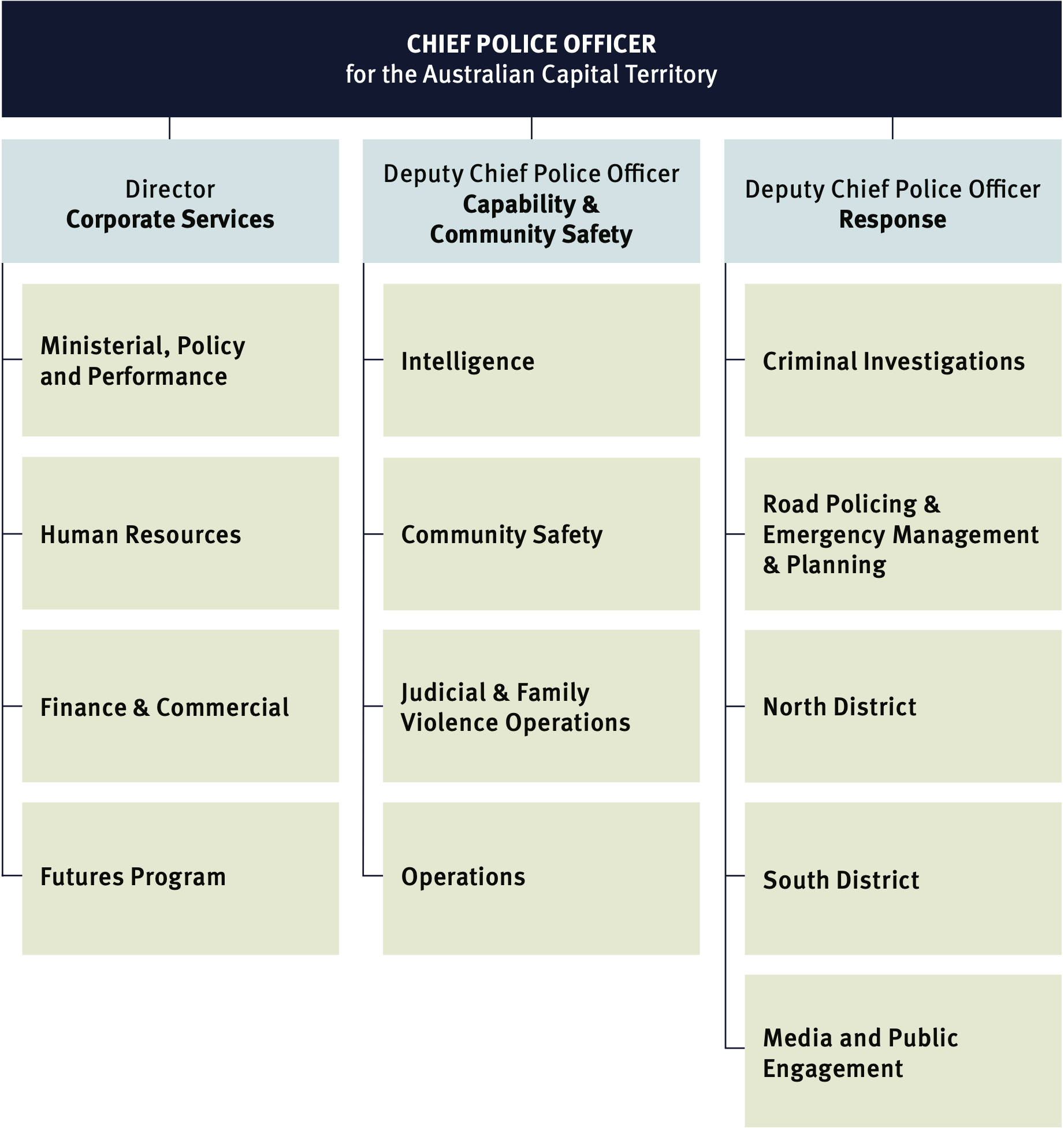
FIGURE 3.2: ACT POLICING PATROL ZONE AS AT 30 JUNE 2021
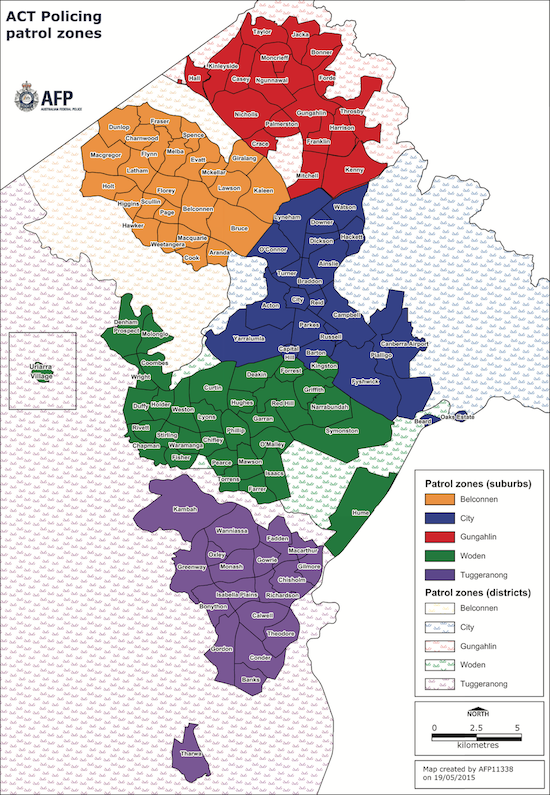
Our Future
At ACT Policing, we are working to evolve with our increasingly dynamic and diverse community to create an eversafer Canberra.
The ACT Policing Futures Program was established in 2017 and ensures that ACT Policing is ready to deliver a sustainable, efficient and effective policing service to meet the current and long-term needs of the ACT community.
The new Police Services Model (PSM) was funded with a significant $33.9m investment by the ACT Government over four years, with the 2019-20 financial year being year one. The model supports ACT Policing to target resources where they are most effective, conduct focused crime prevention activities and build a more effective justice system that is focused on addressing the root causes of crime.
To date, 32 projects have been identified under the four pillars of the PSM, to be rolled out over the next four years through:
- Systematic Approach - Collaborate with government agencies to share information and identify intervention opportunities. Members will be supported by more effective processes and will see greater collaboration with other agencies.
- Intelligence Led - Using intelligence to inform systematic decision making at both the tactical and strategic levels. Members will have access to the right information to most effectively complete a job and prevent crime.
- Evidence-Based - Generate and use data, research and evidence to inform and challenge policing practices and decisions. Members will have access to the right training and the right technology to inform evidence-based policing practices and decision making.
- Mobility Driven - Increasing responsiveness and efficiency through technology, governance and processes. Better systems will ensure members can spend more time in the field, while demand rostering will allow effort to be put where it is most needed.
Some of the projects commenced during the 2020-21 financial year and projected for the 2021-22 financial year under the Futures Program include:
- Initial research and development for a new Evidence Based Policing Team has commenced.
- Development has continued on an all-new online reporting portal where the Canberra community can report non-urgent crime and access other police services 24/7. The portal will be available in 2021-22.
- The second PIDT will commence in February 2022.
Case study
Operational Intelligence team efficiently getting results
ACT Policing launched the Operational Intelligence team in late July 2020 to help better understand crime occurring in the community and proactively use all resources to assist. In late 2020, a person called the Lifeline mental health hotline with suicidal ideations. Lifeline kept speaking to the person while informing ACT Policing in the background, and the matter was immediately referred through to the Operational Intelligence Team.
While Lifeline was only able to provide a name, the Operational Intelligence Team was able to find the person and their phone number on social media and passed this information to the ACT Operations Duty Operations Manager, who requested the telecommunications provider perform a trace on the phone. After this information was cross referenced with the location information provided by the provider, the Operational Intelligence Team was able to locate the person at their home.
This information was then passed onto a General Duties patrol over the radio who quickly attended the address with members from the PACER capability. This targeted information meant patrols could attend the exact address where the person was located.
Previously, it would have taken General Duties members several hours to gather information like this. Using a range of internal and external intelligence holdings and software, the Operational Intelligence Team are able to provide real-time information, research and intelligence, allowing members of ACT Policing to be more mobile, intelligence-led and safer.
Case study
Police, Ambulance and Clinician Early Response (PACER): A multi-disciplinary patient-centred approach to mental health crises
Police, Ambulance and Clinician Early Response (PACER): A multi-disciplinary patient-centred approach to mental health crises The demand on police, ambulance and emergency departments relating to crisis mental health presentations is significant.
Prior to the commencement of PACER, there were 2,059 emergency apprehensions enacted by police and ambulance paramedics in the ACT during the 2018-19 financial year, with the majority resulting in the patient being transported to hospital for mental health assessment.
This apprehension, transport and assessment process required significant emergency service and emergency department resources, and was often extremely distressing for the patient.
The introduction of PACER supports a joint response to incidents where mental health is thought to be a factor. The tri-service agency response platform consists of police, paramedics and mental health clinicians working collaboratively to respond to acute mental health crises in the community and is the first of its kind in Australia.
Launched in December 2019, it provides a frontline, first-response capability to mental health incidents and provides in-situ professional community safety, mental and physical health assessment, treatment and care. Its success led to the ACT Government announcing additional funding in the 2020-21 budget to extend and expand the program over the next four years.
In order to provide this service to the community, ACT Policing assisted in developing innovative training to ensure skill sets work in a complementary fashion. To date, the total number of trained PACER first responders across the three agencies is 29, with 10 of those being ACT Policing personnel.
Responding to mental health incidents is one of the most regular jobs police attend. In the first 12 months of operation, PACER teams responded to 1,249 mental health call-outs which resulted in 963 patients receiving face-to-face contact, enabling patients to remain in the community.
Overall, PACER has resulted in fewer involuntary apprehensions/presentations to hospital and an increase in the number of people getting the help they need on the front line.
4 Performance Analysis
COMMUNITY POLICING
- 4,260 arrests made
- 2,857 family violence incidents attended
- 1,770 summons
- 914 intoxicated persons lodged in protective custody
- 390 cautions issued
INTERVENTION
- 5,802 referrals to community support agencies
- 849 drug seizures
- 158 people diverted into Early Intervention and Drug Diversion Program
- 81 number of diversionary conferences
ORDERS AND BRIEFS
- 1,247 Family Violence Orders
- 953 Personal Protection Orders
- 1,131 hearing briefs delivered to DPP
MEDIA
- 1,408 media enquiry responses provided
- 529 media releases issued
ACT POLICING WEBSITE
- 420,300 unique page views for police.act.gov.au
- 1.591M unique page views for policenews.act.gov.au
- 2,696 Media subscribers
- 1,253 News subscribers
- 1,464 Community blog subscribers
SOCIAL MEDIA
- 138,000 followers on Facebook
- 67,021 followers on all Twitter channels (ACT Policing, CKK, CPO ACT, ACT_Pol Traffic)
- 18,754 Instagram followers
- 39.795M impressions on Facebook
- 6.582M impressions on all Twitter channels
CONSTABLE KENNY KOALA PROGRAM
- 644* classrooms visited
- 14,803* students visited
- 1* community events attended
- 312,214 unique page views for Constable Kenny website
*The Constable Kenny Program was suspended in March 2020 to January 2021 due to COVID-19 which has significantly reduced outreach activities for the financial year.
Note: Impressions are the number of times a post from your page is displayed, no matter if it was clicked on/engaged with or not. For example, if someone sees a page update in their Facebook newsfeed and then sees that same update when a friend shares it that would count as two impressions.
ACT Policing, in partnership with the ACT Government and the community, aims to create a safer and more secure ACT through the provision of a quality community policing service.
The Purchase Agreement outlines 211 Performance Measures under three main outcomes against which ACT Policing’s performance is measured.
| Outcome | Outputs |
|---|---|
| Reduce Crime | Crime Prevention and Reduction |
| Criminal Investigations and Prosecutions | |
| Public Safety | Police Response |
| Public Order and Emergency Management | |
| Road Safety and Traffic Management | |
| Community and Partner Engagement | Community Support and Whole-of-Government Collaboration |
The Purchase Agreement also outlines 172 Indicators of Effectiveness (IoE) that measure public perceptions of crime, public confidence in police, road safety, and crime prevention through the National Survey of Community Satisfaction with Policing (NSCSP).
A full summary of all offences reported and cleared by ACT Policing, in addition to the number of proceedings against offenders by ACT Policing, can be found at Appendices 3 to 6.
Performance Measures
ACT Policing achieved or exceeded 14 of the 193 Performance Measures able to be reported against, and 10 of the 164 Indicators of Effectiveness able to be reported against, as outlined in the Purchase Agreement.
Indicators of Effectiveness
The IoE framework was introduced in the 2014-15 Purchase Agreement to separate the indicators contained within the framework from the performance measure framework. This recognises that the performance outcomes for these indicators are not fully within ACT Policing’s control. There are a number of public and private institutions and individuals who contribute to the overall results and standings in these indicators.
The NSCSP is a telephone survey (landline and mobile telephone numbers) which measures community perceptions on a range of policing related issues. These issues include satisfaction with policing services, feelings of safety, concern about potential victimisation and beliefs about police behaviour. During 2020-21, 2,401 ACT residents participated in the survey, with 27,964 participating nationally. This survey relates to 16 IoE and two Performance Measures.
The survey monitors community concern about becoming a victim of certain crime types. While the series of questions can elicit a variety of interpretations, ranging from an assessment of likelihood of victimisation through to an assessment of how the victim would feel if they were to become a victim, the indicators are the best available for fear of crime.
It is important to note that while we aim to reduce the level of fear of crime in the community, there are some positive aspects to the community having some level of awareness of crime in their neighbourhood. A level of awareness can contribute to crime prevention behaviours and potentially lower the chances of victimisation.
ACT Policing undertakes education and prevention strategies, and works with community organisations to educate members of the community on personal and property safety, and measures that can be put in place to mitigate the risk of becoming a victim of crime. This, in turn, provides reassurance and reduces the level of fear in the community.
The NSCSP results relevant to the IoE for 2020-21 can be found in Appendix 2.
The following data provides an overview of each performance measure against the 2020-21 target, the achieved result, and the reason for variation, if any.
Data for the selected performance measures and comparison tables was extracted from ACT Policing’s case management system (PROMIS) on 2 July 2021. It is important to note that ACT Policing’s database is live and crime data is continually revised, therefore crime statistics may differ depending on the date of extraction.
- 1 During 2020-21, the Minister for Police and Emergency Services endorsed the removal of KPIs 11 and 12 due to reporting limitations. See Chapter 4.
- 2 During the Minister for Police and Emergency Services endorsed the removal of one IoE due to its removal from the NSCSP. See Appendix 2.
- 3 During 2020-21, the Minister for Police and Emergency Services endorsed the removal of KPIs 11 and 12 due to reporting limitations. See Chapter 4.
- 4 During the Minister for Police and Emergency Services endorsed the removal of one IoE due to its removal from the NSCSP. See Appendix 2.
Outcome: Reduce Crime
Crime Prevention and Reduction
Performance Measure 1 — Number of offences against the person reported or becoming known per 100,000 population.
Offences against the person include but are not limited to, homicide and related offences, sexual assault offences, assault offences and other offences against the person.
The target for this measure was 800 or fewer offences against the person reported or becoming known per 100,000 population. ACT Policing did not meet the target for this measure recording a result of 822.9 offences per 100,000 population, over the target by 2.9 per cent.
Traditionally, person offences, particularly incidents of family violence and sexual assault, are under reported. Changes in the number of person offences reported can be representative of a cultural shift in willingness to report.
ACT Policing understands not all victims want their matters investigated further or for court proceedings to occur. ACT Policing launched the Historical Sexual Assault Online Reporting portal enabling victims to make informed decisions about their disclosure for historical sexual assaults (offences that occurred more than six months ago). The new portal complements existing reporting avenues and outlines what level of information is required for such proceedings and gives victims the choice to proceed with a criminal investigation or not. The portal allows victims to report any incident of sexual assault to police, regardless of how long ago it occurred. It is a step towards giving victims more control over what happens next and the assurance that the information provided will be managed sensitively and securely.
FIGURE 4.1: OFFENCES REPORTED AGAINST THE PERSON 2011-12 TO 2020-21
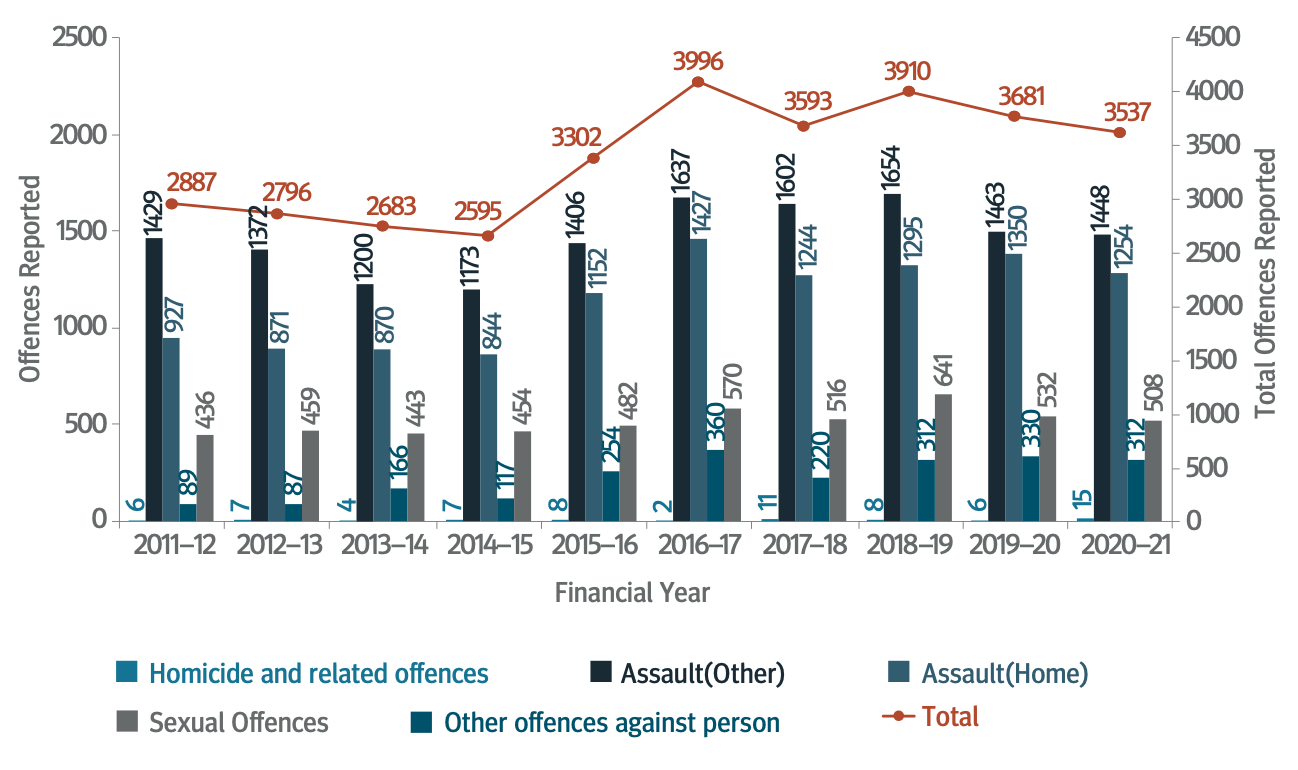
Source: PROMIS as at 2 July 2021
During 2020-21 there were 3,537 offences against the person reported to ACT Policing. This represents a decrease of 3.9 per cent (or 144 offences), compared to 2019-20.
TABLE 4.1: OFFENCES AGAINST THE PERSON BY OFFENCE TYPE - FINANCIAL YEAR COMPARISON
| Offences type | 2019-20 | 2020-21 | Change |
|---|---|---|---|
| Homicide and related offences | 6 | 15 | 150.0% |
| Sexual Assault offences | 532 | 508 | -4.5% |
| Assault | 2,813 | 2,702 | -3.9% |
| Assault (Home) | 1,350 | 1,254 | 1,254 |
| Assault (Other) | 1,463 | 1,463 | -1.0% |
| Other offences against person* | 330 | 312 | -5.5% |
| Total | 3,681 | 3,681 | 3.9% |
Source: PROMIS as at 2 July 2021
*Other offences against the person include kidnapping and abduction, threatening behaviour and other dangerous and negligent acts.
During 2020-21, overall assault offences decreased by 3.9 per cent when compared to 2019-20.
Of those assault offences reported to ACT Policing, 40.6 per cent were family violence related, as shown in Figure 4.2.
FIGURE 4.2: PROPORTION OF FAMILY VIOLENCE RELATED ASSAULTS 2011-12 TO 2020-21
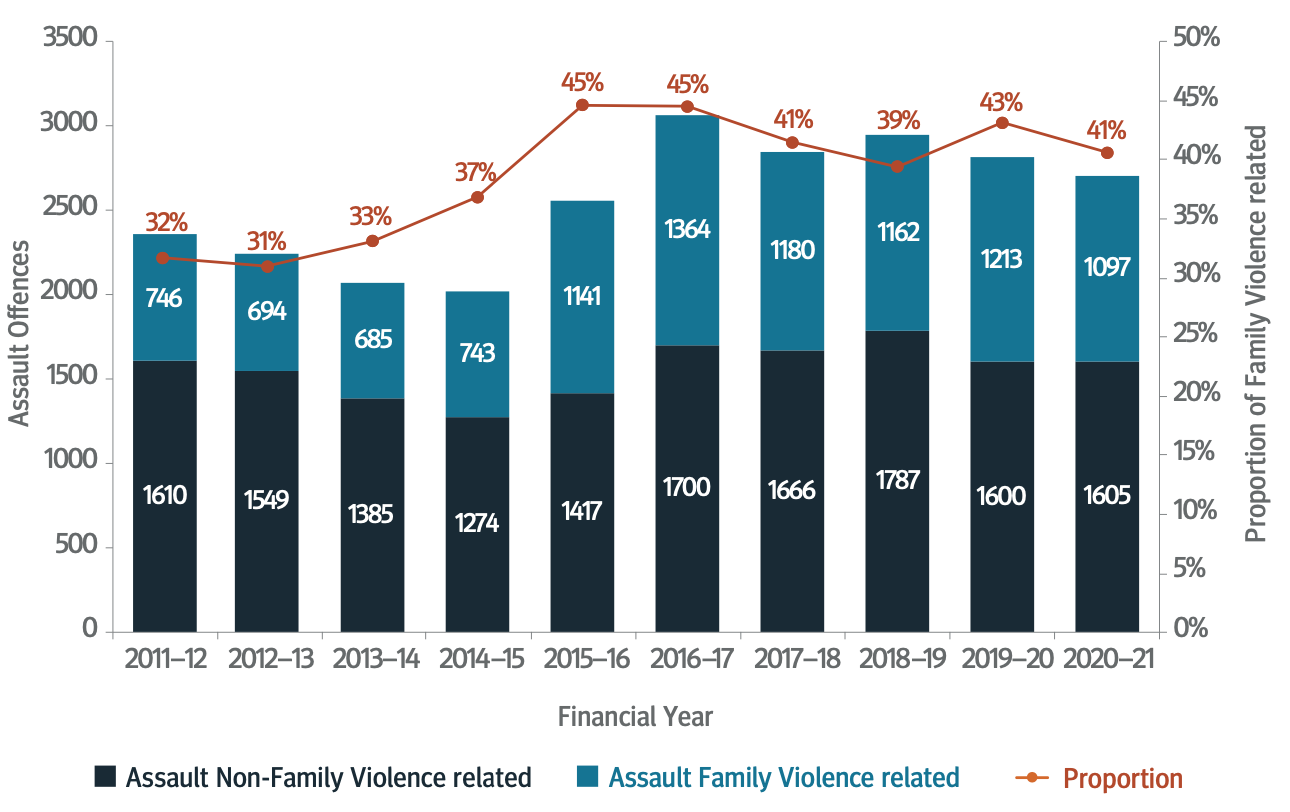
Source: PROMIS as at 2 July 2021
Family violence related assaults have decreased by 9.6 per cent over the 2020-21 financial year. Long term trends over 10 years show an increase of 47.1 per cent.
ACT Policing is working with partner agencies on a multi-agency family violence model which is perpetrator focused and concentrates on identifying early indicators of at-risk behaviour and making perpetrators accountable for their actions and behaviours. This model shifts the focus onto early intervention of low level family violence perpetrators, which alleviates the burden on victims to take action, seek solutions and support for themselves and/or families.
Figure 4.3 shows the percentage of people in the ACT somewhat concerned or very concerned about becoming a victim of certain crime types compared to the national average.
FIGURE 4.3: PERCEPTION OF CRIME BY OFFENCE TYPE 2020-21
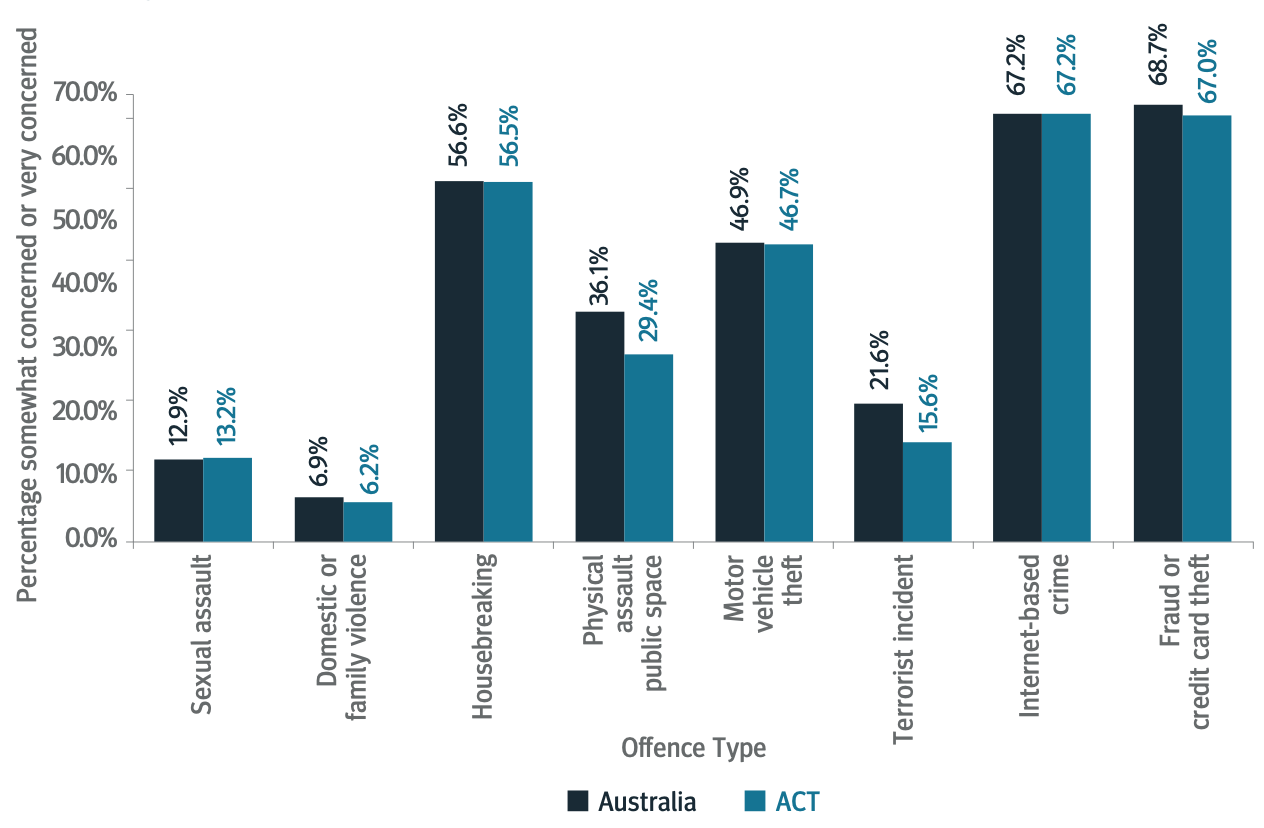
Source: National Survey of Community Satisfaction with Police, 2 July 2021
The results shown in Figure 4.3 are promising, with the ACT demonstrating a lower percentage of people who are concerned about being victims of domestic or family violence, motor vehicle theft, a terrorist incident, housebreaking, fraud and physical assault in a public place.
Figure 4.4 depicts the percentage of people who feel safe by location and time of day.
FIGURE 4.4: FEELINGS OF SAFETY BY LOCATION AND TIME OF DAY 2020-21
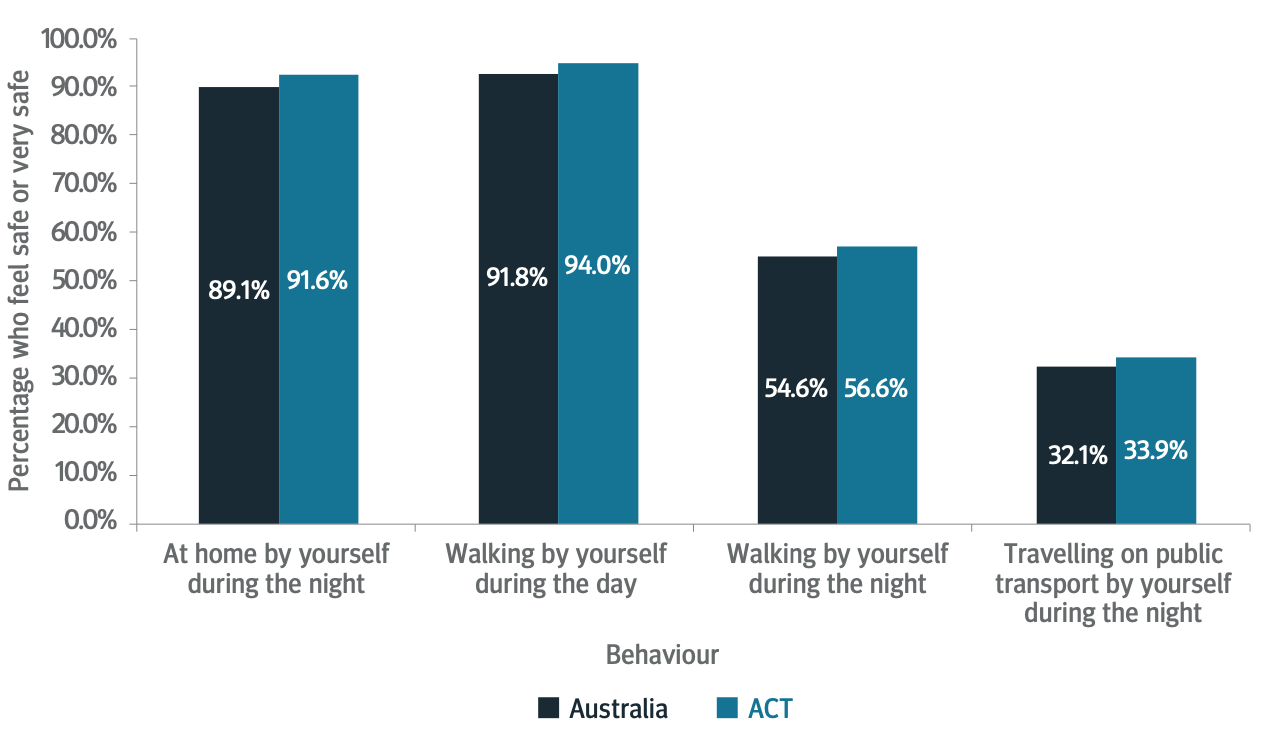
Source: National Survey of Community Satisfaction with Police, 2 July 2021
Case study
Family Violence intervention operations help to reduce recidivism
ACT Policing continues to work collaboratively with its partners to combat the cycle of family violence, and to increase support to both victims and perpetrators.
In August and September 2020, ACT Policing conducted Family Violence intervention operations which focused on perpetrator compliance and intervention. These operations were undertaken in collaboration with a number of partner agencies, including the Domestic Violence Crisis Service (DVCS), Child and Youth Protection Service (CYPS), ACT Victim Support and the Office of Family Safety.
During the operations, ACT Policing conducted Bail and Family Violence Order (FVO) compliance checks and executed outstanding FVOs and First Instance Warrants (FIW) on offenders. Partner agencies were present to offer assistance and support to the victims of family violence once the FVOs and FIWs were served.
The operations also focused on engagement with high risk recidivist offenders, ensuring their understanding on compliance requirements. Victims of family violence were also kept informed of relevant police action and offered referrals to support agencies.
The collaborative approach helped facilitate a number of immediate referrals for support of both victims and perpetrators and the contemporaneous sharing of information with partner agencies and services assisted the operation in directing resources, and prioritising victim safety.
Feedback from all participants was extremely positive with the success of the operation further evidenced in the number of accepted perpetrator referrals which increased through the September operation, compared with the August operation.
ACT Policing has begun discussions with CYPS and the Office of Family Safety to explore options for a formalised, integrated and collaborative interagency secondary response to family violence in incidents in the ACT.
Performance Measure 2 - Number of offences against property reported or becoming known per 100,000 population.
Offences against property include but are not limited to robbery, burglary, motor vehicle thefts, other theft, property damage and other offences against property.
The target for this measure was 8,300 or less offences against property reported or becoming known per 100,000 population. ACT Policing achieved the target for this measure with a result of 3,905.7 offences per 100,000 population.
FIGURE 4.5: OFFENCES REPORTED AGAINST PROPERTY 2011-12 TO 2020-21

Source: PROMIS as at 2 July 2021
During 2020-21 there were a total of 16,789 offences against property reported to ACT Policing. This represents a decrease of 7.0 per cent (or 1,256 offences) when compared to 2019-20 (Table 4.2).
| Offence type | 2019-20 | 2020-21 | Change |
|---|---|---|---|
| Robbery | 233 | 149 | -36.1% |
| Armed robbery | 108 | 55 | -49.1% |
| Unarmed robbery | 125 | 94 | -24.8% |
| Burglary | 2,337 | 1,967 | -15.8% |
| Burglary dwellings | 1,392 | 1,148 | -17.5% |
| Burglary shops | 376 | 279 | -25.8% |
| Burglary other | 569 | 540 | -5.1% |
| Motor Vehicle Theft | 1,296 | 1,372 | 5.9% |
| Other Theft | 8,250 | 7,666 | -7.1% |
| Property damage | 4,248 | 3,931 | -7.5% |
| Other offences against property* | 1,681 | 1,704 | 1.4% |
| Total | 18,045 | 16,789 | 7.0% |
Source: PROMIS as at 2 July 2021
*Other offences against property include fraud, traffic, drug and weapon offences and other offences not elsewhere classified
Figure 4.6 shows that motor vehicle theft offences reported in the ACT have increased year on year since the 2018-19 financial year. ACT Policing in partnership with the ACT Government continues to promote property crime reduction strategies to the community including the Outsmart the Offenders campaign which provides practical ideas that can be implemented to reduce the risk of motor vehicle theft and other property crime offences.
FIGURE 4.6: MOTOR VEHICLE THEFT OFFENCES REPORTED 2011-12 TO 2020-21
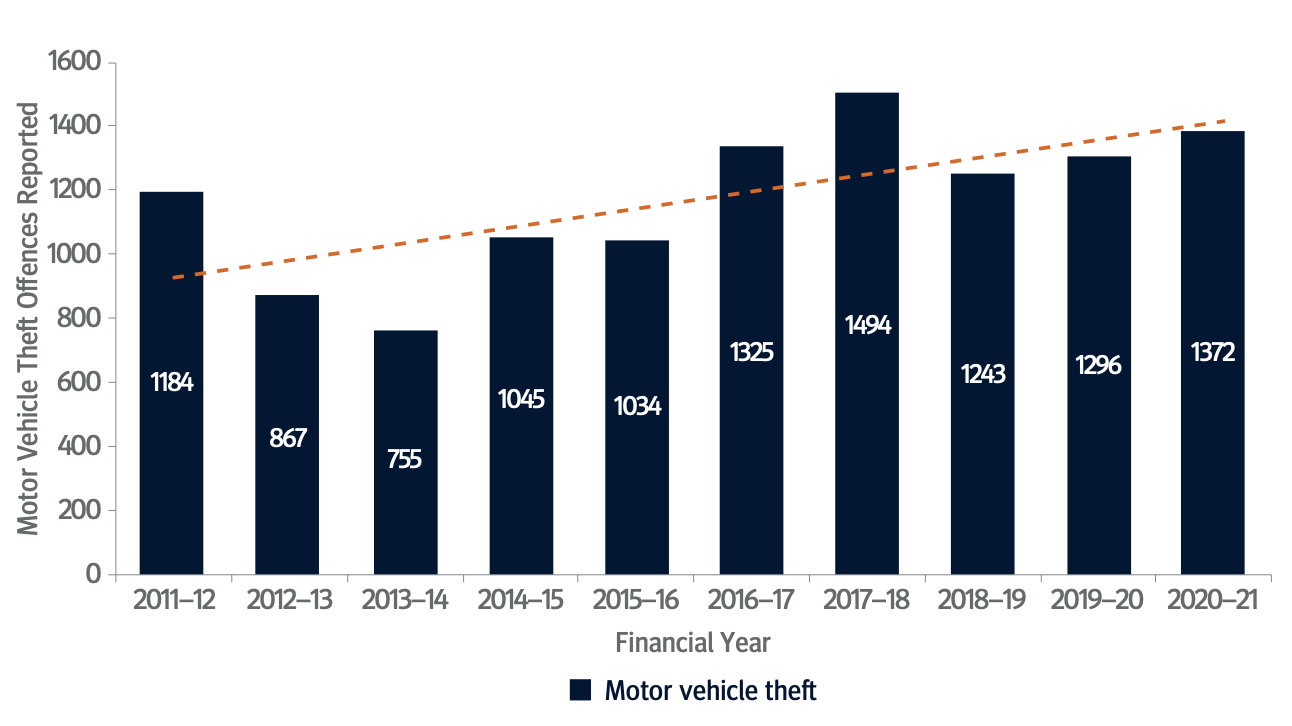
Source: PROMIS as at 2 July 2021
Criminal Investigations and Prosecutions
Performance Measure 3 - Percentage of offences against the person cleared.
Offences cleared relates to offences where there is an outcome during 2020-21.
These outcomes include the identification of an offender (through an arrest or some other form of proceeding such as a summons or a caution), withdrawal of the complaint or the determination that the offence was unsubstantiated. It is important to note the clearance of the offence may not necessarily occur in the same period in which it was reported.
The target for this measure required a clearance rate of 72 per cent or more for all offences against the person. ACT Policing did not meet the target for this measure, recording a clearance rate of 65.5 per cent.
In October 2020, ACT Policing’s Criminal Investigations portfolio underwent a realignment to move away from a response model to a more flexible and holistic investigation, prevention and disruption model. A new roster was introduced for Major Crime teams creating a more proactive and partnership focused approach to investigations and solving crime with a fifth Major Crime team established from existing resources, to provide additional capability to Gungahlin station.
ACT Policing Intelligence also realigned its structure with the aim to enhance strategic advice relating to the incidents of particular crime trends and to develop strategies to counter them, and to also provide enhanced inline operational support to the investigation of allegations of criminal conduct.
FIGURE 4.7: OFFENCES REPORTED AGAINST THE PERSON CLEARED 2011-12 TO 2020-21
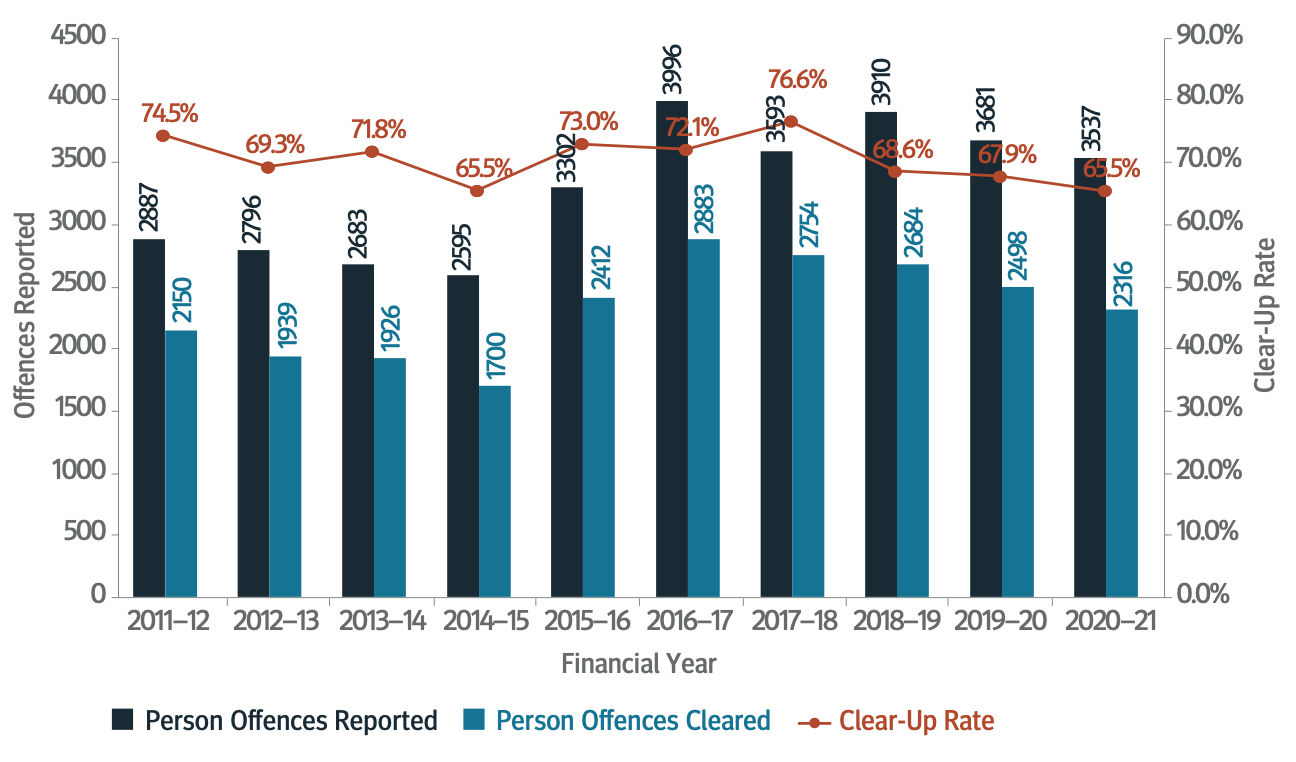
Source: PROMIS as at 2 July 2021
Case study
Proactive Intervention and Diversion team enables new approach to policing
In 2020, ACT Policing introduced the first of three proactive policing teams as part of the $33.9 million PSM funding provided by the ACT Government. The PIDT liaises with members of the community and third party partners to target recidivist offenders and those at risk of falling into a life of crime. In 2020 the PIDT assisted with several priority issues impacting on capacity for broader ACT Policing response teams, including ongoing risk to young people, drug-related and youth gang violence offences as well as problem solving issues related to reoccurring instances of vehicles failing to stop for police.
In September 2020, the PIDT undertook targeting of a high priority active offender in the ACT suspected of being responsible for a number of criminal offences in Canberra and Queanbeyan. The incidents included use of a stolen motor vehicle, threats with weapons, thefts, assaults and a number of fail to stops. The offender was subsequently arrested by the PIDT in NSW with the assistance of the NSW Police Force and extradited to the ACT where the offender was remanded in custody. Whilst in custody, PIDT took the opportunity to engage with the offender and address fundamental issues such as the root cause for the offending. The offender willingly engaged with members of PIDT and was supported in identifying programs available upon release from custody, and placement in these programs. A subsequent visit showed the offender had enrolled in programs and furthered opportunities to obtain work upon release from custody. It is anticipated this positive engagement will see the offender taking positive steps towards a life away from crime.
Case study
ACT Policing continues to target organised crime
On 23 July 2020, the Confiscation of Criminal Assets (Unexplained Wealth) Amendment Bill 2020 was passed. This introduced new amendments designed to effectively deter and disrupt serious criminal activity, to provide greater scope for police to tackle crime at its source and to ensure those participating in organised crime do not profit from their illegal activities.
Following a joint operation in August 2020, ACT Policing and NSW Police Force arrested the National President of the Nomads Outlaw Motorcycle Gang and seized assets worth more than $500,000.
ACT Policing’s investigation into illegal activity and associated illegitimate profits in Canberra has not stopped.
In October 2020, detectives from Criminal Investigations including Taskforce Nemesis, and officers from Specialist Protective Services simultaneously restrained assets in Kambah and the Batemans Bay region. Assets restrained included three boats, three Harley Davidson motorcycles, a caravan and trailers.
ACT Policing also made a major contribution to the overt phase of AFP Special Operation Ironside - an AFP/FBI led investigation, spanning over three years and resulting in hundreds of arrests across the globe and the most significant disruption to organised crime in recent years. ACT Policing officers provided assistance to their national colleagues on operational activity in the ACT, New South Wales and South Australia. Specifically, ACT Policing officers were involved in the arrest of suspects, preparation and execution of search warrants and associated surveillance duties.
Special Operation Ironside has led to the arrest of 224 offenders on 526 charges in every mainland Australian state. 3.7 tonnes of drugs, 104 weapons, $44,934,457 in cash, and assets expected to run into the millions of dollars have been seized under Special Operation Ironside since 2018.
Case study
ACT Drugs and Organised Crime section targets illicit drugs
ACT Policing remains committed to targeting those seeking to exploit the community for their own personal gain.
ACT Policing’s Drugs and Organised Crime teams work closely with colleagues in Criminal Investigations and Intelligence and the NSW Police Force utilising all available resources at their disposal to target illicit drugs and illegal activities within the territory.
In August 2020, ACT Policing intelligence identified that a person was travelling to Sydney to allegedly be supplied with a large amount of cocaine.
At short notice, ACT Policing arranged support areas, gathered resources and obtained search warrants in preparation for the person’s return to the ACT. ACT Policing coordinated the arrest of the person which resulted in the seizure of 308 grams of cocaine.
A search warrant executed at the person’s residence resulted in cash and further amounts of cocaine being seized. ACT Policing’s efficient and effective work saw an alleged key member of a criminal network arrested and charged, and controlled drugs with an estimated street value of $210,000 prevented from entering circulation within the ACT community.
ACT Policing seized approximately 231 kilograms of illicit drugs in 2020-21, with police actions stopping a significant amount of harmful substances making their way into the ACT community.
Performance Measure 4 - Percentage of offences against property cleared.
Property crime is often opportunistic in nature and many offences occur without a victim being present which creates additional challenges in identifying offenders.
Offences cleared against property relates to offences where there is an outcome during 2020-21. These outcomes include the identification of an offender (through an arrest or some other form of proceeding such as a summons or a caution), withdrawal of the complaint or the determination that the offence was unsubstantiated. These offences include robbery, burglary, motor vehicle theft, other theft, property damage and other offences against property.
The target for this performance measure was 15 per cent or more offences against property cleared. ACT Policing met the target for this measure achieving a clearance rate of 16.1 per cent of total property offences.
FIGURE 4.8: OFFENCES REPORTED AGAINST PROPERTY CLEARED 2011-12 TO 2020-21
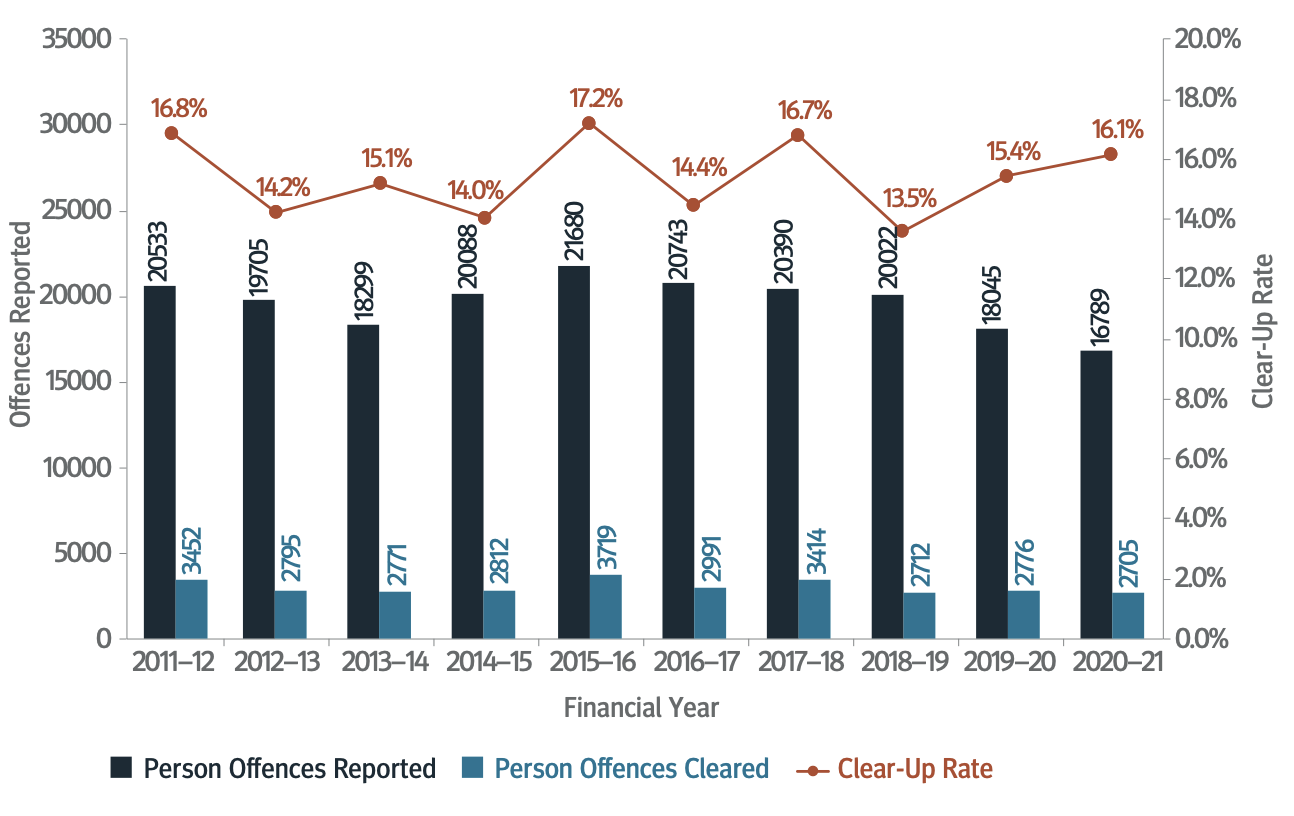
Source: PROMIS as at 2 July 2021
Performance Measure 5 - Percentage of briefs delivered to the Director of Public Prosecutions (DPP) within the designated timeframe.
The target for this measure is to deliver 75 per cent or more briefs to the ACT Director of Public Prosecutions (DPP) within the designated timeframe. The designated timeframe commences from the date of the plea to the date disclosed by the DPP.
The designated timeframes are dependent on the matter and are subject to change by the DPP. Timeframes are classified as follows:
- Adult matters: 42 days
- Family violence matters: 23 days
- Child matters: 30 days.
ACT Policing met the target for this measure, achieving a result of 85.5 per cent of briefs delivered to the DPP within the designated timeframe.
ACT Policing is continuing to identify efficiencies in processes, including reducing delays in the delivery of briefs of evidence. This is done in collaboration with the DPP and the ACT Courts to identify and create efficiencies in time, cost and resources in the judicial system.
Performance Measure 6 - Percentage of cases finalised by offence proved in court.
The target for this measure was 82 per cent or more cases to be finalised by the offence being proven in court. ACT Policing continues to perform well against this measure and achieved a result of 93.1 per cent.
Performance Measure 7 - Percentage of cases otherwise resolved.
This measure relates to incidents where defendants are found unfit to plea due to mental illness. The target for this measure was to ensure 5 per cent or less of cases were otherwise resolved (other than by court, a not-guilty verdict or otherwise withdrawn). ACT Policing achieved the target recording 3.2 per cent of cases otherwise resolved.
Outcome: Public Safety
Police Response
Performance Measure 8 — Response times for Priority One incidents within 10 minutes.
The target for Priority One (life threatening or critical) incidents is a response time of ten minutes or less for 80 per cent or more of incidents. ACT Policing did not achieve this target, responding to 77.5 per cent of Priority One incidents within 10 minutes.*
FIGURE 4.9: RESPONSE TIMES FOR PRIORITY ONE INCIDENTS 2014-15 TO 2020-21
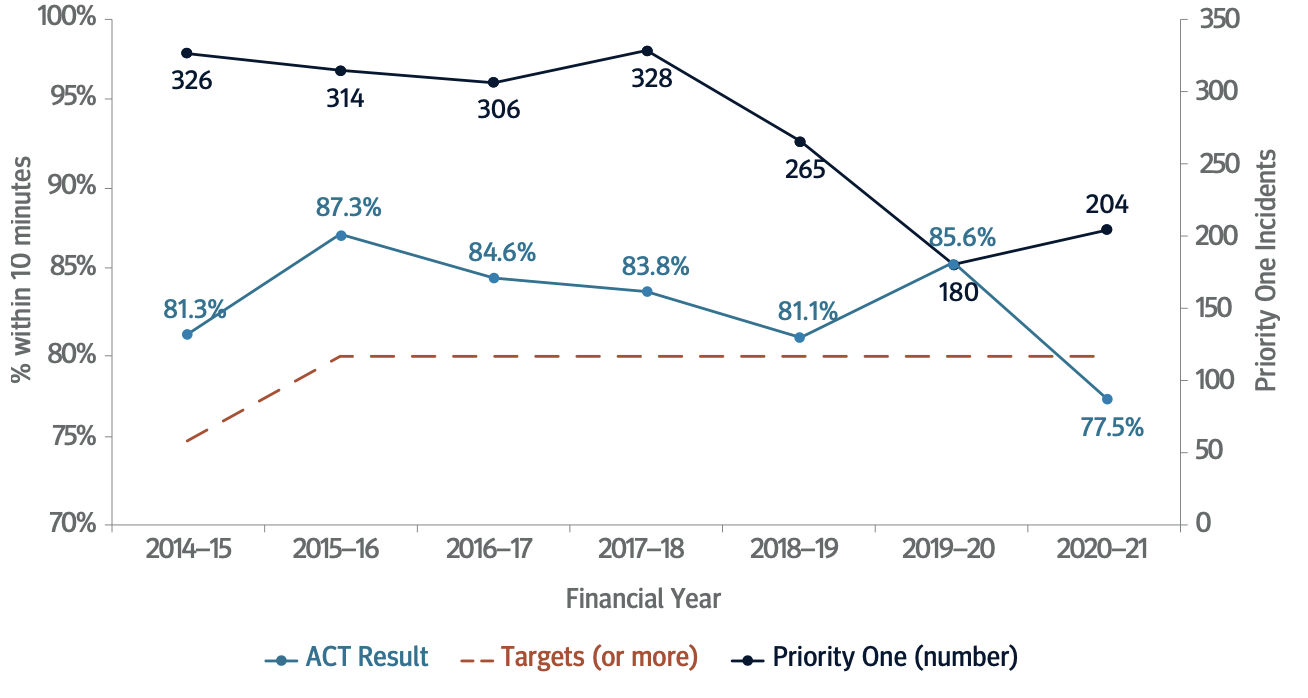
Source: PROMIS as at 2 July 2021
*KPI results are based on the initial priority allocation. A proportion of incidents are subject to grade revision and are then downgraded to Priority Two or lower after allocation and assessment. This applies to both incidents that are within the target timeframe and those that fail to meet the timeframe.
Performance Measure 9 - Response times for Priority Two incidents within 20 minutes.
The target for Priority Two incidents is 80 per cent or more incidents responded to within twenty minutes. ACT Policing did not achieve the target, recording a result of 73.6 per cent.
Calls for Priority Two matters have increased 58 per cent in the last seven years and 16 per cent compared to 2019-20 which demonstrates an increased demand on ACT Policing. The continued expansion of Canberra suburbs has also contributed to ACT Policing failing to meet this measure by 6.4 per cent.
According to 2016 census data, Gungahlin is the second-fastest-growing region in Australia, and medium-to-high-density living is becoming increasingly common.
Since 2004, all ACT patrol zones have increased in population by more than 15 per cent. The population in Gungahlin has increased from 30,008 in 2004 to 82,544 in 2019 (an increase of 175.1 per cent).
ACT Policing continues to consider the growing and changing population in the region and is working with the Justice and Community Safety Directorate in relation to a Strategic Property Plan that will ensure ACT Policing resources are best placed to continue to support the community.
FIGURE 4.10: NUMBER OF PRIORITY TWO INCIDENTS 2014-15 TO 2020-21
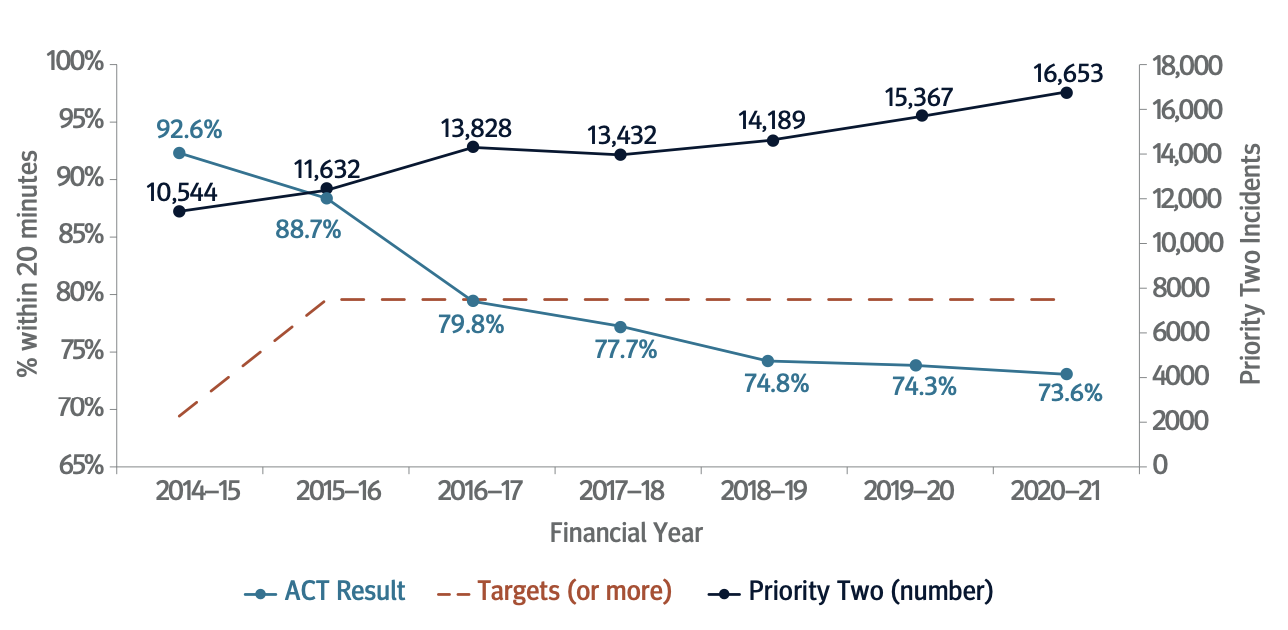
Source: PROMIS as at 2 July 2021
Performance Measure 10 - Response times for Priority Three incidents, no later than 48 hours from initial contact.
The target for this measure was 90 per cent or more incidents where police attended or responded no later than 48 hours from the initial contact by the complainant, or within a time determined in consultation with the complainant. ACT Policing achieved the target, recording a result of 95.5 per cent.
Performance Measures 11 a) - Percentage of Triple Zero (000) calls answered on first or second presentation and 11 b) - Percentage of Triple Zero (000) calls answered on second presentation
During 2020-21, the Minister for Police and Emergency Services endorsed the removal of KPI 11a) Percentage of Triple Zero (000) calls answered on the first or second presentation and 11 b) Percentage of Triple Zero (000) calls answered on second presentation.
In 2019 the Triple Zero infrastructure, provided by Telstra, underwent major changes which resulted in Telstra no longer having the capability to capture statistics on the number of Triple Zero calls answered by ACT Policing.
The removal of KPI 11 has not disrupted or impacted ACT Policing’s response to Triple Zero calls or the subsequent response to emergency or life-threatening incidents.
ACT Policing has since implemented a new Avaya telephone system that provides the capability to capture data on the number of Triple Zero calls answered on the first and second presentation.
Public Order and Emergency Management
Performance Measure 12 - Percentage of the community satisfied with police in dealing with public order problems.
During 2020-21, the Minister for Police and Emergency Services endorsed the removal of this KPI, due the removal of the question from the NSCSP.
Performance Measure 13 - Review and testing of arrangement for responding to and recovering from emergencies and disasters
This Performance Measure has no corresponding numerical figures for ACT Policing to report against.
COVID 19 has had a significant impact on the ability for ACTP ability to conduct face-to-face emergency testing arrangements and training, with numerous planned courses and exercises cancelled at late notice due to interstate, and to a lesser extent, local health restrictions.
The ACT Counter Terrorism Sub Plan was endorsed during the reporting period and high-level testing of the plan was conducted in May 2021 with the Capital Two exercise which included participation from the Minister as well as ACT Policing and AFP Executive.
ACT Policing’s Evacuation and Disaster Victim Registration Better Practice Guide (BPG) was endorsed in January 2021 and multi-agency testing of the guide is scheduled to be conducted in an exercise with the Emergency Services Agency (ESA) in October 2021.
ACT Policing’s Chemical Biological Radiological and Nuclear (CBRN) BPG has been reviewed and an updated guide is in the final stages of endorsement. A critical component of the review process was the participation in the multi-agency exercise Operation Threshold. Easing of health restrictions allowed for the gradual return of routine interagency exercising in 2021. During this period ACTP participated in several exercises with the Australian Defence Force (ADF), as well as exercises with Transport Canberra and City Services (TCCS), ACT Fire and Rescue and Icon Water.
The prevalence and size of mass gatherings, including events and protests, has varied during the reporting period due to easing and tightening of COVID-19 health restrictions throughout the country. While in general there have been fewer events and crowds have been smaller during the pandemic, police have continued to work with event organisers to contribute to protective security measures for crowded places in line with Australia’s Strategy for Protecting Crowded Places from Terrorism. Police have also adapted their response to these events to incorporate the additional responsibilities of policing the public health directions.
The effects of the COVID-19 pandemic have continued to be felt in 2021. Early in the New Year, ACT Policing was tasked with establishing a compliance check point regime at the ACT/NSW Border. The entire Road Policing Team, supported by General Duties members and 31 new recruits, were deployed to ensure non-residents from declared COVID-affected areas in NSW had the requisite exemptions to legally enter the ACT, and that returning residents understood any self-isolation requirements. Our officers worked tirelessly across the holiday period, inspecting 4,483 vehicles on 2 and 3 January alone, with 147 of those vehicles being turned away and 217 vehicles containing returning ACT residents being directed into quarantine. Over the course of the first week of January, ACT Policing inspected approximately 30,000 vehicles. ACT Policing continues to contribute to the whole-of-government response to ever-evolving challenges posed by the COVID-19 pandemic in the Territory.
Our dedicated COVID-19 Taskforce worked closely with ACT Health to ensure a coordinated approach to the compliance and enforcement of health directions relating to quarantine, self-isolation, and travel restrictions. This included spot checks of people in quarantine at both hotels and private residences; attending to calls from the public reporting non-compliance; and ensuring interstate visitors were compliant with ACT health directions. The community has responded well and worked with us over the last year with the overwhelming majority of interactions with police being positive and supportive of police efforts to keep the community safe.
Case study
Specialist Operations providing support in high risk situations
The AFP Specialist Protective Command (SPC), Specialist Operations (SO) provide a range of specialist policing services to the ACT Community and ACT Policing (ACTP). This broad range of services and capabilities include; Search and Rescue, Negotiators, Bomb Technicians, Police Maritime and Divers, UAV’s, Tactical and Discreet Operations. These specialist teams provide expertise requiring specialist training to deliver a highly professional and effective support to AFP operations in the ACT.
On the front line, SO capabilities provide assistance in locating missing persons and evidence; rapid response to situations requiring tactical containment and negotiation, urgent investigation of suspicious items and where required, rendering these items safe. The deployment of specialist capabilities in these situations increase the likelihood of peaceful, safe resolutions and reduce the risk of injury to members of ACT Policing and the community.
In July 2020, members of Specialist Operations Search and Rescue (SAR) Team were put to the test, responding to a call made by ACTP’s Communications to assist in the location and rescue of a missing hiker near Mount Tidbinbilla. The hiker had dialled Triple Zero at approximately 8.00am after becoming disorientated during his descent from the summit the previous evening and had become lost in heavy bushland and snow.
AFP SAR members reviewed a map of the area and discussed appropriate strategies with ACT Parks and Wildlife rangers on route to Tidbinbilla Nature Reserve, where the plan was finalised and the rescue crew briefed. Three SAR members supported by ACT Parks set off on foot, navigating the very steep and rugged terrain. A fourth SAR member stayed behind at the set off point in the reserve to provide coordination and a central control point for the assignment. Approximately four hours into the trek the team located the hiker at the bottom of a cliff, which then presented a new challenge to extract the hiker. After an assessment of the surrounding terrain, a safe route was identified to access the hiker, with the mission completed 10 hours after receiving the initial call. Despite displaying the effects of surviving a night outdoors in sub-zero temperatures and light snowfall, the hiker was otherwise uninjured.
In March 2021, the ACT experienced a torrential downpour and the ACT Policing Operations Centre received a request for assistance, after a woman had fallen into dangerous river conditions at Kambah Pool.
The woman and her two friends had been in the area taking photos of the unusually flooded river, to post to their social media channels. In an effort to get the ‘perfect shot’, the woman slipped on the wet rocks and fell into the fast flowing water below. Due to the torrents, she was then swept further down the river until she was fortunately able to secure herself to a tree and wait for help to arrive.
Members of the Special Operations Maritime team were immediately deployed to provide qualified and expertly trained, swift-water rescue resources.
An ACT Policing General Duties member entered the water and was able to reach the stranded woman in an attempt to assist her in getting back to shore, however she was unable to move due to not only a fear of the rapids, but also a physical inability to move her legs due to the freezing cold water.
With the assistance of ACT Fire and Rescue, members of the Maritime team immediately developed a plan that involved the strategic and expedited placement of throw bags, deployment of ropes across the water banks and lifejackets to safely extract both the injured woman and General Duties officer from the water.
Luckily the woman escaped the incident with no major injuries, however the outcome could have been very different if it wasn’t for the quick response from the members specialising in Swift Water Rescues.
Following the incident, ACT Policing used the opportunity to remind the community of a simple message that when it comes to drains, floodwaters and swollen rivers - no photo or social media post is ever worth risking your life or the lives of others.
Road Safety and Traffic Management
Performance Measure 14 - Number of road crashes resulting in death per 100,000 population.
The target for this performance measure was 4.2 or fewer road crashes resulting in death per 100,000 population. ACT Policing achieved the target, recording a result of 2.6 fatal road crashes per 100,000 population during 2020-21.
As presented in Figure 4.11 the number of fatal collisions per 100,000 population in the ACT remains consistently below the national average.
FIGURE 4.11: ROAD CRASHES RESULTING IN DEATH PER 100,000 POPULATION 2016-17 TO 2020-21
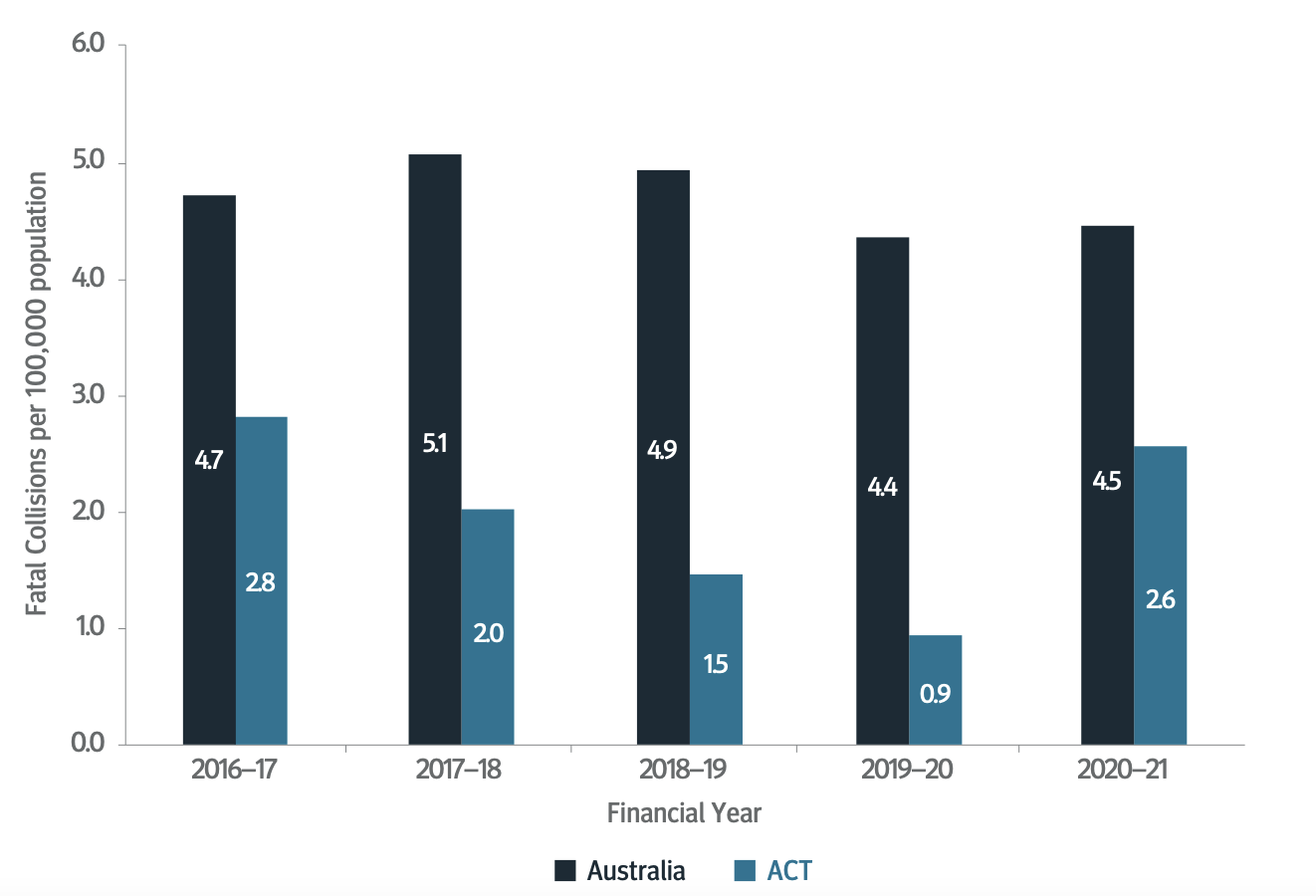
Source: Australian Road Deaths Database as at 30 June 2021
Performance Measure 15 - Number of road crashes resulting in injury per 100,000 population.
The target for this measure was 180 or fewer road crashes resulting in injury per 100,000 population. ACT Policing achieved this measure with the number of road collisions resulting in injury recorded at 104.7 per 100,000 population.
FIGURE 4.12: MOTOR VEHICLE COLLISIONS WITH INJURY 2016-17 TO 2020-21
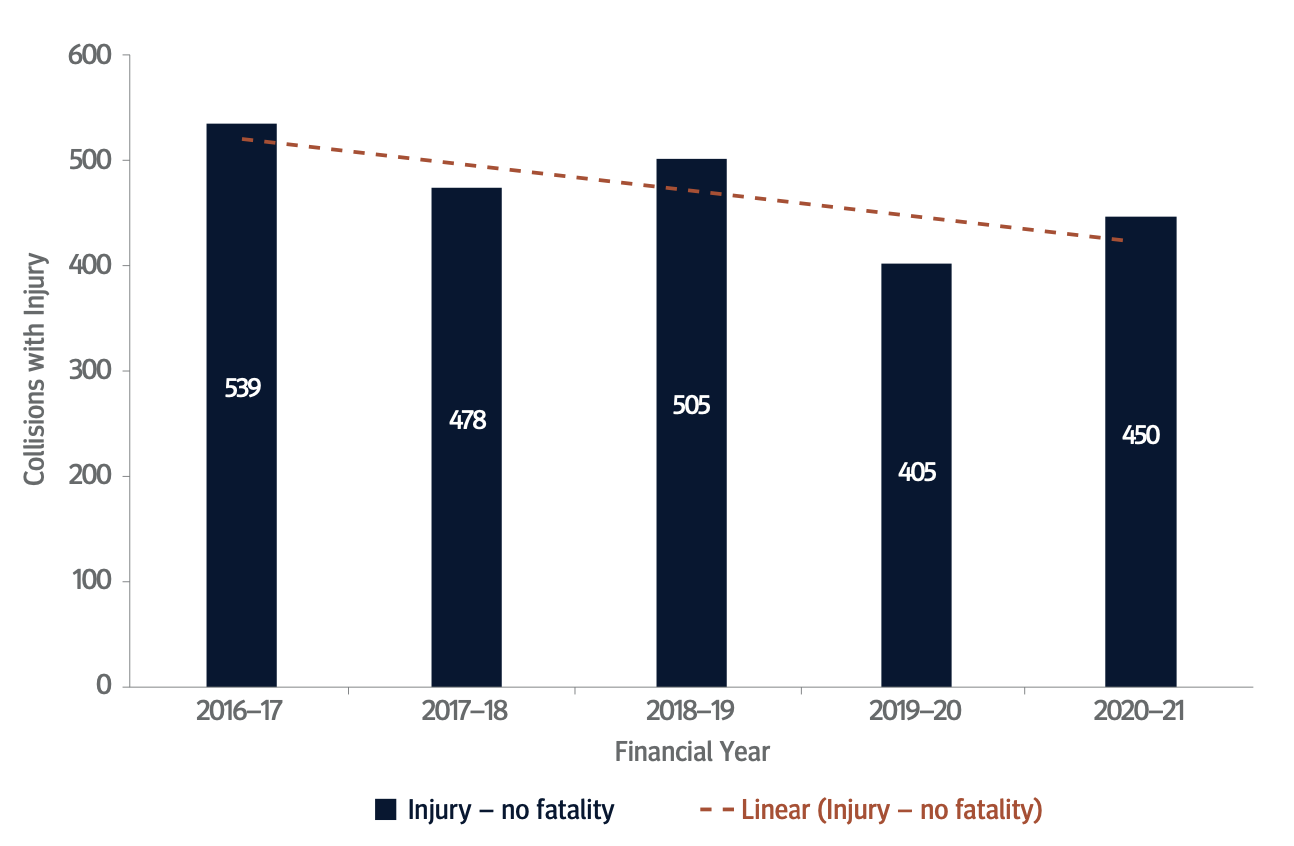
Source: PROMIS as at 2 July 2021
Case study
ACT Policing addresses road safety through new initiatives
ACT Policing’s Road Policing Portfolio manages road safety by enforcing the ACT road rules, and promoting safer driving to reduce road trauma and the ACT road toll.
Road Policing provides high visibility patrols and undertakes specific targeted operations to ensure ACT roads are safe for all road users. The team enforces traffic laws in line with the priority focus of the ACT Road Safety Calendar and delivers strategic awareness campaigns to educate the community on its obligations as road users.
Following a marked increase in speeding offences in 2020, ACT Policing teamed up with ACT Fire and Rescue, the ACT Ambulance Service, Canberra Health Services and William Cole Funerals to curb this aspect of troubling driver behaviour.
In November 2020, ACT Policing launched a road safety campaign called ‘Who are you rushing to meet?’ with the aim of the campaign to compel drivers to seriously reflect on their behaviour behind the wheel. The messaging was simple - speeding can lead drivers to a very different destination than initially intended - perhaps a meeting with police, fire brigade, ambulance officers, trauma surgeons, or even a funeral director.
This campaign has seen positive results trickle into the community with ACT Policing issuing 3,980 Traffic Infringement Notices for speeding during the 2020-21 financial year. This is a decrease of 21 per cent when compared to the 2019-20 financial year.
In addition to the campaign, in March 2021 ACT Policing proudly launched its new motorcycle which is equipped with Automated Number Plate Recognition (ANPR) technology and is currently the only one of its kind in Australasia and one of only a few in the world.
The motorcycle hosts several high definition video cameras that accurately capture a vehicle’s licence plate information from almost all angles. In addition, the latest version of the ANPR system provides more detailed information to the police officer and captures metadata such as GPS location, time and date to provide accurate evidence.
The new motorcycle complements the new Road Policing cars also equipped with ANPR technology that were unveiled in November 2020, in an effort to better equip officers to keep Canberra’s roads safe.
Outcome: Community and Partner Engagement
Community Support and Whole-of-Government Engagement
Performance Measure 16 - Percentage of the community satisfied in general with services provided by police.
The target for this measure is the national average or more as determined by the NSCSP. The national average for 2020-21 was 80.7 per cent, while the ACT result was 80.8 per cent.
Performance Measure 17 - Percentage of the community who have confidence in police.
The target for this measure is the national average or more as determined by the NSCSP. The national average for 2020-21 was 82.1 per cent, while the ACT result was 84.1 per cent.
Figure 4.13 shows ACT Policing’s performance against measures relating to community satisfaction and confidence.
FIGURE 4.13: SATISFACTION AND CONFIDENCE IN POLICE 2020-21
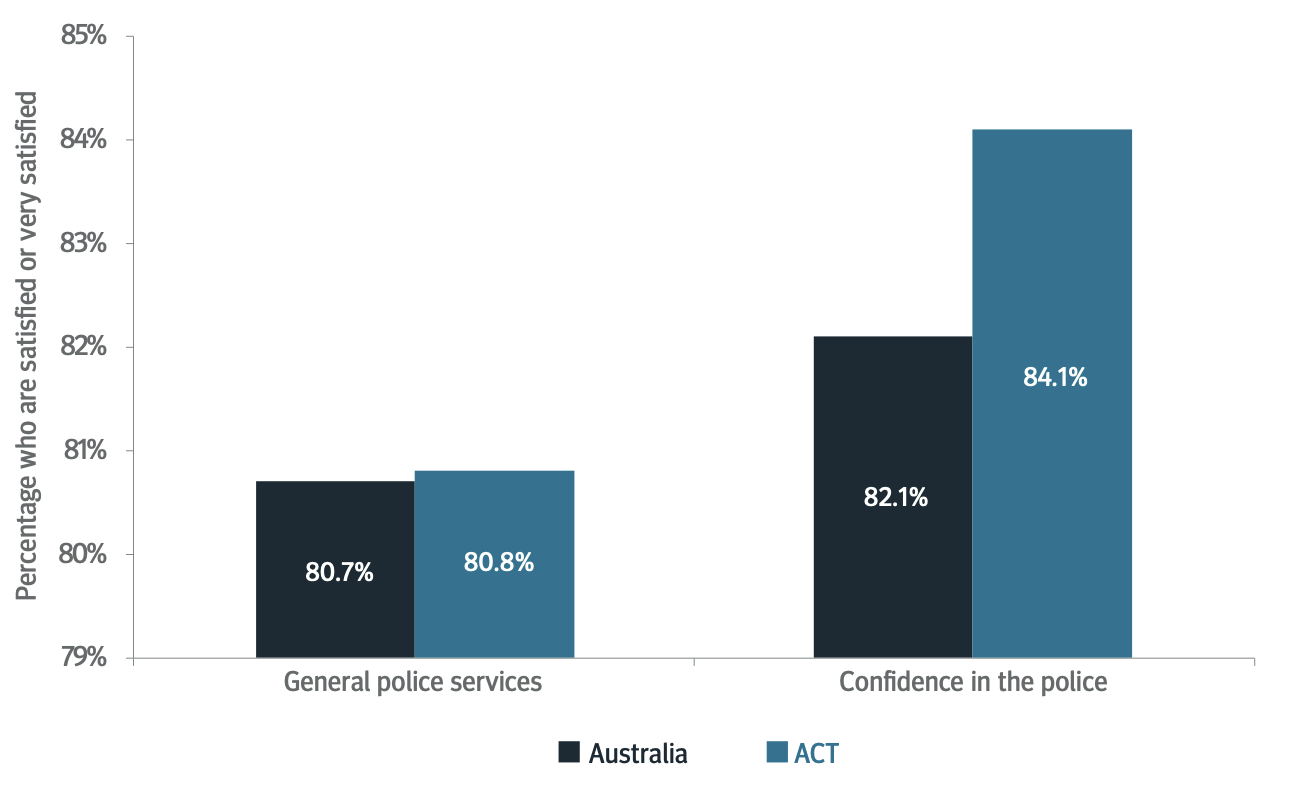
Source: National Survey of Community Satisfaction with Police, 2 July 2021
Case study
Constable Kenny Koala: spreading child safety awareness
The Constable Kenny Koala (CKK) program delivered by ACT Policing is a strong foundation for educating preschool and primary school aged children in Canberra and has been operating for more than 40 years. The program teaches road safety, protective behaviours, online safety, decision making and consequences, and encourages children to turn to police for help and advice.
Following a review of the program in 2020, a number of modifications were made to ensure it remains both contemporary and accurately linked to the Australian curriculum. The program includes additional subjects and also provides more tailored presentations including an online safety presentation via ThinkUKnow for Kindergarten to Year 2 and tailored decision making and consequences lessons for Kindergarten to Year 4.
Teachers are also provided with resource packs after each visit and can access a new online teacher resources section on the CKK website so safety learnings can continue in the classroom.
In the first term back to school, CKK engaged with 2,619 children (across 112 classrooms) throughout February 2021. This is the highest number of classes for February in the past three years, and almost double the number of presentations given in February 2019.
The continued success of the CKK program enables children in Canberra to be educated on important issues and ensure they have a favourable and positive experience with police throughout their childhood.
Case study
Coffee with a Cop
ACT Policing works hard at fostering strong rapport and positive relationships with the community it serves. Police are continuously reviewing and adapting ideas to engage with its most important stakeholder - the ACT community.
The Coffee with a Cop initiative has continued throughout 2020 and 2021 and provides community members the opportunity to build relationships with their local police officers, discuss what’s going on in their neighbourhood, ask questions they may have about the law or policing, or just have a chat about what’s on their mind. The event provides a relaxed location for police to engage with the public in a stress-free environment, to build trust and help break down potential barriers in communication.
Topics can vary from crime in the local area, recruitment and road policing issues to discussions about family violence, women in policing, specific laws and peoples’ obligations.
In March 2021, Belconnen Police Station members hosted the first ACT Policing Cop Pop Up display at Jamison Plaza, which builds on the community interaction established by Coffee with a Cop. The display proved popular with the community, with many attending asking questions about policing and the law, raising issues and concerns about their local area, while others were simply happy to have a general chat with the officers.
This new ACT Policing initiative endeavours to make police more connected and visible in the community and gives the public the opportunity to engage with officers in a relaxed environment.
These programs provide a channel for meaningful stakeholder engagement and have proven that interactions like these are the foundation of community partnerships that help ACT Policing deliver the best possible police service to the ACT community.
Performance Measure 18 - Percentage of eligible young people referred to restorative justice.
The target for this performance measure is for ACT Policing to refer 100 per cent of eligible young offenders to restorative justice (RJ).
Results for 2020-21 show ACT Policing did not meet the target for this performance measure, with 77 per cent of eligible young offenders referred to RJ. During the reference period, nineteen offenders were not referred to RJ (23 per cent variation in target).
ACT Policing’s policy is to refer all eligible young offenders, including all eligible young Aboriginal and Torres Strait Islander offenders, to RJ and to work with government and non-government partners to identify options for increased diversion and community- based referrals. ACT Policing recognises the role of restorative justice in the ACT Government’s Reducing Recidivism by 25 per cent by 2025 policy (RR25by25), and fully appreciates the role of police in contributing to that aspiration. In late 2020, ACT Policing embarked on a program to improve RJ referral rates of all offenders, but particularly young offenders. This body of work is evolving but includes:
- reinvigoration of the relationship with the ACT Government RJ Unit (RJU)
- convening roundtable discussions with the RJU and RJ stakeholders/partners including the ACT DPP, ACT Court, SupportLink, the Aboriginal Legal Service and ACT Legal Aid
- workforce engagement to understand impediments to RJ
- reform of the RJ role within ACT Policing - moving from transactional workflow to one of policy and practices improvement, workforce communications and RJ reform.
ACT Policing is undertaking broad engagement to find reforms that can be achieved within the Crimes (Restorative Justice) Act 2004 on offender eligibility criteria, particularly concerning young offenders and to align RJ referral capability with that of the Courts.
In February 2021, child welfare organisation Ozchild was awarded a contract to deliver a new ACT program called Functional Family Therapy, in order to address youth recidivism. This program specifically targets adolescents who are generally disadvantaged and at a high risk of serious offending. To address inter-generational crime in the ACT, the JaCS and ACT Policing have identified and referred young people to Ozchild.
This early intervention diversionary program encourages positive behaviour by working with young at-risk people either at the very early stages of their offending, or when they’ve first made contact with the youth justice system.
The Functional Family Therapy pilot is funded by the Confiscated Assets Trust Fund.
Performance Measure 19 - Number of persons referred to community support agencies.
The target for this measure is 5,500 or more persons referred to community support agencies.
Results for 2020-21 show ACT Policing met this target with 5,802 referrals to SupportLink, which is 5.5 per cent above the target.
ACT Policing will continue to refer people to appropriate support agencies as alternate avenues to formal court processes.
Performance Measure 20 - Number of referrals to drug diversion programs (drug demand reduction effort).
The target for this measure was 80 or more referrals to drug diversion programs.
Results for 2020-21 show ACT Policing met this target with 158 people diverted into the Early Intervention and Drug Diversion Program.
ACT Policing continues to focus on drug harm minimisation through these referrals. Given that the majority of these persons would have otherwise entered a formal court process, this reduces the overall burden on the justice system and minimises the harm caused from illicit drugs.
Performance Measure 21 - ACT Policing Victim Liaison Officers providing contact with victims of indictable crime reported to police.
The target for this measure was 80 per cent or more.
ACT Policing achieved this target, with 81 per cent of victims contacted by our Victim Liaison Officers (VLOs) during 2020-21.
Providing assistance to victims of crime through VLO contact has the potential to reduce further victimisation, stop the escalation of crime and provide victims with the appropriate support.
Other Reporting
Recommendation 10 of the Report on the Inquiry in the Form of an Evaluation of Current ACT Policing Arrangements states that ACT Policing will report on its use of interpreters and translators in its Annual Report from 2020-21.
| Number of requests received for interpreters and translators 1 July 2020 to 30 June 2021 | |
|---|---|
| Jul-20 | 23 |
| Aug-20 | 16 |
| Sep-20 | 18 |
| Oct-20 | 21 |
| Nov-20 | 16 |
| Dec-20 | 9 |
| Jan-21 | 15 |
| Feb-21 | 10 |
| Mar-21 | 23 |
| Apr-21 | 17 |
| May-21 | 24 |
| Jun-21 | 16 |
Source: NOSSC Interpreter & Translator Team, 27 September 2021
Case study
ACT Policing addresses Aboriginal and Torres Strait Islander Engagement
ACT Policing continues to focus on improving engagement with the Aboriginal and Torres Strait Islander community to improve life outcomes and reduce representation in the criminal justice system.
In March 2021, the Commonwealth and ACT Ombudsman released their report following an own motion investigation into ACT Policing’s engagement with the Aboriginal and Torres Strait Islander community. The report made nine recommendations, all of which ACT Policing is addressing in consultation with the Aboriginal and Torres Strait Islander communities, stakeholders amongst ACT Government Directorates, and internally with the AFP First Nations Unit.
Early engagement with the AFP First Nations Unit, centred on strategic engagement with the community and cultural training, has been positively received.
The heart of the recommendations speaks to the need to develop overarching strategic governance to address ACT Policing’s engagement with the Aboriginal and Torres Strait Islander community. To give effect to this underlying requirement, ACT Policing is establishing a Working Group with Executive-level oversight.
The CPO Aboriginal and Torres Strait Islander Advisory Board will also play a key role. This Board was established in late 2018, and meets quarterly to provide advice to the CPO on matters relating to the Aboriginal and Torres Strait Islander community and their engagement with ACT Policing. By having oversight of the Working Group’s implementation progress, the Advisory Board will be highly influential in shaping the development of strategic governance for ACT Policing.
ACT Policing continues to brief the Minister for Police and Emergency Services regarding progress against the recommendations, and is in close consultation with the JaCS.
ACT Policing also remains engaged with the Commonwealth Ombudsman’s Office on the implementation of the various recommendations.
5 Professional Standards
The term professional standards relates to the Commissioner’s expectation that all AFP appointees, including those in ACT Policing, will serve with integrity.
AFP Professional Standards sits within the AFP’s Chief of Staff Command and is responsible for developing and maintaining the highest professional standards throughout the organisation, as well as overseeing and investigating complaints about the conduct of AFP appointees.
The AFP’s professional standards are underpinned by the AFP Core Values (see Chapter 3: Our Values) and the AFP Code of Conduct. Further information on the AFP Values and the AFP Code of Conduct is available on the AFP website (www.afp.gov.au).
AFP Professional Standards Framework
The AFP’s professional standards framework is governed by Part V of the Australian Federal Police Act 1979 and the Australian Federal Police Regulations 1979.
This framework is further supported by internal governance such as the Commissioner’s Order on Professional Standards and the National Guideline on Complaint Management. The Commonwealth Ombudsman and the Australian Commission for Law Enforcement Integrity (ACLEI) oversee the framework.
The AFP is committed to managing fraud and corruption risks as part of its everyday business, and complies with the Australian National Audit Office Better Practice Guide on Fraud Control in Australian Government Entities. As a Commonwealth entity, the AFP has a Fraud Control and Anti-Corruption Plan which ensures compliance with the Public Governance, Performance and Accountability Rule 2014 (Cth).
The ACT community has the reassurance of regulation 18 of the Law Enforcement Integrity Commissioner Regulations 2017, which establishes a mechanism for the relevant ACT Government Minister to be informed about ACLEI’s activities when investigating serious corruption and systemic corruption as defined by the Law Enforcement Integrity Commissioner Act 2006.
The AFP’s professional standards model adopts a tiered approach according to the seriousness of the breach:
- Category 1 conduct — relating to customer service matters
- Category 2 conduct — relating to minor misconduct
- Category 3 conduct — relating to serious misconduct including breaches of the criminal law or serious neglect of duty
- Corruption issues (also referred to as Category 4).
Complaints dealing with Categories 1 and 2 of the AFP’s professional standards are managed by line managers through the ACT Policing Complaint Management Team.
More serious matters that may result in employment suitability consideration (Category 3) are investigated by the AFP’s Professional Standards area. Every Category 3 matter is further reported to the Commonwealth Ombudsman for additional oversight.
Complaints and information about corrupt conduct of AFP appointees are immediately referred to ACLEI. Pursuant to section 26 of the Law Enforcement Integrity Commissioner Act 2006, the Integrity Commissioner will determine whether a matter is investigated solely by ACLEI, jointly with the AFP Professional Standards , or as an AFP-only investigation (with or without ACLEI oversight or management).
Corrupt conduct includes bribery and misuse of public office such as payment or receipt of secret commissions, release of confidential information in exchange for a benefit, serious conflict of interest or serious nepotism and/or cronyism. The term ‘benefit’ is not restricted to a material benefit. A benefit may be tangible or intangible and may include information. A beneficiary may receive an indirect benefit and/or be a third party.
ACT Policing Complaint Statistics
Financial year 2020-21
During the financial year 2020-21, AFP’s Professional Standards area received 83 complaints relating to ACT Policing, resulting in 147 alleged conduct breaches5 being recorded.
TABLE 5.1: ALLEGED CONDUCT BREACHES RECORDED DURING LAST FOUR YEARS, BY CATEGORY 6
| ALL ACT POLICING BREACHES | 2017-18 | 2018-19 | 2019-20 | 2020-21 |
|---|---|---|---|---|
| Category 1 | 66 | 82 | 68 | 34 |
| Category 2 | 143 | 69 | 42 | 50 |
| Category 3 | 48 | 49 | 47 | 47 |
| Corruption issues | 19 | 16 | 11 | 16 |
| Total | 276 | 216 | 168 | 147 |
TABLE 5.2: ALLEGED COMPLAINTS RECORDED DURING 2020-21, BY SOURCE
| Source | Total complaints | Percentage |
|---|---|---|
| Member of the public | 39 | 47.00% |
| Reporting another AFP member | 43 | 51.80% |
| Self-reported | 1 | 1.20% |
| Total | 83 | 100% |
TABLE 5.3: FINALISED CONDUCT BREACHES DURING 2020-21, BY CATEGORY 7
| All ACT policing breaches | Established | Not established | Discretion not to proceed | Withdrawn |
|---|---|---|---|---|
| Category 1 | 5 | 45 | 3 | 2 |
| Category 2 | 9 | 48 | 3 | - |
| Category 3 | 9 | 37 | 13 | 2 |
| Corruption issues | 2 | 4 | 5 | - |
| Total | 25 | 134 | 24 | 4 |
TABLE 5.4: ESTABLISHED CONDUCT BREACHES DURING 2020-21
| Conduct breach | Number established |
|---|---|
| Inappropriate Behaviour/Conduct | 5 |
| Drug Misconduct | 3 |
| Practice or Procedure Issue | 2 |
| Discourtesy | 2 |
| Fail to Comply with Direction | 2 |
| Fail to Record and Report | 2 |
| Criminal Misconduct | 1 |
| Inappropriate Behaviour/Conduct Serious | 1 |
| Fail to Declare Association | 1 |
| Abuse of Office | 1 |
| Information Release | 1 |
| False Time Recording | 1 |
| Unauthorised Discharge Taser | 1 |
| Inadequate Service | 1 |
| Due Care/Diligence Failure | 1 |
| Total | 25 |
Timeliness benchmarks are applied to each category, with a target of 90 per cent to be finalised within the specified number of days. The benchmarks are: 42 days for Category 1 matters, 66 days for Category 2 matters, and 256 days for Category 3 matters. Corruption issues fall under the Law Enforcement Integrity Commissioner Act 2006 (Cth) and are not subject to a timeliness benchmark.
TABLE 5.5: COMPLAINTS ON HAND8, AS OF 16 JULY 2021
| All ongoing ACT policing complaints | Complaints ongoing | Number of complaints overdue | Exceeds 30 days over benchmark | Exceeds 90 days over benchmark |
|---|---|---|---|---|
| Category 1 | 2 | - | - | - |
| Category 2 | 3 | 2 | 2 | - |
| Category 3 | 18 | 5 | 1 | 3 |
| Corruption issues | 14 | - | - | - |
| Total | 37 | 7 | 3 | 3 |
TABLE 5.6: AVERAGE RUN TIME OF FINALISED COMPLAINTS 2020-21
| Finalised ACT policing complaints | Number of complaints | Average run time (days) | % within benchmark | % exceeding benchmark |
|---|---|---|---|---|
| Category 1 | 30 | 97 | 23.3% | 76.7% |
| Category 2 | 23 | 174 | 26.1% | 73.9% |
| Category 3 | 34 | 241 | 73.5% | 26.5% |
| Corruption issues | 9 | 445 | - | - |
| Total | 96 | 199 |
TABLE 5.6: AVERAGE RUN TIME OF FINALISED COMPLAINTS 2020-21
| Finalised ACT policing complaints | Number of complaints | Average run time (days) | % within benchmark | % exceeding benchmark |
|---|---|---|---|---|
| Category 1 | 30 | 97 | 23.3% | 76.7% |
| Category 2 | 23 | 174 | 26.1% | 73.9% |
| Category 3 | 34 | 241 | 73.5% | 26.5% |
| Corruption issues | 9 | 445 | - | - |
| Total | 96 | 199 |
- 5 Multiple breaches can result from one complaint.
- 6 Part V of the Australian Federal Police Act 1979 defines the categories of conduct. Category 1 is the least serious category and predominantly relates to customer service breaches. Category 2 is minor misconduct and Category 3 is serious misconduct. Corruption issues are referred to the Australian Commission for Law Enforcement Integrity (ACLEI).
- 7 This table only includes matters where the case was finalised. This table includes matters reported before 1 July 2018.
- 8 This table includes all complaints recorded on the AFP’s Complaint Recording and Management System where the investigation is yet to be finalised and relates to a member of ACT Policing.
TABLE 5.6: AVERAGE RUN TIME OF FINALISED COMPLAINTS 2020-21
| Finalised ACT policing complaints | Number of complaints | Average run time (days) | % within benchmark | % exceeding benchmark |
|---|---|---|---|---|
| Category 1 | 30 | 97 | 23.3% | 76.7% |
| Category 2 | 23 | 174 | 26.1% | 73.9% |
| Category 3 | 34 | 241 | 73.5% | 26.5% |
| Corruption issues | 9 | 445 | - | - |
| Total | 96 | 199 |
Complaint Data
The complaint data contained in this report was extracted from the AFP’s SAS Visual Analytics, which is a live system, updated on a daily basis. This report is reflective of Category 1-4 complaints that relate to members of ACT Policing. The data for this report was extracted and accurate as at 16 July 2021, with the exception of finalised complaints timeliness data, which was extracted and accurate as at 26 July 2021.
TABLE 5.7: NUMBER OF INFORMAL COMPLAINTS REPORTED TO ACT CMT 2020-21
| All ACT CMT complaints | |
|---|---|
| Informal complaints reported to the ACT CMT in 2020-21 | 148 |
TABLE 5.8: NUMBER OF VICTIMS’ RIGHTS RELATED COMPLAINTS REPORTED 2020-21*
| Victims’ rights-related complaints | ||
|---|---|---|
| Statement of how many complaints were made to the agency within the year | 23 | |
| For each written complaint, the right in relation to which the complaint was made** | 14C Respectful engagement with victims | 12 |
| 14D Respectful engagement with child victims | 1 | |
| 14E Contact with victims | 10 | |
| 14F Victims’ privacy | 1 | |
| 15(1) Referral of victims to support services | 2 | |
| 15A Provision of aids or adjustments to victims | 1 | |
| 15D/18C Tell victims about administration of justice processes | 8 | |
| 16A Update victims about status of investigations | 6 | |
| For each written complaint, whether the agency resolved the complaint | 22 | |
*The above statistics only include complaints from 1 January 2021 to 30 June 2021 due to the Victims’ Rights Charter coming into effect on 1 January 2021. All complaints made before this date are not included as they are not covered by the Charter.
**There can be multiple rights related to one complaint, therefore the overall number of rights can be higher than the overall number of complaints.
Trends Analysis
Alleged Conduct Breaches Submitted
Compared to 2019-20, ACT Policing has seen a 12.5 per cent decrease in total alleged conduct breaches (168 to 147) during 2020-21 and a 46.74 per cent decrease since the 2017-18 financial year (276 to 147).
In relation to the source of the complaints, for the 2020-21 financial year, there was an increase of 19.98 per cent where an AFP member reported another AFP member compared to the 2019-20 financial year. The source of the complaints received in 2020-21 from a Member of the Public was down 12.09 per cent and those that Self-Reported were down 6.07 per cent, from 8 self-reported complaints in 2019-20 to 1 self-reported complaint in 2020-21.
Category 1 — ACT Policing has seen a decrease of 50 per cent in Category 1 breaches compared to the previous financial year. The 34 alleged breaches submitted in the 2020-21 financial year is notably lower than all of the Category 1 figures from 2017-18 to 2019-20 financial years, ranging between 66 and 82.
Category 2 — Compared to the 2019-20 financial year, there has been a 19.05 per cent decrease in alleged Category 2 breaches. Since the 2017-18 financial year there has been a 65.03 per cent decrease in alleged Category 2 breaches.
Category 3 — Alleged Category 3 breaches submitted have remained relatively consistent across the 2017-18, 2018-19 and 2019-20 and 2020-21 financial years.
Corruption Issues — Compared to the 2019-20 financial year there has been a 45.45 per cent increase in reports of alleged corruption. There has been a 15.78 per cent decrease between the 2017-18 and the 2020-21 financial years.
The topmost reported alleged breaches submitted against ACT Policing members were:
Category 1
- Inadequate Service
- Discourtesy
- Unreasonable Delay.
Category 2
- Inappropriate Behaviour/Conduct
- Excessive Force - No injury
- Fail to Comply with Procedure.
Category 3
- Excessive force with Injury
- Criminal Misconduct
- Inappropriate Behaviour/Conduct Serious.
Finalised Conduct Issues
In 2020-21, 96 complaints (187 conduct breaches) were finalised, a decrease of 41 complaints compared to the 137 finalised in the 2019-20 financial year.
The percentage of Established Category 1-4 conduct breaches finalised in 2020-21 decreased by 5 per cent compared to 2019-20, with a 5 per cent increase in those finalised with a finding of Not Established. The percentiles of those finalised with a finding of Discretion not to proceed or Withdrawn were consistent between 2019-20 and 2020-21 financial years.
The percentage of finalised complaints within the defined benchmark for Category 1-3 complaints was 44 per cent (38 of the 87). The 9 finalised corruption issues fall under the Law Enforcement Integrity Commissioner Act 2006 (Cth) and are not subject to a timeliness benchmark.
To maintain proper oversight and ensure AFP complaint investigations maintain integrity and fairness in practice and process, the Commonwealth Law Enforcement Ombudsman undertakes a review of randomly selected complaint investigations every year. ACT Policing and the AFP work closely with the Commonwealth Law Enforcement Ombudsman to adopt the principles of best practice for complaint management.
Established Matters
The number of conduct breaches established in the 2018-19 and 2019-20 financial years was consistent with 43 established in each financial year. Established conduct breaches in the 2020-21 financial year decreased by 18, from 43 in the two previous financial years to 25 in the 2020-21 financial year. The percentile of Category 1 finalised breaches that were established remained consistent across the two years.
In the 2019-20 financial year, 34.78 per cent of Category 2 conduct breaches finalised were established compared to 15 per cent in the 2020-21 financial year. The comparison of Category 3 conduct breaches across the two financial years shows that within the 2019-20 financial year, 18.91 per cent of Category 3 conduct breaches finalised had a finding of established compared to 14.75 per cent in the 2020-21 financial year.
The most prevalent established conduct breach within the 2020-21 financial year was Inappropriate Behaviour/Conduct. This is an increase of one from the four recorded in the 2019-20 financial year. Three of the five established conduct breaches involved an AFP member reporting another AFP member and two were from members of the public.
6 Use of Force
All AFP members including those in ACT Policing are governed by AFP Commissioner’s Order 3 (CO3) in the application of use of force principles. CO3 articulates mandatory compliance requirements in reporting and training.
All police members receive use of force training, during which the principles of communication and conflict de-escalation are emphasised as alternatives to the use of physical force. Police members are required to complete these use of force qualifications annually.
In all cases where members use force that is not a routine use of force the officer must, as soon as practical, submit a use of force report. ‘Use’ is defined with respect to the type of force used, which is as follows:
- Firearm, conducted electrical weapon (CEW) or chemical agent (OC Spray) or extended range impact weapon:
- drawing
- aiming
- discharging
- Baton:
- raising with the intention to strike or gain compliance
- striking a person
- Shield:
- striking a person with any part of the shield
- Police dog:
- directed intentional deployment at a person with the intention to gain compliance whether or not the police dog bites the subject
- defence of itself, handler or any other person
- Pyrotechnic device:*
- discharging the device so that concussive force, light, sound or any combination of these is emitted against another person
* This use of force option is available to Specialist Protective Services only.
- discharging the device so that concussive force, light, sound or any combination of these is emitted against another person
- Long range audio device:*
- Emitting sound from the device against another person to gain subject control
* This use of force option is available to Specialist Protective Services only.
- Emitting sound from the device against another person to gain subject control
Routine use of force means the following uses of force performed as part of an AFP appointee’s operational duties:
- compliant escort or restraint holds (including to effect an arrest)
- compliant handcuffing
- compliant search of a person
- force to enter a building, vehicle, vessel, or other secured area to search, recover, seize or arrest, where there is no application of force against a person.
Routine uses of force or verbal commands which do not involve the application of use of force options are not reportable. The circumstances of each routine use of force incident event must be recorded within the relevant PROMIS case.
All use of force reports are assessed for compliance with CO3 by the respective business areas. In addition, the Ombudsman can, and does, enquire as to use of force incidents and is empowered to make recommendations for the ongoing transparency of use of force recording and reporting processes.
The principles of negotiation, communication and de-escalation are always emphasised as being primary considerations prior to using physical force. Governance and oversight arrangements are in place to assure the community that any use of force is applied appropriately.
Table 6.1 summarises the number of use of force reports submitted by ACT Policing. During the 2020-21 reporting year, the number of use of force reports submitted by ACT Policing decreased 31.6 per cent when compared to the previous year.
TABLE 6.1: USE OF FORCE REPORTS SUBMITTED BY ACT POLICING
|
| 2019-20 | 2020-21 | Percentage Change |
|---|---|---|---|
| Baton | 32 | 20 | -37.5% |
| Chemical Agent | 117 | 83 | -29.1% |
| Conducted Electrical Weapons | 347 | 287 | -17.3% |
| Firearm | 60 | 29 | -51.7% |
| Handcuffs | 857 | 547 | -36.2% |
| Total | 1,413 | 966 | 31.6% |
7 Staffing Profile
ACT Policing recognises the impact the role of first responder can take on ACT Policing members’ health and works to equip them with strategies and tools to identify and address mental health concerns earlier. With the continued support of government and the broader AFP, ACT Policing continues to benefit from dedicated psychological services and welfare officers.
In recognition of the high likelihood of potential exposure to trauma, a third dedicated psychologist commenced in 2020-21. This has enabled the enhancement of annual assessments for high-risk work areas within ACT Policing. This increase in services, along with the work of the ACT Policing Injury Prevention & Management and Welfare teams, has seen an increase in early access to health services, which is likely to result in a decrease in Comcare claims over future years.
ACT Policing reports on members by headcount and Full-time Equivalent (FTE). Headcount is the number of ACT Policing members as at 30 June 2021. FTE figures are reported as an average over the full financial year and exclude members who are classified ‘inoperative unpaid’ (members who are on leave and not being paid by ACT Policing)9. The reporting of average FTE provides the most accurate reporting of resourcing across the year.
In line with the Purchase Agreement, ACT Policing’s FTE is supplemented by the enabling services of the AFP. In 2020-21, 161 nominal FTE were afforded to ACT Policing under the enabling services model. This notional FTE of sworn and professional members represents the services provided by the broader AFP in the delivery of community policing services to the ACT. Examples of such services include the Specialist Response Group, Forensics and Professional Standards. The enabling FTE of 161 excludes ACT Policing members conducting Commonwealth-funded duties and is not reflected in any of the reported headcount figures.
Reported FTE figures are higher than the reported headcount due to the inclusion of these enabling FTE.
As at 30 June 2021, there were a total of 966 members within ACT Policing, of which 3.93 percent identify as Aboriginal or Torres Strait Islander peoples, an increase from 3.36 percent in 2019-20. This is in line with ACT Policing’s commitment to increasing its Aboriginal and Torres Strait Islander workforce, in accordance with the AFP Reconciliation Action Plan 2018-2020, to achieve greater workforce diversity that is reflective of the community we serve.
Over a third of the total ACT Policing workforce were female (39.3 percent), with females representing 30.61 percent of the 709 sworn members in ACT Policing. This is an increase of 0.91 percent from 29.7 percent in 2019-20. ACT Policing had 98 police recruits commence in the 2020-21 financial year, of which 36.7 percent were female.
0.72 percent of members identified as people with disability, which is a slight increase from 0.7 percent last year.
Employees aged between 25 and 44 account for 65.4 percent of ACT Policing’s workforce, with employees aged over 50 accounting for 16.8 percent of the workforce.
The average length of service has reduced to 9.6 years, compared to 10 years in 2019-20.
- 9 Prior to 2018-19, ACT Policing reported FTE as an actual figure as at 30 June.
TABLE 7.1 AVERAGE FULL-TIME EQUIVALENT AND HEADCOUNT FOR 2020-21
| Police | PSO | Unsworn | Other | Total | |
|---|---|---|---|---|---|
| Average Full Time Equivalent (FTE) for 2020-21 | 674.05 | 9.64 | 218.18 | 16110 | 1,062.8711 |
| Headcount at 30 June 2021 | 709 | 14.00 | 243 | 966 |
TABLE 7.2 HEADCOUNT AS AT 30 JUNE 2021 BY GENDER
| Female | Male | Total | |
|---|---|---|---|
| Police | 217 | 492 | 709 |
| PSO | 6 | 8 | 14 |
| Unsworn | 157 | 86 | 243 |
| Percentage of workforce (based on headcount) | 39.3% | 60.7% | 100% |
- 10 AFP Enabling capability less Commonwealth funded FTE. This nominal FTE is comprised of a mix of sworn and professional roles.
- 11 This figure represents ACT Government funded positions which includes capability provided by the AFP.
TABLE 7.3 ACT POLICING WORKFORCE COMPOSITION HEADCOUNT AS AT 30 JUNE 202112
| Base Salary Group | Casual | Band 2 | Band 3 | Band 4 | Band 5 | Band 6 | Band 7 | Band 813 | Executive Level14 | SES15 | Total |
|---|---|---|---|---|---|---|---|---|---|---|---|
| SWORN POLICE OFFICER | |||||||||||
| Female | 0 | 64 | 50 | 47 | 34 | 3 | 13 | 3 | 2 | 1 | 217 |
| Male | 0 | 102 | 108 | 130 | 56 | 14 | 67 | 9 | 4 | 2 | 492 |
| Subtotal | 0 | 166 | 158 | 177 | 90 | 17 | 80 | 12 | 6 | 3 | 709 |
| UNSWORN STAFF | |||||||||||
| Female | 3 | 2 | 62 | 42 | 10 | 21 | 13 | 1 | 2 | 1 | 157 |
| Male | 1 | 1 | 41 | 16 | 6 | 10 | 9 | 0 | 2 | 0 | 86 |
| Subtotal | 4 | 3 | 103 | 58 | 16 | 31 | 22 | 1 | 4 | 1 | 243 |
| PSO STAFF | |||||||||||
| Female | 0 | 5 | 1 | 0 | 0 | 0 | 0 | 0 | 0 | 0 | 6 |
| Male | 0 | 6 | 2 | 0 | 0 | 0 | 0 | 0 | 0 | 0 | |
| Subtotal | 0 | 11 | 3 | 0 | 0 | 0 | 0 | 0 | 0 | 0 | 14 |
| Total | 4 | 180 | 264 | 235 | 106 | 48 | 102 | 13 | 10 | 4 | 96 |
TABLE 7.3 ACT POLICING WORKFORCE COMPOSITION HEADCOUNT AS AT 30 JUNE 202112
| Employment Category | Female | Male | Total |
|---|---|---|---|
| Ongoing Full time | 321 | 573 | 894 |
| Ongoing Part time | 50 | 5 | 55 |
| Non-Ongoing Full time | 6 | 7 | 13 |
| Non-Ongoing Part time | 0 | 0 | 0 |
| Casual | 3 | 1 | 4 |
| Total | 380 | 586 | 966 |
- 11 This table details Substantive positions only.
- 12 Inspector level
- 13 Superintendent or Coordinator level
- 14 Chief Police Officer, Deputy Chief Police Officers and Director of Corporate Services
TABLE 7.5: AVERAGE LENGTH OF SERVICE BY GENDER
| Female | Male | Total | |
|---|---|---|---|
| Average years of service | 9.0 years | 10.0 years | 9.6 years |
TABLE 7.6 HEADCOUNT AS AT 30 JUNE 2021 BY DIVISION/BRANCH
| Division /Branch | Headcount |
|---|---|
| Office of the Chief Police Officer | 3 |
| Office of the Deputy Chief Police Officer - Capability & Community Safety | 3 |
| Community Safety | 33 |
| Intelligence | 76 |
| Judicial Operations & Exhibit Management Centre & Family Violence | 104 |
| Operations | 98 |
| Office of the Deputy Chief Police Officer - Response | 3 |
| Criminal Investigations | 126 |
| Media & Public Engagement | 13 |
| North District | 189 |
| Road Policing & Emergency Management | 83 |
| South District | 119 |
| COVID Taskforce | 16 |
| Director Corporate Services | 3 |
| ACT Policing Futures Program | 4 |
| Finance & Commercial | 18 |
| Human Resources | 18 |
| Ministerial, Policy & Performance | 17 |
| Inoperative Pool | 40 |
| Total | 966 |
TABLE 7.7 HEADCOUNT AS AT 30 JUNE 2021 BY DIVISION/BRANCH AND EMPLOYMENT TYPE
| Division/Branch | Ongoing | Non-Ongoing16 | Casual17 | TOTAL |
|---|---|---|---|---|
| Office of the Chief Police Officer | 3 | 0 | 0 | 3 |
| Office of the Deputy Chief Police Officer - Capability & Community Safety | 3 | 0 | 0 | 3 |
| Community Safety | 33 | 0 | 0 | 33 |
| Intelligence | 76 | 0 | 0 | 76 |
| Judicial Operations & Exhibit Management Centre & Family Violence | 104 | 0 | 0 | 104 |
| Operations | 85 | 11 | 2 | 98 |
| Office of the Deputy Chief Police Officer - Response | 3 | 0 | 0 | 3 |
| Criminal Investigations | 125 | 0 | 1 | 126 |
| Media & Public Engagement | 11 | 1 | 1 | 13 |
| North District | 189 | 0 | 0 | 189 |
| Road Policing & Emergency Management | 83 | 0 | 0 | 83 |
| South District | 119 | 0 | 0 | 119 |
| COVID Taskforce | 16 | 0 | 0 | 16 |
| Director Corporate Services | 3 | 0 | 0 | 3 |
| ACT Policing Futures Program | 18 | 0 | 0 | 18 |
| Finance & Commercial | 3 | 1 | 0 | 4 |
| Human Resources | 18 | 0 | 0 | 18 |
| Ministerial, Policy & Performance | 40 | 0 | 0 | 17 |
| Inoperative Pool | 17 | 0 | 0 | 40 |
| Total | 949 | 13 | 4 | 966 |
TABLE 7.8 HEADCOUNT AS AT 30 JUNE 2021 BY AGE GROUP AND GENDER
| Age Group | Female | Male | Total |
|---|---|---|---|
| Under 25 | 31 | 23 | 54 |
| 25-29 | 81 | 90 | 171 |
| 30-34 | 62 | 107 | 169 |
| 35-39 | 57 | 103 | 160 |
| 40-44 | 49 | 83 | 132 |
| 45-49 | 38 | 80 | 118 |
| 50-54 | 34 | 57 | 91 |
| 55-59 | 17 | 30 | 47 |
| 60+ | 11 | 13 | 24 |
| Total | 380 | 586 | 966 |
TABLE 7.9 HEADCOUNT AS AT 30 JUNE 2021 BY DIVERSITY18
| Headcount | Percentage of agency workforce | |
|---|---|---|
| Aboriginal and Torres Strait Islander | 38 | 3.93% |
| Culturally &anp; linguistically diverse19 | 186 | 19.25% |
| People with disability | 7 | 0.72% |
- 18 Note: This data has been captured using an optional self-reporting mechanism. As a result, this data may not accurately reflect the actual numbers of Aboriginal and/or Torres Strait Islander members, Culturally and Linguistically Diverse members, and people with disability within the organisation.
- 19 A culturally and linguistically diverse person is a person who was born overseas, has at least one parent born overseas or speaks a language other than English at home.
8 Financials
Under the Purchase Agreement between the ACT Government, Australian Federal Police and the Chief Police Officer, ACT Policing was appropriated $179.888 million to deliver community policing services to the ACT for the 2020-21 financial year.
Financial Performance
The following financial information is based on audited Financial Reports for 2019-20 and 2020-21.
Our fiscal decisions supported a strong financial position in 2020-21, with a small surplus of $1.595 million (or 0.853 per cent).
Financial Analysis
Total revenue received by the AFP for the provision of policing services to the ACT was $187.038 million (including base appropriation, resources received free of charge and other revenue). This represented an increase of $9.375 million compared with the previous financial year (2019-20). The increase largely resulted from additional funding for initiatives which included:
- $7.586 million for the Police Services Model
- $0.863 million for the new Police, Ambulance and Clinician Early Response
- $0.729 million support for increasing financial pressures for core policing functions relating to ACT Policing’s Forensic Medical Contract
- $0.879 million for ACT Policing’s Emergency Cost Pressures from 2019-20 including COVID-19 and the 2020 Bushfire
- $2.434 million for the COVID-19 Public Health Response.
The increase is partially offset by:
- the cessation of out-year funding for 2018-19 budget measure More Police ($0.312 million)
- rollover of appropriation for Police Services Model ($0.483 million) and COVID-19 Public Health Response ($0.447m).
Total expenses amounted to $185.443 million which is an increase of $6.631 million compared to the 2019-20 financial year. The increased expenditure relates to new and additional budget initiatives funded through the ACT Government budget process. The Police Services Model contributed to the increase in Employee Expenses of $4.375 million compared to the 2019-20 financial year.
Annual financial statements for the reporting period, accompanied by the AuditorGeneral’s independent audit report, can be found at Appendix 1: Financial statements.
Asset Management
Assets Managed
Many of the facilities and infrastructure used by ACT Policing are owned by the ACT Government. Asset management for the facilities and infrastructure is the responsibility of the Justice and Community Safety Directorate, supported by ACT Policing.
Table 8.1 shows the assets managed by ACT Policing. As at 30 June 2021, the total value was $9.801 million.
TABLE 8.1: ASSETS MANAGED BY ACT POLICING
| Total value of assets managed as at 30 June 2021 | $9.801 million |
|---|---|
| Built property assets | ACT Policing is housed within nine facilities, seven of which are owned by the ACT Government. The remaining two facilities are leased by the AFP. |
| Land | N/A |
| Infrastructure (e.g. roads, bridges, traffic signals) | N/A |
| Urban parks | N/A |
| Other | For more information see annual reports of the Australian Federal Police and ACT Justice and Community Safety Directorate. |
Asset Maintenance and Update
Separate to facilities, ACT Policing conducted a number of capability asset upgrades and replacements throughout 2020-21. These included CCTV enhancements (Belconnen and Woden Police Stations), radio network enhancements (The Canberra Hospital and Gungahlin Marketplace), camera upgrades including rapid deployment of automatic number plate recognition mobile cameras and upgrade of police equipment.
Capability replacement, upgrades and repairs and maintenance support positive outcomes for ACT Policing and the wider community through maintaining high standards of equipment, safety and technical advancement.
Accommodation
In accordance with the Policing Arrangement and the Purchase Agreement (2017-2021), the ACT Government is responsible for the provision of appropriate facilities and associated infrastructure for the provision of policing services by the AFP. The ACT Government provides seven of the nine sites occupied by ACT Policing which includes five police stations. ACT Policing employs 966 members (headcount) occupying 26,022 square metres as detailed in Table 8.2.
TABLE 8.2: ASSET MAINTENANCE
| Building name/type | Area occupied (m2) |
| Winchester Police Centre | 6,250 |
| Belconnen Police Station | 2,800 |
| Traffic Operations Centre | 1,600 |
| Gungahlin Police Station | 344 |
| Tuggeranong Police Station | 2,800 |
| Woden Police Station | 2,200 |
| City Police Station | 4,200 |
| Specialist Response Group complex (leased) | 1,800 |
| Exhibit Management Centre (leased) | 4,028 |
Capital Works
Four capital works projects were completed across ACT Policing sites during the reporting period. Details of the completed works are presented in the following tables.
TABLE 8.3: COMPLETED WORKS PROJECTS 2020-21
| New Works Project 1 | |
|---|---|
| Project | Better support when it matters - Enhanced protective security measures for ACT Policing |
| Description | JESC vehicle entry/exit gate replacement |
| Business unit | Gungahlin Police Station |
| Estimated completion date | August 2020 |
| Original project value | $45,450 |
| Current year expenditure | $17,600 |
| Prior year expenditure | $17,600 |
| Total expenditure to date | $35,200 |
| Financially completed | Yes |
| Comments | Replacement of ageing gate at the facility. |
| New Works Project 2 | |
| Project | More services for our suburbs - Upgrading ACT Policing facilities |
| Description | HVAC Tuggeranong |
| Business unit | Tuggeranong Police Station |
| Estimated completion date | August 2021 |
| Original project value | $2,029,000 + $961,000 Zero Emissions Government funding Total $2,990,000 |
| Current year expenditure | $473,587 |
| Prior year expenditure | $1,454,698 |
| Total expenditure to date | $1,928,285 |
| Financially completed | No |
| Comments | HVAC Upgrade to electric heat pump with supporting high efficiency gas boiler, lighting upgrades and installation of solar PV with battery. Includes Winchester Lift and ($101,455) Winchester Building Management System ($372,132). |
| New Works Project 3 | |
| Project | Delivering Better Facilities (DBF) - TOC Belconnen |
| Description | Services Upgrade to code- Electrical, Fire and External LED lighting |
| Business unit | Traffic Operations Centre - Belconnen |
| Estimated completion date | August 2021 |
| Original project value | $735,545 |
| Current year expenditure | $308,984 |
| Prior year expenditure | Nil |
| Total expenditure to date | $308,984 |
| Financially completed | No |
| Comments | Upgrade ageing services to comply with code standards. |
| New Works Project 4 | |
| Project | Delivering Better Facilities (DBF) - Winchester Police Centre |
| Description | Services Upgrade to code standards |
| Business unit | Winchester Police Centre |
| Estimated completion date | November 2021 |
| Original project value | $2,515,367 |
| Current year expenditure | $1,766,582 |
| Prior year expenditure | Nil |
| Total expenditure to date | $1,766,582 |
| Financially completed | No |
| Comments | Upgrade to code for ageing building services and also includes refurbishment of SACAT and break-out area. |
Government Contracting
As a Commonwealth agency, ACT Policing complies with the Public Governance, Performance and Accountability Act 2013 (Cth). ACT Policing applies the Commonwealth Procurement Rules when procuring property and services, through the Commissioner’s financial instructions.
Government Procurement Polices
Under Commonwealth Procurement Rules, the AFP is required to undertake the following in relation to procurements:
- publish all open approaches to the market on AusTender
- require procurements valued at $80,000 or more to be conducted through open approaches to the market (select tendering and direct sourcing for procurements valued at $80,000 or more allowed only in limited circumstances)
- report the details of all awarded procurement contracts and purchases valued at $10,000 or more on AusTender within six weeks of the AFP entering into the arrangement.
The AusTender website can be accessed at www.tenders.gov.au.
Procurements Exempted from Quotation and Tender Threshold
ACT Policing operates within the Public Governance, Performance and Accountability Framework. For more details please see the AFP Annual Report (www.afp.gov.au).
Construction Grants and Social Procurement
ACT Policing did not issue any construction grants or engage in any social procurement activities during the 2020-21 reporting period.
Appendices
Appendix 1: Financial Statements

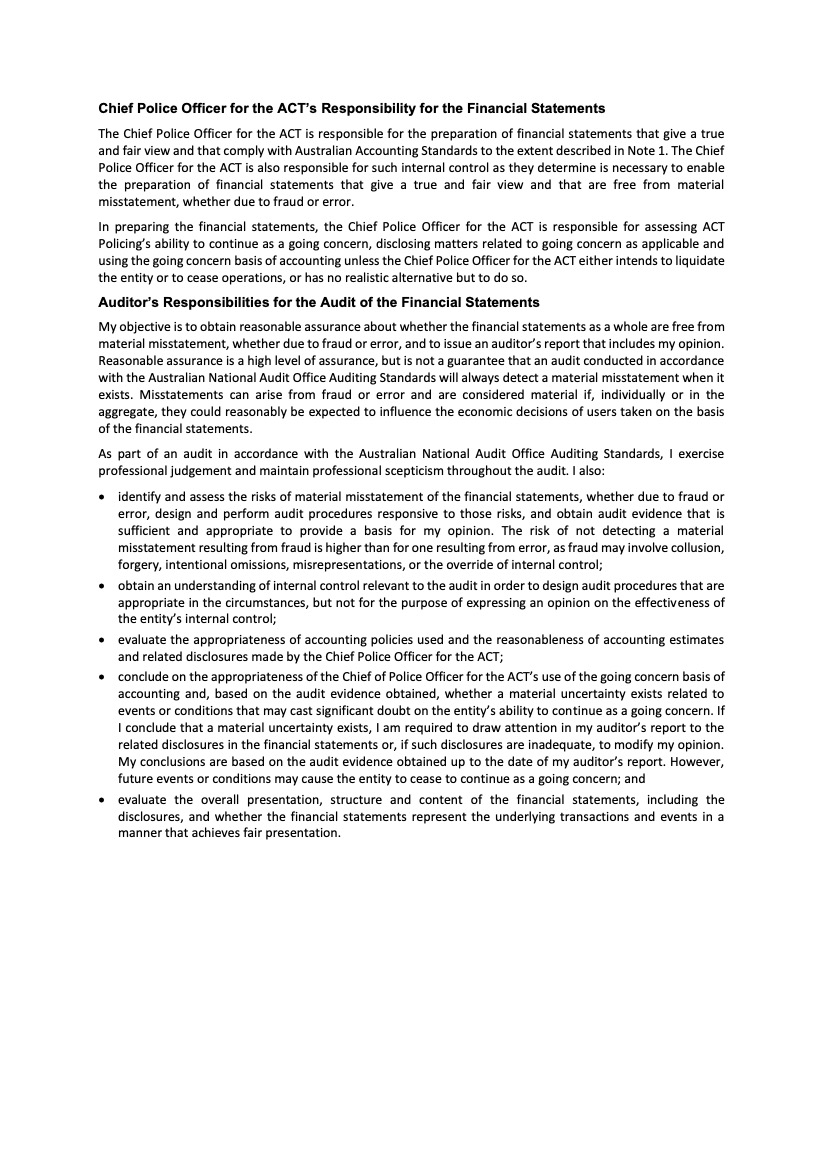
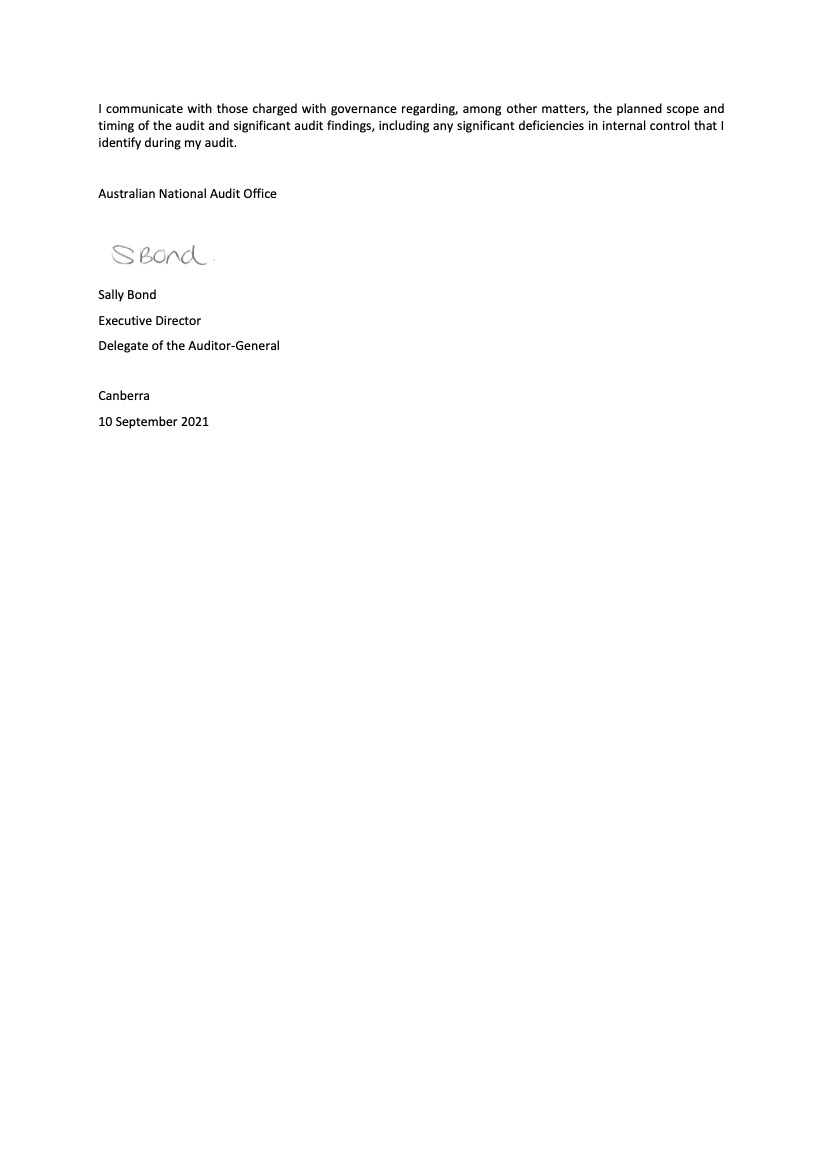
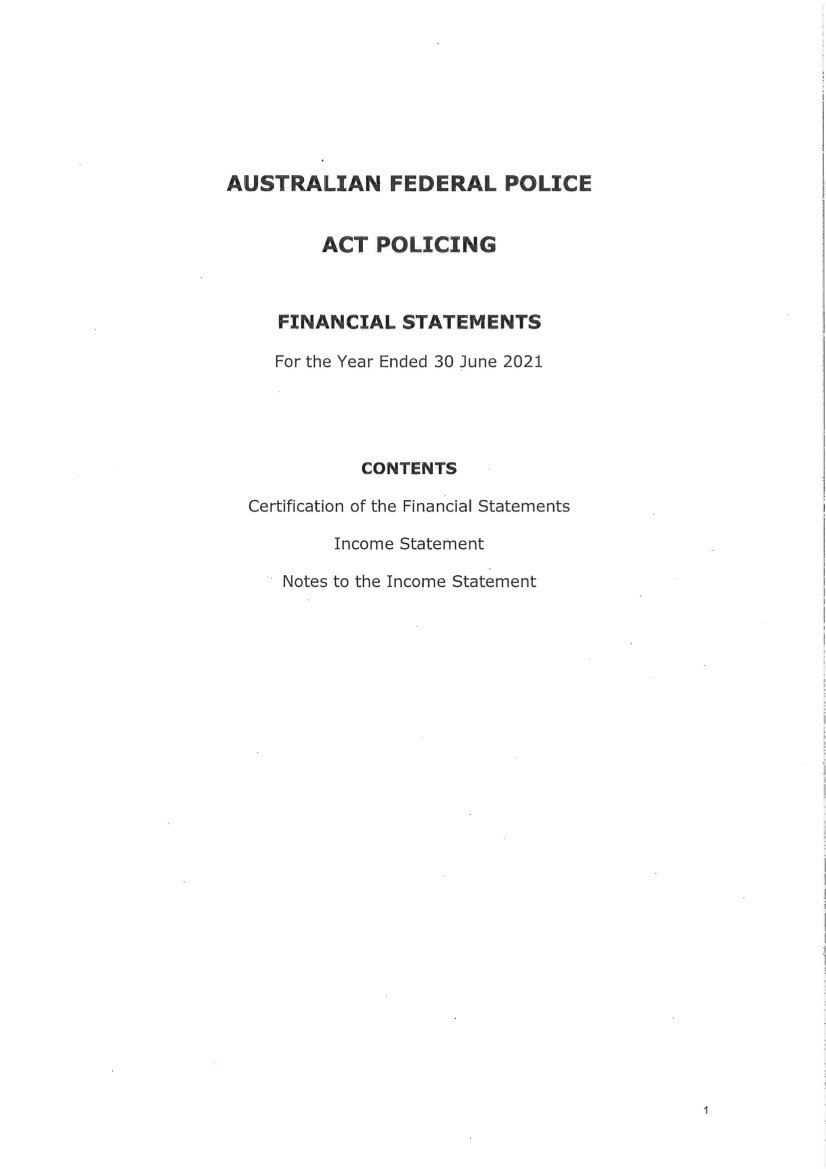
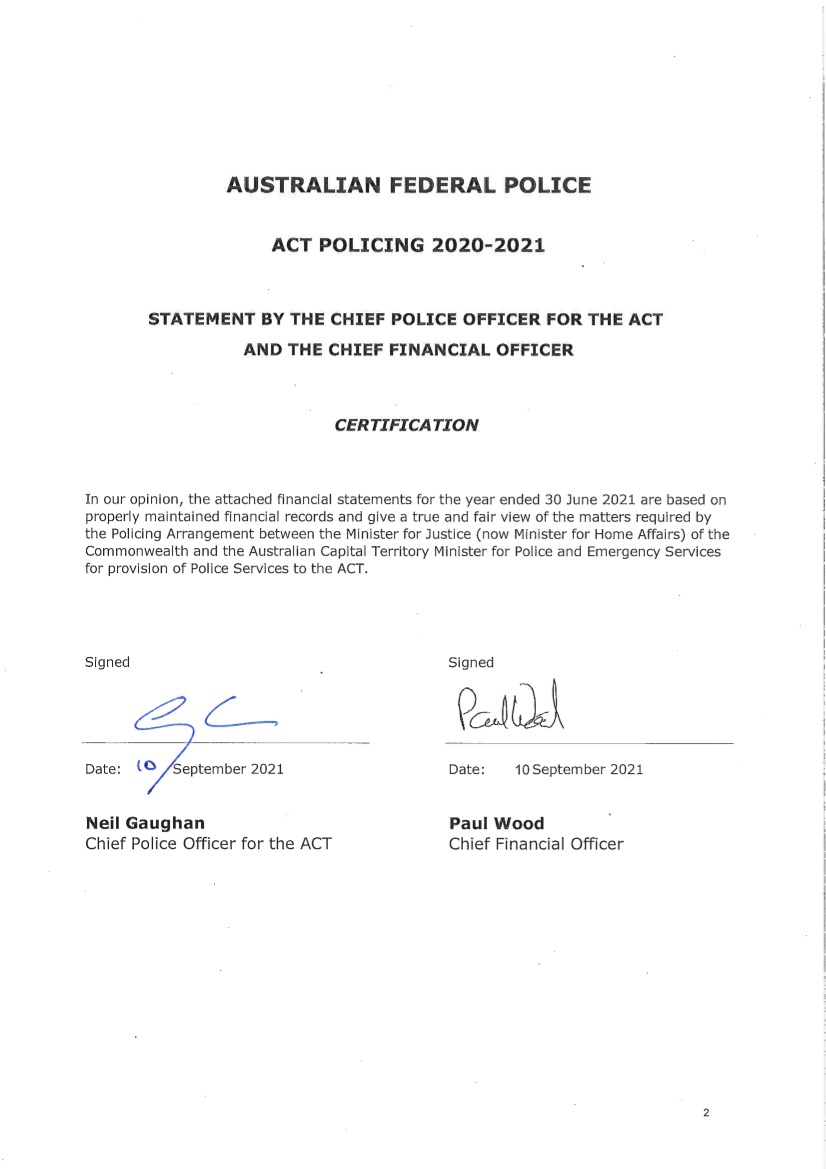
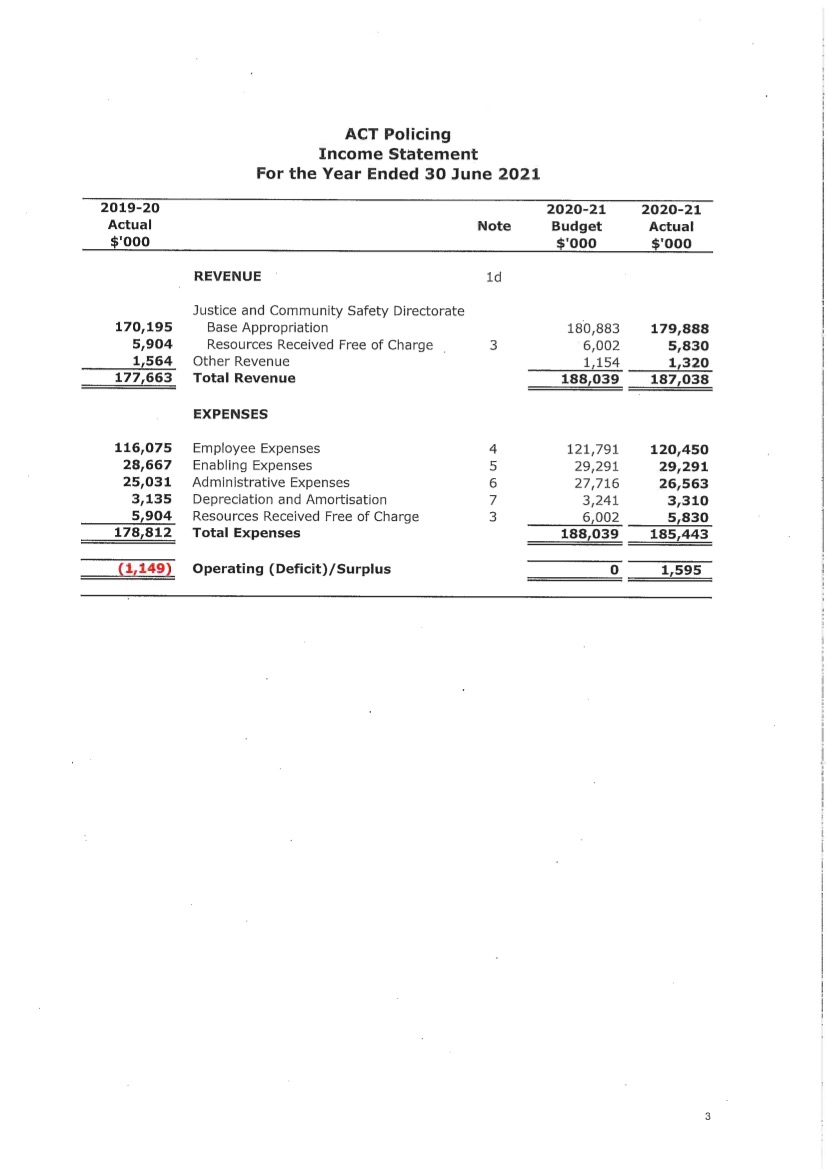
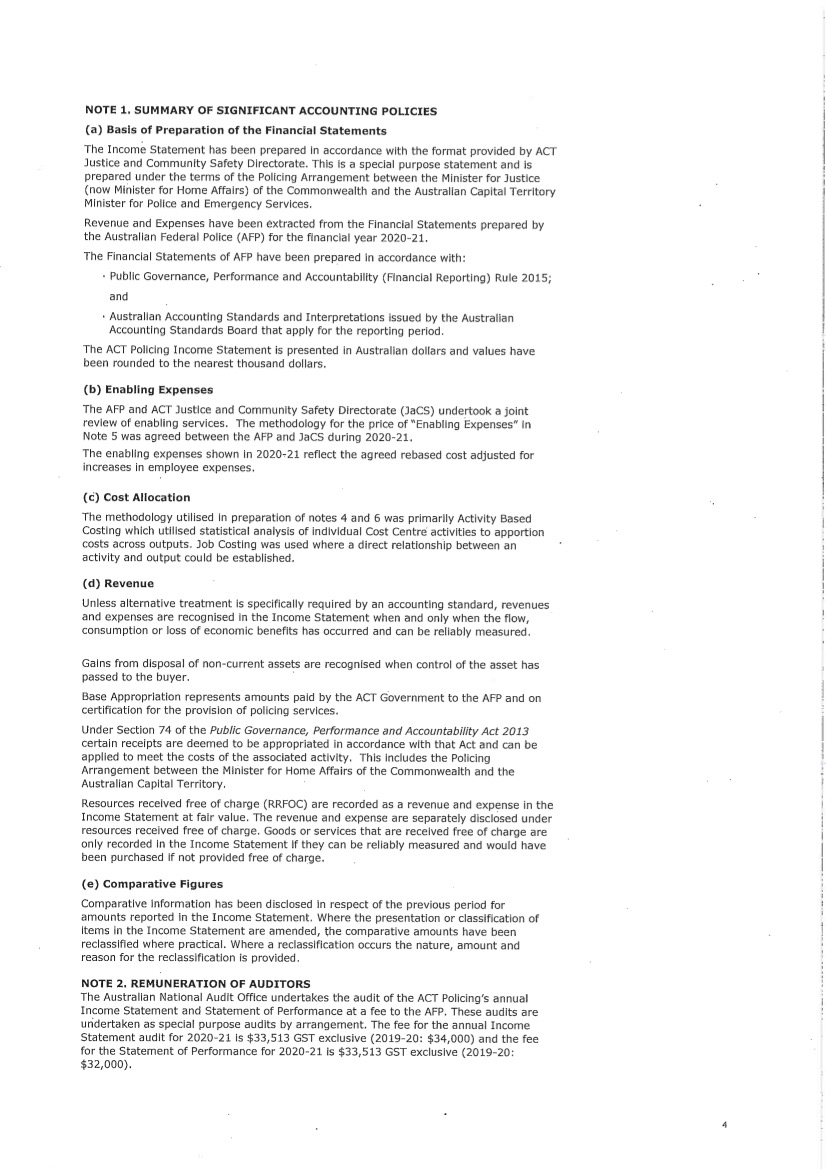
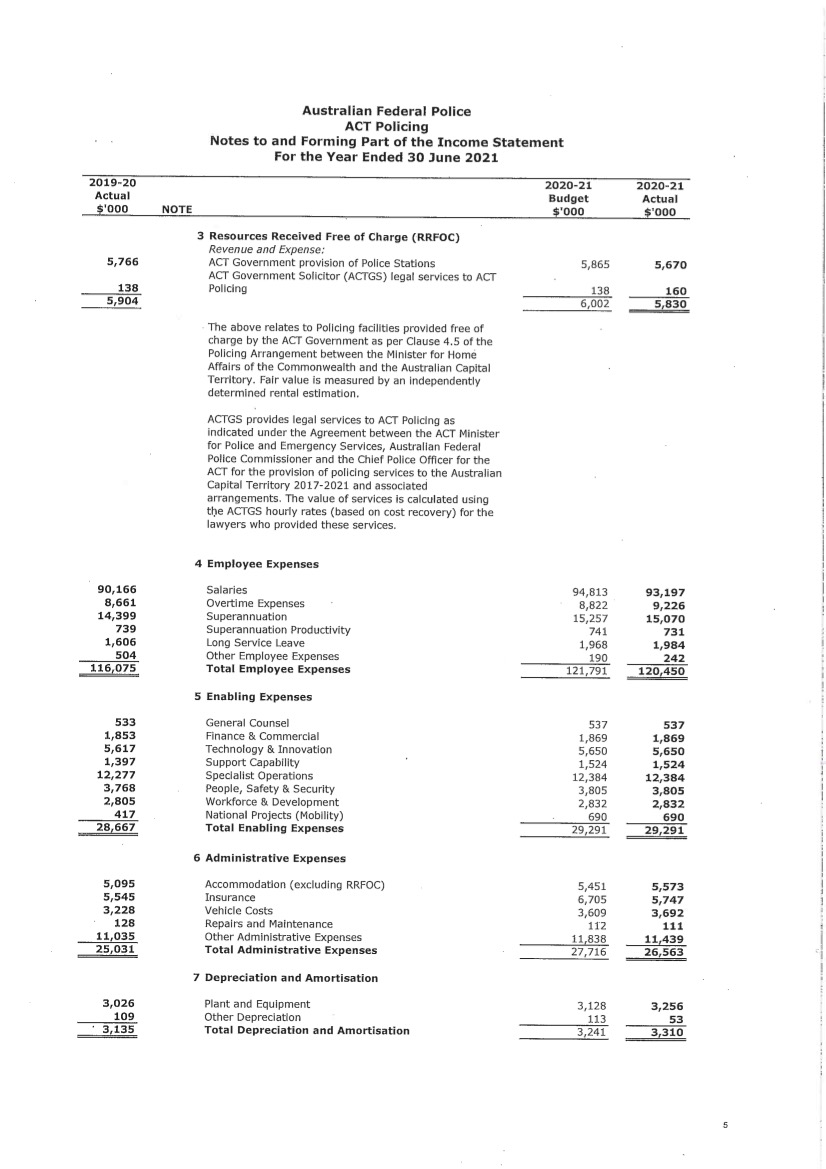
Appendix 2: Statement of Performance
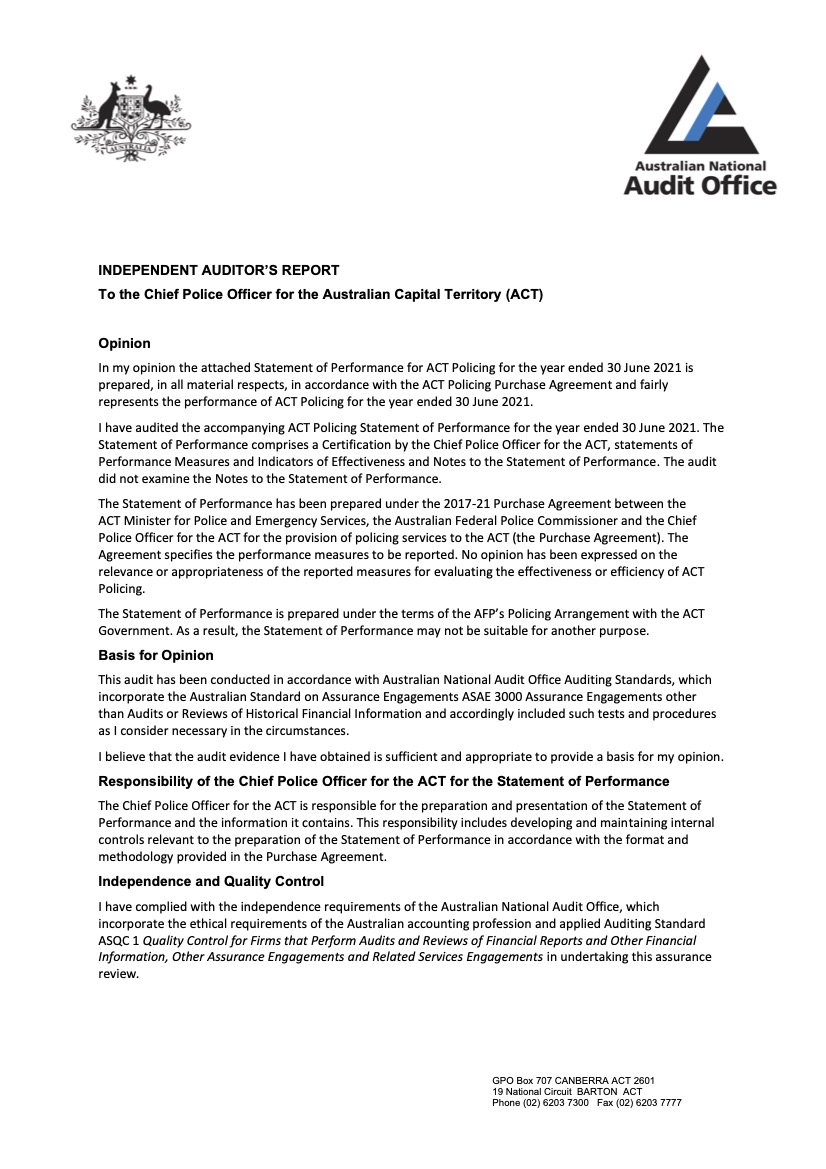
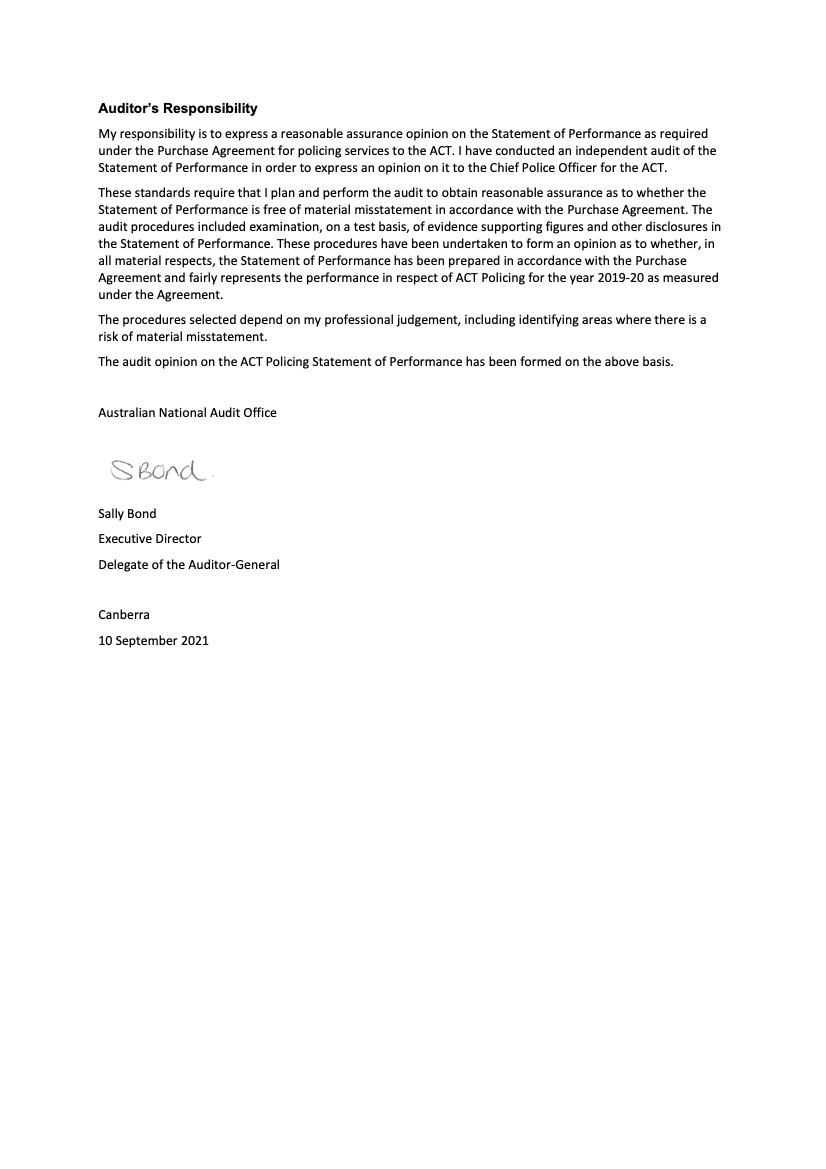
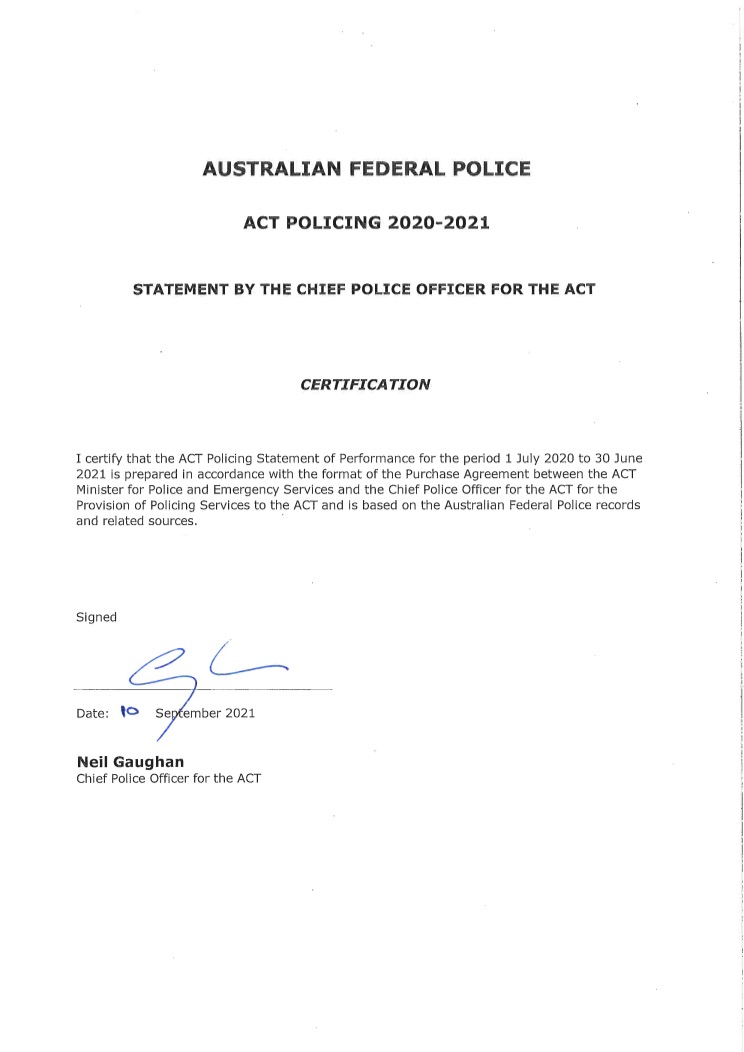
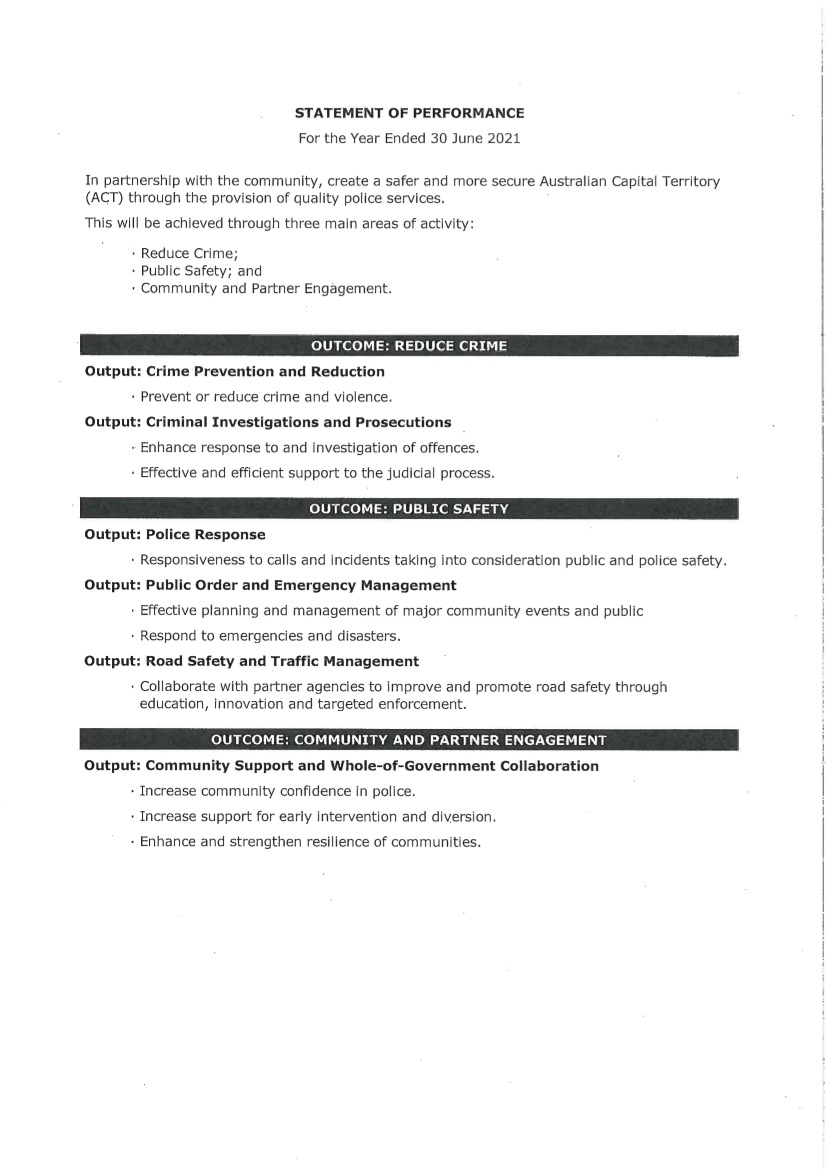
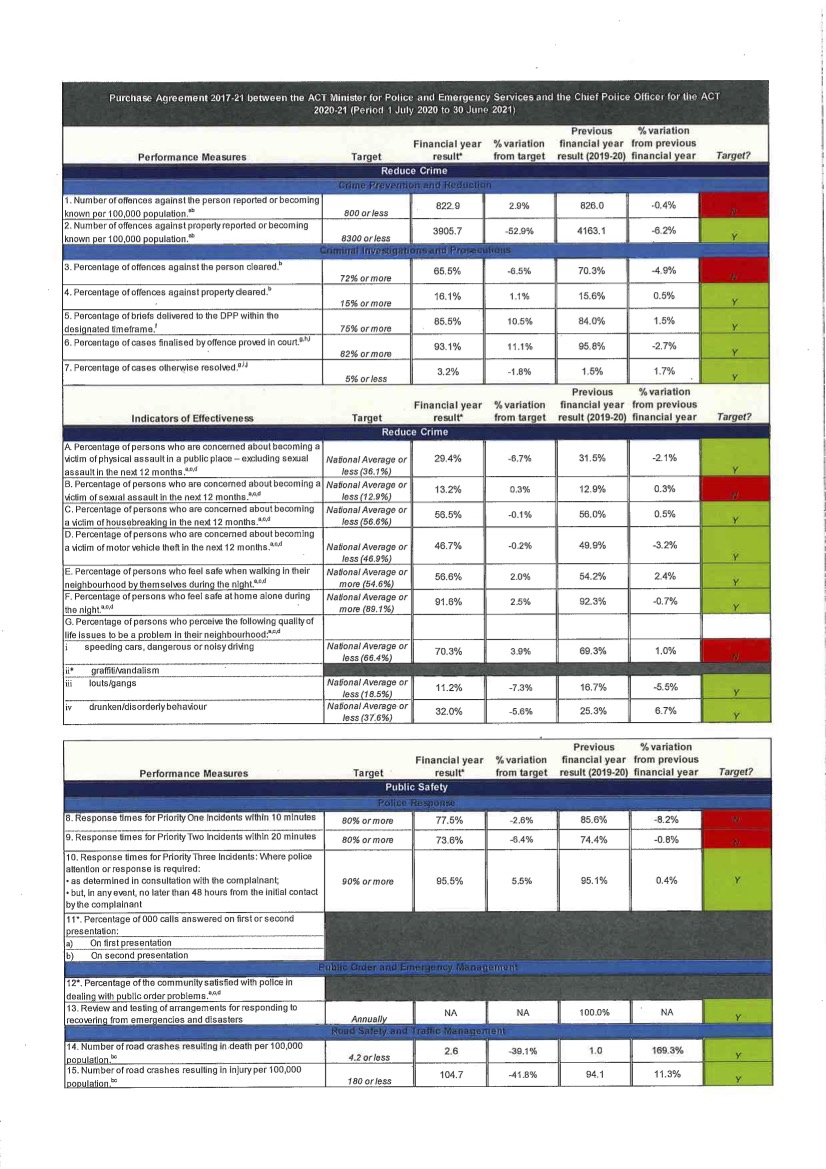
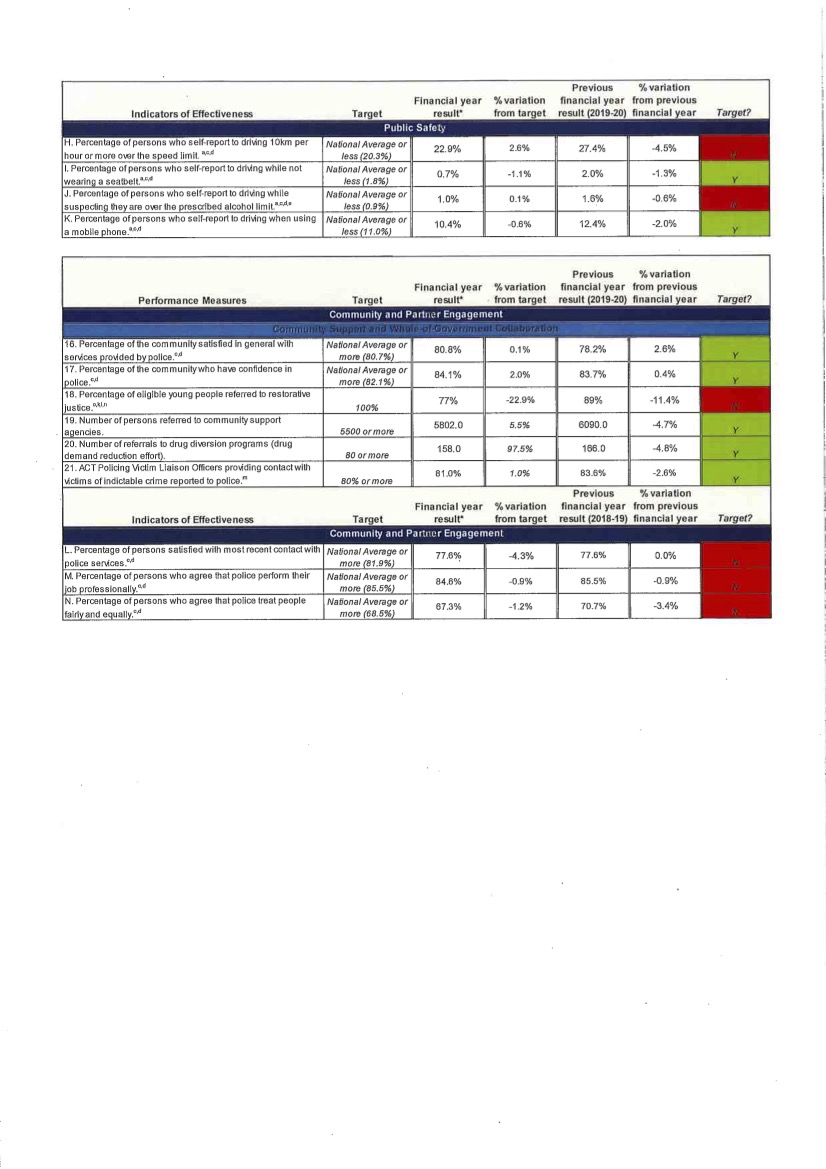
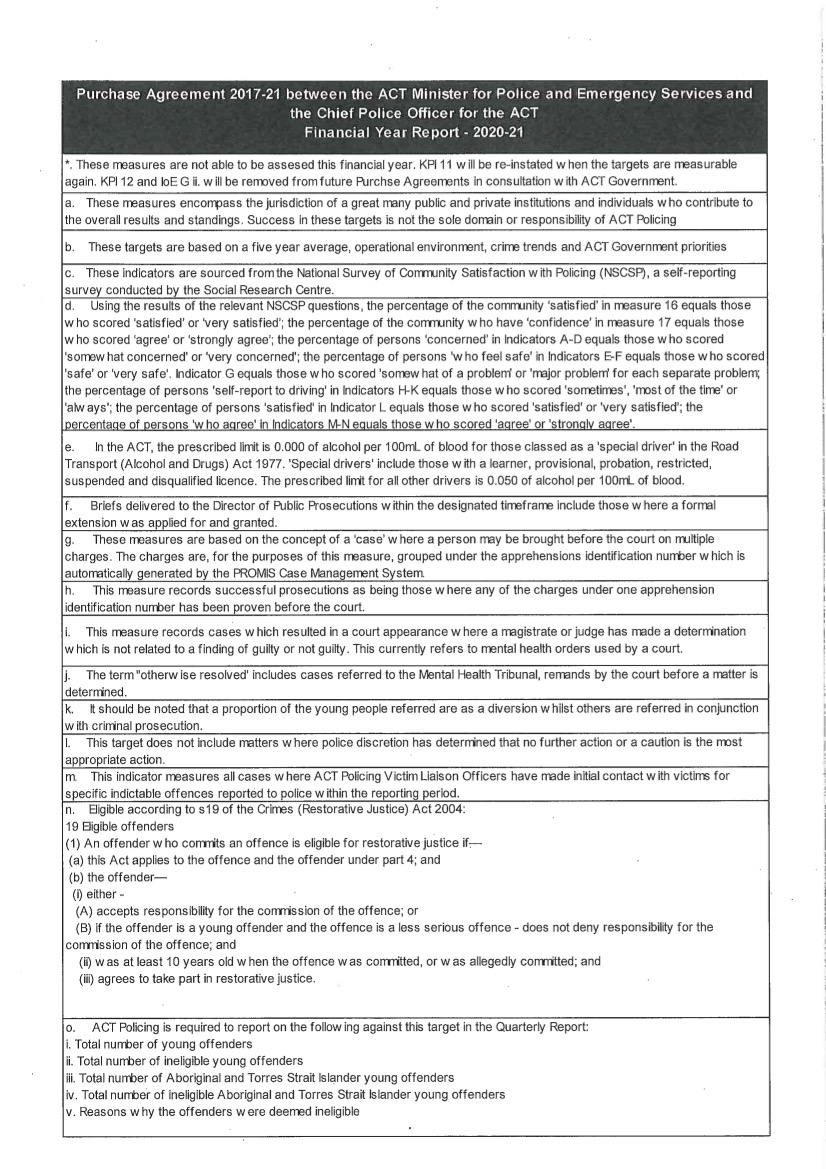

Appendix 3: Number of Offences Reported or Becoming Known in Australian Capital Territory 2016-17 to 2020-21
| Offence type | 2016-17 | 2017-18 | 2018-19 | 2019-20 | 2020-21 |
|---|---|---|---|---|---|
| OFFENCES AGAINST THE PERSON | |||||
| Murder | 1 | 3 | 1 | 2 | 5 |
| Attempted murder | 1 | 6 | 5 | 2 | 5 |
| Conspiracy to murder | - | - | - | - | 2 |
| Manslaughter | - | - | 1 | 1 | 2 |
| Driving causing death | - | 2 | 1 | 1 | 1 |
| Homicide unspecified | - | - | - | - | - |
| Total Homicide and Related offences | 2 | 11 | 8 | 6 | 15 |
| Assaults (excluding sexual) | |||||
| Assault causing GBH | 81 | 93 | 122 | 80 | 97 |
| Assault causing ABH | 472 | 433 | 448 | 453 | 511 |
| Assault other | 2,511 | 2,320 | 2,379 | 2,280 | 2,094 |
| Total Assaults (excluding sexual) | 3,064 | 2,846 | 2,949 | 2,813 | 2,702 |
| Sexual Offences | |||||
| Sexual assault 1st 2nd 3rd degree | 15 | 9 | 22 | 18 | 7 |
| Sexual intercourse, no consent | 158 | 157 | 180 | 154 | 154 |
| Sexual intercourse, person < 16 yrs | 80 | 68 | 98 | 61 | 63 |
| Indecent act, assault | 65 | 52 | 55 | 51 | 46 |
| Indecent act, no consent | 117 | 118 | 149 | 138 | 127 |
| Indecent act, person < 16 yrs | 96 | 70 | 90 | 67 | 67 |
| Incest | 10 | 3 | 16 | 11 | 4 |
| Indecent exposure | 29 | 39 | 31 | 32 | 40 |
| Total Sexual Assault Offences | 570 | 516 | 641 | 532 | 508 |
| Other Offences | |||||
| Kidnap/Abduction | 29 | 26 | 24 | 30 | 17 |
| Other offences against the person | 331 | 194 | 288 | 300 | 295 |
| Total Other Offences | 360 | 220 | 312 | 330 | 312 |
| Total Offences against the Person | 3,996 | 3,593 | 3,910 | 3,681 | 3,537 |
| OFFENCES AGAINST PROPERTY | |||||
| Robbery | |||||
| Armed robbery | 136 | 124 | 105 | 108 | 55 |
| Other robbery | 113 | 106 | 110 | 125 | 94 |
| Total Robbery | 249 | 230 | 215 | 233 | 149 |
| Blackmail and extortion | |||||
| Blackmail and extortion | 18 | 15 | 15 | 6 | 5 |
| Total Blackmail and Extortion | 18 | 15 | 15 | 6 | 5 |
| Burglary | |||||
| Burglary dwellings | 1,649 | 1,679 | 1,660 | 1,392 | 1,148 |
| Burglary shops | 335 | 287 | 419 | 376 | 279 |
| Burglary other | 581 | 590 | 550 | 569 | 540 |
| Total Burglary | 2,565 | 2,556 | 2,629 | 2,337 | 1,967 |
| Fraud and Misappropriation | |||||
| Fraud | 1,408 | 1,390 | 2,043 | 1,474 | 1,561 |
| Misappropriation | - | - | 1 | - | 1 |
| Counterfeiting | 32 | 60 | 40 | 20 | 16 |
| Total Fraud and Misappropriation | 1,440 | 1,450 | 2,084 | 1,494 | 1,578 |
| Handling Stolen Goods | |||||
| Receiving | 7 | 9 | 4 | 12 | 9 |
| Unlawful possession | 106 | 173 | 107 | 151 | 96 |
| Other handling stolen goods | 11 | 9 | 12 | 11 | 9 |
| Total Handling of Stolen Goods | 124 | 191 | 123 | 174 | 114 |
| Theft or Illegal use of a Vehicle | |||||
| Motor vehicle theft | 1,325 | 1,494 | 1,243 | 1,296 | 1,372 |
| Total Theft or Illegal use of a Vehicle | 1,325 | 1,494 | 1,243 | 1,296 | 1,372 |
| Other Theft | |||||
| Bicycle theft | 480 | 526 | 710 | 717 | 585 |
| Boat theft | 2 | - | 1 | 3 | - |
| Stock theft | - | 2 | - | 2 | - |
| Shop stealing | 1,336 | 1,360 | 1,224 | 1,305 | 1,031 |
| Theft at burglary - dwellings | 1,004 | 985 | 936 | 703 | 481 |
| Theft at burglary - shops | 159 | 162 | 226 | 153 | 105 |
| Theft at burglary - other | 267 | 319 | 269 | 252 | 209 |
| Other theft | 6,386 | 6,442 | 5,376 | 5,115 | 5,255 |
| Total Other Theft | 9,634 | 9,796 | 8,742 | 8,250 | 7,666 |
| Property Damage | |||||
| Arson | 212 | 230 | 232 | 214 | 148 |
| Damage at burglary - dwellings | 132 | 131 | 138 | 96 | 73 |
| Damage at burglary - shops | 37 | 36 | 60 | 40 | 21 |
| Damage at burglary - other | 58 | 69 | 60 | 72 | 42 |
| Other property damage | 4,935 | 4,179 | 4,473 | 3,826 | 3,647 |
| Total Property Damage | 5,374 | 4,645 | 4,963 | 4,248 | 3,931 |
| Environmental Offences | |||||
| Pollution | 10 | 6 | 4 | 2 | 3 |
| Flora and fauna | - | - | - | 1 | 2 |
| Other environmental offences | 4 | 7 | 4 | 4 | 2 |
| Total Environmental Offences | 14 | 13 | 8 | 7 | 7 |
| Total Offences against Property | 20,743 | 20,390 | 20,022 | 18,045 | 16,789 |
| OFFENCES AGAINST GOOD ORDER | |||||
| Government security/ operations | 103 | 67 | 137 | 86 | 53 |
| Justice procedures | 1,620 | 1,889 | 1,791 | 2,097 | 1,822 |
| Firearms and weapons | 327 | 403 | 360 | 409 | 289 |
| Other offences against good order | 1,009 | 899 | 978 | 897 | 718 |
| Total Offences against Good Order | 3,059 | 3,258 | 3,266 | 3,489 | 2,882 |
| DRUG OFENCES | |||||
| Possess and use drugs | 642 | 790 | 557 | 573 | 332 |
| Deal and supply drugs | 74 | 112 | 73 | 66 | 54 |
| Manufacture and grow drugs | 18 | 16 | 21 | 16 | 14 |
| Other drug offences | 23 | 44 | 33 | 38 | 27 |
| Total Drug Offences | 757 | 962 | 684 | 693 | 427 |
| TRAFFIC OFFENCES | |||||
| Drink driving offences | 913 | 1,026 | 1,084 | 833 | 882 |
| Drug driving offences | 454 | 736 | 941 | 805 | 685 |
| Dangerous and reckless driving | 132 | 146 | 178 | 146 | 139 |
| Driving licence offences | 929 | 933 | 949 | 1,037 | 817 |
| Other motor vehicle, traffic and related offences | 4,079 | 3,876 | 3,550 | 3,787 | 3,320 |
| Total Traffic Offences | 6,507 | 6,717 | 6,702 | 6,608 | 5,843 |
| OTHER OFFENCES NOT ELSEWHERE CLASSIFIED | |||||
| Other offences n.e.c | 148 | 229 | 125 | 455 | 233 |
| All Offences | 35,210 | 35,149 | 34,709 | 32,971 | 29,711 |
Appendix 4: Offences Cleared by ACT Policing in the Australian Capital Territory 2016-17 to 2020-21
| Offence type | 2016-17 | 2017-18 | 2018-19 | 2019-20 | 2020-21 |
|---|---|---|---|---|---|
| OFFENCES AGAINST THE PERSON | |||||
| Homicide and Related offences | |||||
| Murder | - | 5 | 2 | 1 | 3 |
| Attempted murder | 2 | 4 | 5 | 2 | 5 |
| Conspiracy to murder | - | - | - | - | - |
| Manslaughter | - | - | 1 | 1 | 1 |
| Driving causing death | - | 2 | 1 | - | 2 |
| Homicide unspecified | - | - | - | - | - |
| Total Homicide and Related offences | 2 | 11 | 9 | 4 | 11 |
| Assaults (excluding sexual) | |||||
| Assault causing GBH | 63 | 70 | 98 | 64 | 72 |
| Assault causing ABH | 308 | 316 | 298 | 294 | 319 |
| Assault other | 1,913 | 1,776 | 1,672 | 1,572 | 1,380 |
| Total Assaults (excluding sexual) | 2,284 | 2,162 | 2,068 | 1,930 | 1,771 |
| Sexual Offences | |||||
| Sexual assault 1st 2nd 3rd degree | 11 | 10 | 14 | 10 | 8 |
| Sexual intercourse, no consent | 97 | 118 | 126 | 100 | 98 |
| Sexual intercourse, person < 16 yrs | 75 | 5 | 60 | 55 | 53 |
| Indecent act, assault | 32 | 45 | 27 | 28 | 28 |
| Indecent act, no consent | 68 | 89 | 87 | 89 | 83 |
| Indecent act, person < 16 yrs | 80 | 64 | 74 | 47 | 47 |
| Incest | 5 | 7 | 10 | 8 | 5 |
| Indecent exposure | 4 | 21 | 17 | 14 | 20 |
| Total Sexual Assault Offences | 372 | 429 | 415 | 351 | 342 |
| Other Offences | |||||
| Kidnap/Abduction | 29 | 21 | 17 | 26 | 15 |
| Other offences against the person | 196 | 131 | 175 | 187 | 177 |
| Total Other Offences | 225 | 152 | 192 | 213 | 192 |
| Total Offences against the Person | 2,883 | 2,754 | 2,684 | 2,498 | 2,316 |
| OFFENCES AGAINST PROPERTY | |||||
| Robbery | |||||
| Armed robbery | 34 | 51 | 58 | 37 | 22 |
| Other robbery | 40 | 41 | 36 | 48 | 47 |
| Total Robbery | 74 | 92 | 94 | 85 | 69 |
| Blackmail and extortion | |||||
| Blackmail and extortion | 11 | 2 | 1 | 6 | 3 |
| Total Blackmail and Extortion | 11 | 2 | 1 | 6 | 3 |
| Burglary | |||||
| Burglary dwellings | 127 | 183 | 157 | 146 | 144 |
| Burglary shops | 29 | 31 | 44 | 19 | 27 |
| Burglary other | 32 | 64 | 61 | 59 | 46 |
| Total Burglary | 188 | 278 | 262 | 224 | 217 |
| Fraud and Misappropriation | |||||
| Fraud | 504 | 691 | 438 | 613 | 732 |
| Misappropriation | - | - | 1 | - | - |
| Counterfeiting | 1 | 26 | 1 | 4 | 2 |
| Total Fraud and Misappropriation | 505 | 717 | 440 | 617 | 734 |
| Handling Stolen Goods | |||||
| Receiving | 4 | 15 | 2 | 9 | 11 |
| Unlawful possession | 84 | 155 | 81 | 126 | 72 |
| Other handling stolen goods | 8 | 5 | 12 | 9 | 7 |
| Total Handling of Stolen Goods | 96 | 175 | 95 | 144 | 90 |
| Theft or Illegal use of a Vehicle | |||||
| Motor vehicle theft | 150 | 202 | 161 | 168 | 182 |
| Total Theft or Illegal use of a Vehicle | 150 | 202 | 161 | 168 | 182 |
| Other Theft | |||||
| Bicycle theft | 15 | 13 | 15 | 9 | 7 |
| Boat theft | - | - | - | - | - |
| Stock theft | - | - | - | - | - |
| Shop stealing | 465 | 493 | 338 | 325 | 251 |
| Theft at burglary - dwellings | 56 | 101 | 59 | 68 | 43 |
| Theft at burglary - shops | 16 | 14 | 24 | 7 | 12 |
| Theft at burglary - other | 8 | 9 | 12 | 20 | 15 |
| Other theft | 567 | 527 | 463 | 348 | 390 |
| Total Other Theft | 1,127 | 1,157 | 911 | 777 | 718 |
| Property Damage | |||||
| Arson | 13 | 19 | 12 | 23 | 8 |
| Damage at burglary - dwellings | 25 | 19 | 34 | 8 | 27 |
| Damage at burglary - shops | 2 | 6 | 4 | - | 2 |
| Damage at burglary - other | 5 | 4 | 7 | 12 | 6 |
| Other property damage | 786 | 733 | 687 | 710 | 646 |
| Total Property Damage | 831 | 781 | 744 | 753 | 689 |
| Environmental Offences | |||||
| Pollution | 7 | 5 | 2 | 1 | - |
| Flora and fauna | - | - | - | - | 2 |
| Other environmental offences | 2 | 5 | 2 | 1 | 1 |
| Total Environmental Offences | 9 | 10 | 4 | 2 | 3 |
| Total Offences against Property | 2,991 | 3,414 | 2,712 | 2,776 | 2,705 |
| OFFENCES AGAINST GOOD ORDER | |||||
| Government security/ operations | 100 | 65 | 62 | 76 | 133 |
| Justice procedures | 1,412 | 1,649 | 1,488 | 1,778 | 1,486 |
| Firearms and weapons | 280 | 282 | 285 | 279 | 275 |
| Other offences against good order | 676 | 629 | 671 | 551 | 484 |
| Total Offences against Good Order | 2,468 | 2,625 | 2,506 | 2,684 | 2,378 |
| DRUG OFFENCES | |||||
| Possess and use drugs | 522 | 639 | 438 | 411 | 272 |
| Deal and supply drugs | 58 | 85 | 89 | 40 | 51 |
| Manufacture and grow drugs | 15 | 10 | 12 | 7 | 8 |
| Other drug offences | 6 | 11 | 9 | 7 | 2 |
| Total Drug Offences | 601 | 745 | 548 | 465 | 333 |
| TRAFFIC OFFENCES | |||||
| Drink driving offences | 808 | 979 | 1,027 | 758 | 822 |
| Drug driving offences | 436 | 695 | 939 | 778 | 726 |
| Dangerous and reckless driving | 97 | 99 | 129 | 105 | 97 |
| Driving licence offences | 831 | 881 | 855 | 920 | 780 |
| Other motor vehicle, traffic and related offences | 2,555 | 2,364 | 1,960 | 2,119 | 1,842 |
| Total Traffic Offences | 4,727 | 5,018 | 4,910 | 4,680 | 4,267 |
| OTHER OFFENCES NOT ELSEWHERE CLASSIFIED | |||||
| Other offences n.e.c | 45 | 79 | 56 | 100 | 103 |
| All Offences | 13,715 | 14,635 | 13,416 | 13,203 | 12,102 |
Appendix 5: Percentage of Offences Cleared by ACT Policing 2016-17 to 2020-21
| Offence type | 2016-17 | 2017-18 | 2018-19 | 2019-20 | 2020-21 |
|---|---|---|---|---|---|
| OFFENCES AGAINST THE PERSON | |||||
| Homicide and Related offences | |||||
| Murder | 0.0% | 166.7% | 200.0% | 50.0% | 60.0% |
| Attempted murder | 200.0% | 66.7% | 100.0% | 100.0% | 100.0% |
| Conspiracy to murder | 0.0% | 0.0% | 0.0% | 0.0% | 0.0% |
| Manslaughter | 0.0% | 0.0% | 100.0% | 100.0% | 50.0% |
| Driving causing death | 0.0% | 100.0% | 100.0% | 0.0% | 200.0% |
| Homicide unspecified | 0.0% | 0.0% | 0.0% | 0.0% | 0.0% |
| Total Homicide and Related offences | 100.0% | 100.0% | 112.5% | 66.7% | 73.3% |
| Assaults (excluding sexual) | |||||
| Assault causing GBH | 77.8% | 75.3% | 80.3% | 80.0% | 74.2% |
| Assault causing ABH | 65.3% | 73.0% | 66.5% | 64.9% | 62.4% |
| Assault other | 76.2% | 76.6% | 70.3% | 68.9% | 65.9% |
| Total Assaults (excluding sexual) | 74.5% | 76.0% | 70.1% | 68.6% | 65.5% |
| Sexual Offences | |||||
| Sexual assault 1st 2nd 3rd degree | 73.3% | 111.1% | 63.6% | 55.6% | 114.3% |
| Sexual intercourse, no consent | 61.4% | 75.2% | 70.0% | 64.9% | 63.6% |
| Sexual intercourse, person < 16 yrs | 93.8% | 110.3% | 61.2% | 90.2% | 84.1% |
| Indecent act, assault | 49.2% | 86.5% | 49.1% | 54.9% | 60.9% |
| Indecent act, no consent | 58.1% | 75.4% | 58.4% | 64.5% | 65.4% |
| Indecent act, person < 16 yrs | 83.3% | 91.4% | 82.2% | 70.1% | 70.1% |
| Incest | 50.0% | 233.3% | 62.5% | 72.7% | 125.0% |
| Indecent exposure | 13.8% | 53.8% | 54.8% | 43.8% | 50.0% |
| Total Sexual Assault Offences | 65.3% | 83.1% | 64.7% | 66.0% | 67.3% |
| Other Offences | |||||
| Kidnap/Abduction | 100.0% | 80.8% | 70.8% | 86.7% | 88.2% |
| Other offences against the person | 59.2% | 67.5% | 60.8% | 62.3% | 60.0% |
| Total Other Offences | 62.5% | 69.1% | 61.5% | 64.5% | 61.5% |
| Total Offences against the Person | 72.1% | 76.6% | 68.6% | 67.9% | 65.5% |
| OFFENCES AGAINST PROPERTY | |||||
| Robbery | |||||
| Armed robbery | 25.0% | 41.1% | 55.2% | 34.3% | 40.0% |
| Other robbery | 35.4% | 38.7% | 32.7% | 38.4% | 50.0% |
| Total Robbery | 29.7% | 40.0% | 43.7% | 36.5% | 46.3% |
| Blackmail and extortion | |||||
| Blackmail and extortion | 61.1% | 13.3% | 6.7% | 100.0% | 60.0% |
| Total Blackmail and Extortion | 61.1% | 13.3% | 6.7% | 100.0% | 60.0% |
| Burglary | |||||
| Burglary dwellings | 7.7% | 10.9% | 9.5% | 10.5% | 12.5% |
| Burglary shops | 8.7% | 10.8% | 10.5% | 5.1% | 9.7% |
| Burglary other | 5.5% | 10.8% | 11.1% | 10.4% | 8.5% |
| Total Burglary | 7.3% | 10.9% | 10.0% | 9.6% | 11.0% |
| Fraud and Misappropriation | |||||
| Fraud | 35.8% | 49.7% | 21.4% | 41.6% | 46.9% |
| Misappropriation | 0.0% | 0.0% | 100.0% | 0.0% | 0.0% |
| Counterfeiting | 3.1% | 43.3% | 2.5% | 20.0% | 12.5% |
| Total Fraud and Misappropriation | 35.1% | 49.4% | 21.1% | 41.3% | 46.5% |
| Handling Stolen Goods | |||||
| Receiving | 57.1% | 166.7% | 50.0% | 75.0% | 122.2% |
| Unlawful possession | 79.2% | 89.6% | 75.7% | 83.4% | 75.0% |
| Other handling stolen goods | 72.7% | 55.6% | 100.0% | 81.8% | 77.8% |
| Total Handling of Stolen Goods | 77.4% | 91.6% | 77.2% | 82.8% | 78.9% |
| Theft or Illegal use of a Vehicle | |||||
| Motor vehicle theft | 11.3% | 13.5% | 13.0% | 13.0% | 13.3% |
| Total Theft or Illegal use of a Vehicle | 11.3% | 13.5% | 13.0% | 13.0% | 13.3% |
| Other Theft | |||||
| Bicycle theft | 3.1% | 2.5% | 2.1% | 1.3% | 1.2% |
| Boat theft | 0.0% | 0.0% | 0.0% | 0.0% | 0.0% |
| Stock theft | 0.0% | 0.0% | 0.0% | 0.0% | 0.0% |
| Shop stealing | 34.8% | 36.3% | 27.6% | 24.9% | 24.3% |
| Theft at burglary - dwellings | 5.6% | 10.3% | 6.3% | 9.7% | 8.9% |
| Theft at burglary - shops | 10.1% | 8.6% | 10.6% | 4.6% | 11.4% |
| Theft at burglary - other | 3.0% | 2.8% | 4.5% | 7.9% | 7.2% |
| Other theft | 8.9% | 8.2% | 8.6% | 6.8% | 7.4% |
| Total Other Theft | 11.7% | 11.8% | 10.4% | 9.4% | 9.4% |
| Property Damage | |||||
| Arson | 6.1% | 8.3% | 5.2% | 10.7% | 5.4% |
| Damage at burglary - dwellings | 18.9% | 14.5% | 24.6% | 8.3% | 37.0% |
| Damage at burglary - shops | 5.4% | 16.7% | 6.7% | 0.0% | 9.5% |
| Damage at burglary - other | 8.6% | 5.8% | 11.7% | 16.7% | 14.3% |
| Other property damage | 15.9% | 17.5% | 15.4% | 18.6% | 17.7% |
| Total Property Damage | 15.5% | 16.8% | 15.0% | 17.7% | 17.5% |
| Environmental Offences | |||||
| Pollution | 70.0% | 83.3% | 50.0% | 50.0% | 0.0% |
| Flora and fauna | 0.0% | 0.0% | 0.0% | 0.0% | 100.0% |
| Other environmental offences | 50.0% | 71.4% | 50.0% | 25.0% | 50.0% |
| Total Environmental Offences | 64.3% | 76.9% | 50.0% | 28.6% | 42.9% |
| Total Offences against Property | 14.4% | 16.7% | 13.5% | 15.4% | 16.1% |
| OFFENCES AGAINST GOOD ORDER | |||||
| Government security/ operations | 97.1% | 97.0% | 45.3% | 88.4% | 250.9% |
| Justice procedures | 87.2% | 87.3% | 83.1% | 84.8% | 81.6% |
| Firearms and weapons | 85.6% | 70.0% | 79.2% | 68.2% | 95.2% |
| Other offences against good order | 67.0% | 70.0% | 68.6% | 61.4% | 67.4% |
| Total Offences against Good Order | 80.7% | 80.6% | 76.7% | 76.9% | 82.5% |
| DRUG OFFENCES | |||||
| Possess and use drugs | 81.3% | 80.9% | 78.6% | 71.7% | 81.9% |
| Deal and supply drugs | 78.4% | 75.9% | 121.9% | 60.6% | 94.4% |
| Manufacture and grow drugs | 83.3% | 62.5% | 57.1% | 43.8% | 57.1% |
| Total Drug Offences | 79.4% | 77.4% | 80.1% | 67.1% | 78.0% |
| TRAFFIC OFFENCES | |||||
| Drink driving offences | 88.5% | 95.4% | 94.7% | 91.0% | 93.2% |
| Drug driving offences | 96.0% | 94.4% | 99.8% | 96.6% | 106.0% |
| Dangerous and reckless driving | 73.5% | 67.8% | 72.5% | 71.9% | 69.8% |
| Driving licence offences | 89.5% | 94.4% | 90.1% | 88.7% | 95.5% |
| Other motor vehicle, traffic and related offences | 62.6% | 61.0% | 55.2% | 56.0% | 55.5% |
| Total Traffic Offences | 72.6% | 74.7% | 73.3% | 70.8% | 73.0% |
| OTHER OFFENCES NOT ELSEWHERE CLASSIFIED | |||||
| Other offences n.e.c | 30.4% | 34.5% | 44.8% | 22.0% | 44.2% |
| All Offences | 39.0% | 41.6% | 38.7% | 40.0% | 40.7% |
Appendix 6: Proceedings Against Offenders by ACT Policing (Charges) 2016-17 to 2020-21
| Offence type | 2016-17 | 2017-18 | 2018-19 | 2019-20 | 2020-21 |
|---|---|---|---|---|---|
| OFFENCES AGAINST GOOD ORDER | |||||
| Homicide and Related offences | |||||
| Murder | 2 | 7 | 5 | 1 | 4 |
| Attempted murder | 2 | 4 | 10 | - | 8 |
| Conspiracy to murder | - | - | - | - | 5 |
| Manslaughter | - | - | 1 | 1 | 2 |
| Driving causing death | 1 | 3 | 1 | - | 2 |
| Homicide unspecified | - | - | - | - | 1 |
| Total Homicide and Related offences | 5 | 14 | 17 | 2 | 22 |
| Assaults (excluding sexual) | |||||
| Assault causing GBH | 102 | 128 | 169 | 151 | 139 |
| Assault causing ABH | 303 | 316 | 325 | 330 | 324 |
| Assault other | 1,044 | 974 | 953 | 1,024 | 833 |
| Total Assaults (excluding sexual) | 1,449 | 1,418 | 1,447 | 1,505 | 1,296 |
| Sexual Offences | |||||
| Sexual assault 1st 2nd 3rd degree | 25 | 7 | 20 | 33 | 30 |
| Sexual intercourse, no consent | 32 | 27 | 23 | 24 | 17 |
| Sexual intercourse, person < 16 yrs | 40 | 35 | 48 | 75 | 19 |
| Indecent act, assault | 2 | 2 | - | 2 | - |
| Indecent act, no consent | 66 | 91 | 93 | 61 | 88 |
| Indecent act, person < 16 yrs | 73 | 53 | 48 | 34 | 25 |
| Incest | 13 | 1 | 14 | 1 | 8 |
| Indecent exposure | 1 | - | - | - | - |
| Total Sexual Assault Offences | 252 | 216 | 246 | 230 | 187 |
| Other Offences | |||||
| Kidnap/Abduction | 46 | 28 | 30 | 27 | 22 |
| Other offences against the person | 240 | 202 | 226 | 253 | 254 |
| Total Other Offences | 286 | 230 | 256 | 280 | 276 |
| Total Offences against the Person | 1,992 | 1,878 | 1,966 | 2,017 | 1,781 |
| OFFENCES AGAINST PROPERTY | |||||
| Robbery | |||||
| Armed robbery | 54 | 55 | 99 | 56 | 36 |
| Other robbery | 90 | 86 | 60 | 73 | 49 |
| Total Robbery | 144 | 141 | 159 | 129 | 85 |
| Blackmail and extortion | |||||
| Blackmail and extortion | 18 | 5 | 8 | 2 | 5 |
| Total Blackmail and Extortion | 18 | 5 | 8 | 2 | 5 |
| Burglary | |||||
| Burglary dwellings | 129 | 194 | 195 | 152 | 139 |
| Burglary shops | 39 | 46 | 51 | 69 | 37 |
| Burglary other | 59 | 108 | 120 | 124 | 70 |
| Total Burglary | 227 | 348 | 366 | 345 | 246 |
| Fraud and Misappropriation | |||||
| Fraud | 837 | 704 | 347 | 894 | 612 |
| Misappropriation | - | - | - | - | - |
| Counterfeiting | 2 | - | 1 | 6 | 2 |
| Total Fraud and Misappropriation | 839 | 704 | 348 | 900 | 614 |
| Handling Stolen Goods | |||||
| Receiving | 25 | 35 | 14 | 30 | 20 |
| Unlawful possession | 263 | 294 | 183 | 363 | 258 |
| Other handling stolen goods | 4 | 11 | 4 | - | 1 |
| Total Handling of Stolen Goods | 292 | 340 | 201 | 393 | 279 |
| Theft or Illegal use of a Vehicle | |||||
| Motor vehicle theft | 215 | 299 | 321 | 291 | 274 |
| Total Theft or Illegal use of a Vehicle | 215 | 299 | 321 | 291 | 274 |
| Other Theft | |||||
| Bicycle theft | 12 | 10 | 15 | 21 | 9 |
| Boat theft | - | - | - | - | - |
| Stock theft | - | - | - | - | - |
| Shop stealing | 285 | 241 | 266 | 265 | 235 |
| Theft at burglary - dwellings | 64 | 87 | 77 | 159 | 61 |
| Theft at burglary - shops | 16 | 13 | 27 | 27 | 17 |
| Other theft | 462 | 299 | 245 | 455 | 301 |
| Total Other Theft | 847 | 673 | 667 | 987 | 638 |
| Property Damage | |||||
| Arson | 10 | 23 | 25 | 25 | 13 |
| Damage at burglary - dwellings | 34 | 37 | 57 | 87 | 61 |
| Arson | 10 | 23 | 25 | 25 | 13 |
| Damage at burglary - dwellings | 34 | 37 | 57 | 87 | 61 |
| Damage at burglary - shops | 7 | 6 | 16 | 26 | 5 |
| Damage at burglary - other | 20 | 18 | 44 | 31 | 10 |
| Damage at burglary - shops | 7 | 6 | 16 | 26 | 5 |
| Damage at burglary - other | 20 | 18 | 44 | 31 | 10 |
| Other property damage | 536 | 538 | 562 | 521 | 484 |
| Total Property Damage | 607 | 622 | 704 | 690 | 573 |
| Environmental Offences | |||||
| Pollution | 4 | 4 | - | - | 2 |
| Flora and fauna | - | 1 | - | 3 | 1 |
| Other environmental offences | 1 | 1 | 2 | 2 | - |
| Total Environmental Offences | 5 | 6 | 2 | 5 | 3 |
| Total Offences against Property | 3,194 | 3,138 | 2,776 | 3,742 | 2,717 |
| OFFENCES AGAINST GOOD ORDER | |||||
| Government security/ operations | 216 | 184 | 114 | 270 | 126 |
| Justice procedures | 2,141 | 2,455 | 2,409 | 2,778 | 2,583 |
| Total Offences against Good Order | 3,317 | 3,635 | 3,611 | 4,177 | 3,629 |
| DRUG OFFENCES | |||||
| Possess and use drugs | 650 | 729 | 532 | 505 | 307 |
| Deal and supply drugs | 137 | 250 | 168 | 83 | 74 |
| Manufacture and grow drugs | 31 | 22 | 33 | 12 | 19 |
| Other drug offences | 1 | 1 | 1 | - | 4 |
| Total Drug Offences | 819 | 1,002 | 734 | 600 | 404 |
| TRAFFIC OFFENCES | |||||
| Drink driving offences | 921 | 1,061 | 1,157 | 878 | 946 |
| Drug driving offences | 637 | 816 | 1,022 | 876 | 784 |
| Dangerous and reckless driving | 120 | 162 | 160 | 177 | 169 |
| Driving licence offences | 1,246 | 1,257 | 1,223 | 1,271 | 1,152 |
| Other motor vehicle, traffic and related offences | 1,502 | 1,429 | 1,335 | 1,393 | 1,261 |
| Total Traffic Offences | 4,426 | 4,725 | 4,897 | 4,595 | 4,312 |
| OTHER OFFENCES NOT ELSEWHERE CLASSIFIED | |||||
| Other offences n.e.c | 71 | 244 | 89 | 104 | 153 |
| All Offences | 13,819 | 14,622 | 14,073 | 15,235 | 12,996 |
Appendix 7: Abbreviations
| ACLEI | Australian Commission for Law Enforcement Integrity |
|---|---|
| ACT | Australian Capital Territory |
| ADF | Australian Defence Force |
| AFP | Australian Federal Police |
| ANPR | Automated Number Plate Recognition |
| BPG | Better Practice Guide |
| CBRN | Chemical Biological Radiological and Nuclear |
| CEW | conducted electrical weapon |
| CKK | Constable Kenny Koala |
| CO3 | AFP Commissioner’s Order 3 |
| CPO | Chief Police Officer |
| Cth | Commonwealth |
| CYPS | Child and Youth Protection Service |
| DBF | Delivering Better Facilities program |
| DPP | Director of Public Prosecutions |
| DVCS | Domestic Violence Crisis Service |
| ESA | Emergency Services Agency |
| FIW | First Instance Warrant |
| FTE | Full-Time Equivalent |
| FVO | Family Violence Order |
| HVAC | heating, ventilation and air-conditioning |
| IoE | Indicators of Effectiveness |
| JaCS | Justice and Community Safety Directorate |
| KPI | Key Performance Indicator |
| NSCSP | National Survey of Community Satisfaction with Policing |
| NSW | New South Wales |
| PACER | Police, Ambulance and Clinician Early Response |
| PIDT | Proactive Intervention and Diversion Teams |
| PROMIS | ACT Policing’s case management system |
| PSM | Police Services Model |
| PSO | Protective Services Officer |
| RJ | Restorative Justice |
| RR25by25 | Reducing Recidivism by 25 per cent by 2025 Policy |
| SAR team | Search and Rescue team |
| SES | State Emergency Service |
| SPS | Specialist Protection Services |
| TCCS | Transport Canberra and City Services |
| TOC | Traffic Operations Centre |
| VLO | Victim Liaison Officer |
 Translate
Translate
